Shopping? Try:



 |

 |
Digital Photography News Archive!
September 2000
Back to current
news Back to Archive Index
Back to Archive Index
Saturday, September 30, 2000
DPReview posts E-100RS preview!
By Michael Tomkins, The Imaging Resource
(Saturday, September 30, 2000 - 18:29 EDT)
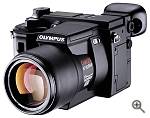 Our friends over at the Digital Photography Review website have now posted a preview of Olympus' upcoming E-100RS digital camera. The Olympus E-100RS first look doesn't attempt to draw conclusions yet since this speedy 1.5 megapixel camera with a burst-mode rate of 15 frames per second is a preproduction unit and hence can't really be judged on image quality or functionality. There are two pages of information on the camera layout and controls, along with a sample page with several images from the E-100RS. As with the E-10 preview we mentioned previously however, bear in mind when judging the samples that there's likely to be a significant difference between these and images from the final camera! Our friends over at the Digital Photography Review website have now posted a preview of Olympus' upcoming E-100RS digital camera. The Olympus E-100RS first look doesn't attempt to draw conclusions yet since this speedy 1.5 megapixel camera with a burst-mode rate of 15 frames per second is a preproduction unit and hence can't really be judged on image quality or functionality. There are two pages of information on the camera layout and controls, along with a sample page with several images from the E-100RS. As with the E-10 preview we mentioned previously however, bear in mind when judging the samples that there's likely to be a significant difference between these and images from the final camera!
Source: Digital Photography Review Olympus E-100RS preview

Friday, September 29, 2000
Pistols at dawn - Fuji S1 Pro vs. Nikon D1! :)
By Michael Tomkins, The Imaging Resource
(Friday, September 29, 2000 - 17:40 EDT)
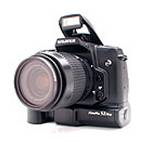 Mike Chaney, the man behind the superb Qimage Pro photo-printing software (a program we often use ourselves) has posted a long look at Nikon's D1 and Fuji's S1 Pro digital cameras, along with a number of sample images from each to allow (as much as is possible) a direct comparison of image quality. Mike Chaney, the man behind the superb Qimage Pro photo-printing software (a program we often use ourselves) has posted a long look at Nikon's D1 and Fuji's S1 Pro digital cameras, along with a number of sample images from each to allow (as much as is possible) a direct comparison of image quality.
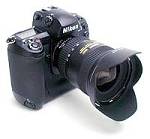 Mike concludes that whilst the S1 Pro definitely wins on "out of the camera" image quality, the D1 still reigns supreme in every other way. As he notes in comparing the two, each will appeal to different photographers based on how the camera will be used. If you're considering either, or you just want to find out what a few thousand dollars will get you, be sure and check out the full comparison! Mike concludes that whilst the S1 Pro definitely wins on "out of the camera" image quality, the D1 still reigns supreme in every other way. As he notes in comparing the two, each will appeal to different photographers based on how the camera will be used. If you're considering either, or you just want to find out what a few thousand dollars will get you, be sure and check out the full comparison!
Source: Mike Chaney's Fuji S1 Pro vs. Nikon D1 article

Digital Now develops speedy dry-processing for film!
By Michael Tomkins, The Imaging Resource
(Friday, September 29, 2000 - 16:34 EDT)
 An extremely interesting news item we spotted from CNET.com previews a new technology from Virginia-based Digital Now. The company's P-Scan Dry Film technology promises some of the benefits of digital imaging, such as sharing photos over the Internet, but without the need to wait long periods for film to be developed and scanned. The technology also promises to be more environmentally friendly than existing film processing methods, CNET noting that in fact the process is chemical-free... An extremely interesting news item we spotted from CNET.com previews a new technology from Virginia-based Digital Now. The company's P-Scan Dry Film technology promises some of the benefits of digital imaging, such as sharing photos over the Internet, but without the need to wait long periods for film to be developed and scanned. The technology also promises to be more environmentally friendly than existing film processing methods, CNET noting that in fact the process is chemical-free...
The technology is still being tested, but apparently Digital Now envisions a network of photo kiosks - insert your roll of film into the kiosk, select whether you want prints, scans, or both, and finally enter a street address for prints to be delivered to if necessary. Wait two minutes, and the film is processed by coating it with a paste which is heated, then cooled before the film is scanned. Interesting stuff, but the proof will be in the final result - if the execution is good and the print quality equal with traditional film printing, this could be an attractive alternative. Particularly, if Digital Now can add the ability to see images upon processing for the user to select which are to be printed, this could be an additional bonus and cost-saving to the consumer over traditional film processing. Whilst two minutes to get film developed and scanned is certainly fast, though, it will still lack the immediacy of digital imaging ("Did the photo I just took come out OK?") and will still entail the costs of single-use film.
Source: Yahoo! News / CNET.com News and Investing

SmartMedia specification now free to developers!
By Michael Tomkins, The Imaging Resource
(Friday, September 29, 2000 - 16:10 EDT)
 Toshiba America Electronic Components Inc., aiming to turn the SmartMedia format which it developed into a 'de facto' standard, has opened its interface specification and made it available to developers free of charge. The move is designed to give the SmartMedia flash memory card format an edge as it competes for slots in the growing arenas of digital cameras, personal digital assistants and other mobile devices. Toshiba America Electronic Components Inc., aiming to turn the SmartMedia format which it developed into a 'de facto' standard, has opened its interface specification and made it available to developers free of charge. The move is designed to give the SmartMedia flash memory card format an edge as it competes for slots in the growing arenas of digital cameras, personal digital assistants and other mobile devices."We see a tremendous expansion of application needs which could best be met by the SmartMedia card," said Jackie Traeumer, senior business development manager, Flash Products, at TAEC. "We believe that making this specification easily accessible to designers will enable them to design more innovative and cost-effective products in the future as well as creating a de facto standard for the industry." Called the Smart Media Interface Library (SMIL), the interface specification is available on the Solid State Floppy Disk Card Forum Web site in both English and Japanese versions. Toshiba owns the interface specification's intellectual property but the company says that it has no intention of collecting licensing fees with the understanding that "the specification is used properly".
 The SMIL is sectioned into three areas for hardware, software and a Windows driver. The hardware section includes a VHDL description that can be used as a macrocell when manufacturers design gate arrays for the SmartMedia interface. The small-scale gate array is comprised of about 200 gates. The software section includes source code to drive the interface and to aid users in porting the code to their own firmware. The SMIL is sectioned into three areas for hardware, software and a Windows driver. The hardware section includes a VHDL description that can be used as a macrocell when manufacturers design gate arrays for the SmartMedia interface. The small-scale gate array is comprised of about 200 gates. The software section includes source code to drive the interface and to aid users in porting the code to their own firmware.
Toshiba designed SmartMedia to fill what it saw as "a need for a compact and reliable storage medium for emerging portable and handheld applications". In 1995, Toshiba introduced the 'Solid State Floppy Disk Card' (SSFDC), now called SmartMedia, which appeared on the market in 1996 with annual shipments of approximately 1.5 million units, increasing to 7.5 million units in 1999. The SSFDC Forum expects shipments to surpass 10 million units this year although, with the specification being made easily accessible, it notes that the increase in this year's shipments could be even greater.
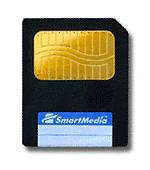 The SmartMedia card measures 37 mm x 45mm x 0.76mm and has 22 I/O pins but no controller. Toshiba notes that while some competitors criticize the card's controller-less structure, the cost-effective design has led to the format being adopted in many digital cameras. The SmartMedia card also has added an ID function for security purposes. For audio applications which manage security at the application level and require a media-card-only ID function, Toshiba feels SmartMedia cards will fulfill their needs. The SmartMedia card measures 37 mm x 45mm x 0.76mm and has 22 I/O pins but no controller. Toshiba notes that while some competitors criticize the card's controller-less structure, the cost-effective design has led to the format being adopted in many digital cameras. The SmartMedia card also has added an ID function for security purposes. For audio applications which manage security at the application level and require a media-card-only ID function, Toshiba feels SmartMedia cards will fulfill their needs.
Beyond digital still camera applications, Toshiba recommends SmartMedia for other portable applications, for example audio recorders can use the small memory card for additional audio storage whilst cellular phone and personal digital assistants for receiving digital images, e-mail and faxes. Since SmartMedia incorporates non-volatile flash memory, and therefore, requires no battery back-up, it is also suited to medical devices which provide portability between patient and physician.
Source: Yahoo! Finance / Business Wire

Steve's Digicams First Look at Finepix 40i (now shipping)!
By Michael Tomkins, The Imaging Resource
(Friday, September 29, 2000 - 13:52 EDT)
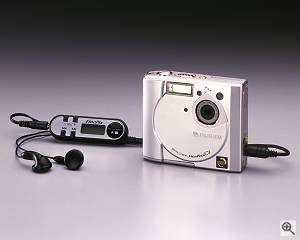
Our good friends over at the Steve's Digicams website have posted a first look review of Fuji's FinePix 40i digital camera. No conclusions drawn as yet on the camera, which features a compact design with 2.4 megapixel CCD, 35mm-equivalent fixed focal length lens, and the ability to double as an MP3 player with the included headphones, but there's plenty of information on how the camera works along with sample photos galore. Check it out!
In related news, Fuji recently announced that it was now shipping the FinePix 40i, which has an estimated street price of $699...

DPReview posts MVC-CD1000 review, E-10 preview!
By Michael Tomkins, The Imaging Resource
(Friday, September 29, 2000 - 13:29 EDT)
Our friend Phil Askey over at the Digital Photography Review has evidently been busy recently, posting not only his full review of Sony's Mavica MVC-CD1000 digital camera, but also a preview of Olympus' upcoming E-10, a 4 megapixel SLR digicam which seems to be generating a lot of interest...
 In his Mavica MVC-CD1000 review, Phil concludes: In his Mavica MVC-CD1000 review, Phil concludes:"A few other reviewers have been as brave as to say that mini CD-R will be the future of storage in digital cameras. I'd have to place myself on the other side of that fence. Don't get me wrong, there's a place for it and I'm sure the CD1000 will sell well, but there's lots of things holding mini CD-R back, not least the physical size of the CD-R mechanism (and thus the camera), its speed and battery usage. It'll be interesting to see how many more products Sony release using mini CD-R.
From a storage cost point of view it's amazing value if you buy your mini CD-R's from the right places. As a camera the CD1000 performs well, that big zoom will keep even the most avid bird watcher happy and image quality is on par with the best 2 megapixel digital cameras." 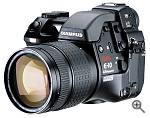 The Olympus E-10 first look, meanwhile, doesn't attempt to draw conclusions yet since the camera is a preproduction unit and hence can't really be judged on image quality or functionality. There are two pages of information on the camera layout and controls, however, along with a sample page with several images from the E-10. Just bear in mind when judging them that there's likely to be a significant difference between these and images from the final camera! The Olympus E-10 first look, meanwhile, doesn't attempt to draw conclusions yet since the camera is a preproduction unit and hence can't really be judged on image quality or functionality. There are two pages of information on the camera layout and controls, however, along with a sample page with several images from the E-10. Just bear in mind when judging them that there's likely to be a significant difference between these and images from the final camera!

Thursday, September 28, 2000
HP announces Cartogra redesign, 50 free prints!
By Michael Tomkins, The Imaging Resource
(Thursday, September 28, 2000 - 18:43 EDT)
 Hewlett-Packard Co. has unveiled a new look for Cartogra.com, its photo-sharing Web site. The company also announced HP Cartogra photo manager, software designed to make it easier for HP Cartogra.com members to upload and share photos. The software is available now as a free download on the site. Hewlett-Packard Co. has unveiled a new look for Cartogra.com, its photo-sharing Web site. The company also announced HP Cartogra photo manager, software designed to make it easier for HP Cartogra.com members to upload and share photos. The software is available now as a free download on the site.
Cartogra's new design is, says HP, 'more than just aesthetic - improved menu options quickly guide users to key activities on the site'. Navigation has been streamlined to allow faster access to photo activities including e-postcards and e-photoletters. A new "print it" button allows users to select an ink-saving "economy" option for printing photos in draft quality, if desired.
HP notes that with Cartogra Photo Manager, Cartogra is now the only photo-sharing Web site with a scheduling feature for uploads. Using the software, members can locate and manipulate their photos and then upload multiple images at a convenient time, such as weekends or evenings. Members can even continue using their PCs while uploading occurs in the background. The software supports HP digital cameras as well as digital cameras from most other manufacturers, and is compatible with any TWAIN device.
HP Cartogra photo manager software features a graphical interface, making it simpler for members to locate pictures stored on a digital camera or PC. Once images have been located, users can add photo captions, descriptions and key words before uploading. Members also can crop and rotate photos."HP Cartogra.com members will enjoy an array of features designed to provide them with an online photo-sharing experience unmatched by any other site," said Dan Gilbert, general manager of HP's Digital Imaging Solutions. "For example, the HP Cartogra photo manager's scheduling feature makes the image-uploading process simple and convenient for members." HP Cartogra.com and Ofoto are now also offering a new service that allows members to order prints of their favorite photos online. Members can choose only the pictures they want and Ofoto will create brilliant prints on Kodak Professional paper. For a limited time, members can get 50 4" x 6" prints of their favorite photos free of charge.
Source: Yahoo! Finance / Business Wire

Full review of Olympus C-211 Zoom posted!
By David Etchells, The Imaging Resource
(Thursday, September 28, 2000 - 0:30 EDT)
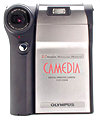 Way cool! - A digicam and Polaroid printer in one package! Shoot all you want, erase the pictures you don't want, make as many prints of the "keepers" as you'd like! It's a fully-functional 2 megapixel digicam, but has a slot to accept a pack of Type 500 Polaroid film. Not exactly pocket-sized as a result, but it really breaks new ground, at least for the US market. (Fuji has a printing camera that uses a thermal autochrome technology, but as far as we know, it hasn't made it to this country yet.) Not enough? Well, another great thing about combining digital and Polaroid means you can *adjust* the color, contrast, brightness, etc of the prints. We can think of dozens of situations where you'd want prints and digital files at the same time: If that describes your needs, this could be your camera! Check out the review for all the details! Way cool! - A digicam and Polaroid printer in one package! Shoot all you want, erase the pictures you don't want, make as many prints of the "keepers" as you'd like! It's a fully-functional 2 megapixel digicam, but has a slot to accept a pack of Type 500 Polaroid film. Not exactly pocket-sized as a result, but it really breaks new ground, at least for the US market. (Fuji has a printing camera that uses a thermal autochrome technology, but as far as we know, it hasn't made it to this country yet.) Not enough? Well, another great thing about combining digital and Polaroid means you can *adjust* the color, contrast, brightness, etc of the prints. We can think of dozens of situations where you'd want prints and digital files at the same time: If that describes your needs, this could be your camera! Check out the review for all the details!
Source: IR Review of Olympus C-211 Polaroid Printing Camera

Full review of Kodak DC5000 posted!
By David Etchells, The Imaging Resource
(Thursday, September 28, 2000 - 0:27 EDT)
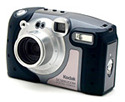 Want a digicam that can really take the knocks? Kodak's DC5000 has to be about the ruggedest (is that a word) digicam we've seen yet. Based on Kodak's successful 2 megapixel DC280 design, the DC5000 has thick rubber padding, a sealed housing around the lens, and o-rings around all the controls and openings, Kodak rates it as being able to take a drop from 3 feet onto concrete. (We have to confess we didn't have the guts to test that particular claim though.) It's not waterproof to the extent that you'd go swimming with it, but splashes, rainstorms, muddy job sites, etc should be no problem. Likewise dust and sand. Check out the review for all the details! Want a digicam that can really take the knocks? Kodak's DC5000 has to be about the ruggedest (is that a word) digicam we've seen yet. Based on Kodak's successful 2 megapixel DC280 design, the DC5000 has thick rubber padding, a sealed housing around the lens, and o-rings around all the controls and openings, Kodak rates it as being able to take a drop from 3 feet onto concrete. (We have to confess we didn't have the guts to test that particular claim though.) It's not waterproof to the extent that you'd go swimming with it, but splashes, rainstorms, muddy job sites, etc should be no problem. Likewise dust and sand. Check out the review for all the details!
Source: IR Review of Kodak DC5000

Wednesday, September 27, 2000
NPD Intelect sees triple-digit sales growth for US digicam market!
By Michael Tomkins, The Imaging Resource
(Wednesday, September 27, 2000 - 18:55 EDT)
 Sales of digital cameras will more than double this year compared to last year, according to a report published by marketing information provider NPD INTELECT Market Tracking. The firm projects U.S. unit sales for 2000 will reach 4.2 million units, translating to a 127% increase over 1999 sales of 1.8 million units. Sales of digital cameras will more than double this year compared to last year, according to a report published by marketing information provider NPD INTELECT Market Tracking. The firm projects U.S. unit sales for 2000 will reach 4.2 million units, translating to a 127% increase over 1999 sales of 1.8 million units.
Falling prices for the digital camera category should keep dollar sales growth at a lower pace. Nevertheless, NPD INTELECT analysts forecast a robust 79% growth rate in dollar terms. Sales of digital cameras should reach $1.8 billion dollars by year-end 2000 compared to $1 billion dollars in 1999.
The photo specialty store, says NPD, has become a winner of the growth trend by selling top-of-the-line digital cameras with the latest features. Booming sales of digital cameras have created a windfall for the channel in first half 2000; the $700 and above price point constitutes 70% of the channel's sales in dollars.
The electronic specialty store represents 50% of the same price point. However, unique to the electronic specialty stores is the $400 to $600 price point which successfully grew 34% in dollar share for the first half of 2000.
According to NPD INTELECT, the average price of a digital still camera slipped from $544 in 1999 to $513 year-to-date 2000. This decrease in price of digital cameras is expected to be furthered by upcoming holiday season discounts.
In further examination of all channels, NPD finds Sony to be leading the race for market share, with 40.8% dollar and 32.7% unit sales share across all channels tracked by the company. Olympus was next across the finish line with 20.2% dollar share and 19.4% unit share, followed by Kodak (15.7% unit share, 13.2% dollar share), Polaroid (6.9% unit share, 1.9% dollar share) and Nikon (5.8% unit share, 11.0% dollar share). Channels tracked by NPD Intelect include mass retailers/discount stores, computer/office superstores, electronics specialty stores, camera specialty stores, and computer mail order."With the strong demand of digital cameras and the holiday season upon us, the main issue the camera industry faces is not demand, but supply. Camera manufacturers are concerned about shortages in key components of digital still cameras. The only question for the remainder of the year is will manufacturers be prepared to meet the insatiable appetite that consumers have for digital cameras? We'll just have to wait and see," commented NPD INTELECT Senior Manager Neil Portnoy.
Source: Yahoo! Finance / Business Wire

Yahoo! selects PhotoWorks for online photofinishing!
By Michael Tomkins, The Imaging Resource
(Wednesday, September 27, 2000 - 18:39 EDT)
Online photofinisher PhotoWorks Inc. has announced that it will provide photofinishing services for internet portal Yahoo! Inc. A new film development area on Yahoo! Photos now gives users access to mail-in film-based photofinishing and online reprint ordering services provided by PhotoWorks. "This agreement pairs Yahoo! Photos, a leading Internet-based photo sharing site with PhotoWorks, a leading full service Internet photo company, giving Yahoo!'s millions of users easy access to Internet photo services via PhotoWorks," said Gary Christophersen, PhotoWorks President and CEO. "PhotoWorks' services allow Yahoo! Photos users to have their film developed, receive their prints and negatives via mail and have their pictures posted online in a password-protected area on Yahoo! Photos." "This agreement pairs Yahoo! Photos, a leading Internet-based photo sharing site with PhotoWorks, a leading full service Internet photo company, giving Yahoo!'s millions of users easy access to Internet photo services via PhotoWorks," said Gary Christophersen, PhotoWorks President and CEO. "PhotoWorks' services allow Yahoo! Photos users to have their film developed, receive their prints and negatives via mail and have their pictures posted online in a password-protected area on Yahoo! Photos."
 "Yahoo! Photos is pleased to offer our users the ability to easily develop film, receive prints and easily access their pictures online for users to view, share and order reprints," said Mark Hull, senior producer, Yahoo! Photos. "We selected PhotoWorks as our partner for mail-in film development and online scanning services based on their strong reputation as a leader in this market, the close relationship they have with their users, and their commitment to high-quality film developing and photofinishing services. Working together with PhotoWorks will make it easier for all camera users to benefit from the variety of services offered online without needing a digital camera or a scanner. Our agreement with PhotoWorks reinforces Yahoo! Photos as a one-stop place on the Internet for all online and offline photo needs." "Yahoo! Photos is pleased to offer our users the ability to easily develop film, receive prints and easily access their pictures online for users to view, share and order reprints," said Mark Hull, senior producer, Yahoo! Photos. "We selected PhotoWorks as our partner for mail-in film development and online scanning services based on their strong reputation as a leader in this market, the close relationship they have with their users, and their commitment to high-quality film developing and photofinishing services. Working together with PhotoWorks will make it easier for all camera users to benefit from the variety of services offered online without needing a digital camera or a scanner. Our agreement with PhotoWorks reinforces Yahoo! Photos as a one-stop place on the Internet for all online and offline photo needs."
As an introductory offer, Yahoo! Photos and PhotoWorks are offering each customer free processing and prints on their first roll of film. The service is available immediately. Subsequent orders of film processing start at $7.00 for a 24-exposure roll and 25 cents per digital reprint. Online access to photos is provided free of charge for all film processing orders. To sign up for the starter kit, log on to Yahoo! Photos, click on the "develop and pick-up" link and follow the instructions.
Source: Yahoo! Finance / Business Wire

Nikon extends Coolpix 800, 950 rebates; posts 990 firmware update!
By Michael Tomkins, The Imaging Resource
(Wednesday, September 27, 2000 - 18:24 EDT)
 A press release this afternoon from Nikon Inc. announces that it is extending both its $75 rebate on the Coolpix 800 digital camera (currently priced at $599 MSRP) and its $100 rebate on the Coolpix 950 digital camera (currently priced at $899 MSRP). The rebates, which were first started on July 6th and April 3rd of this year, respectively, and were planned to expire on September 30th, now end on December 31, 2000. The Coolpix 950 rebate has already been extended once, at the same time as the Coolpix 800 rebate was announced on July 6th. A press release this afternoon from Nikon Inc. announces that it is extending both its $75 rebate on the Coolpix 800 digital camera (currently priced at $599 MSRP) and its $100 rebate on the Coolpix 950 digital camera (currently priced at $899 MSRP). The rebates, which were first started on July 6th and April 3rd of this year, respectively, and were planned to expire on September 30th, now end on December 31, 2000. The Coolpix 950 rebate has already been extended once, at the same time as the Coolpix 800 rebate was announced on July 6th."The gift-giving season is fast approaching and consumers are beginning to look for the perfect present," said Bill Giordano, National Marketing Manager, consumer digital products at Nikon. "Digital cameras are one of the hottest products on the market this season, and with the rebate extension a Nikon digital camera makes for the perfect gift." To qualify for Nikon's holiday rebate, buyers must obtain an application provided by authorized Nikon dealers nationwide or download it from Nikon's website. Once completed, customers can mail in the application with proof of purchase to receive a rebate check from Nikon Inc. All rebate applications must be postmarked to Nikon no later than January 15, 2001.
Here's the reviews we're aware of for each camera:
Nikon Coolpix 950Nikon Coolpix 800Nikon has also released an update to the firmware of its Coolpix 990 digital camera. The Nikon Firmware Update for Coolpix E990 Version 1.1 has the following changes:- Improvements have been made to focusing when auto AF-area selection is in effect. Improvements have also been made when focusing in a selected focus area with manual focus-area selection.
- After a series of photographs has been shot in continuous sequence, the next photograph can now be taken as soon as memory for a single photograph becomes available in the buffer.
- Support for the remote release cable. The MC-EU1 remote cord (available separately) can be used not only to release the shutter but also to perform such operations as zoom and interval photography.
- With Best Shot Selection on, you can now take up to ten shots of any image quality and size. (Only the shot perceived to have the highest level of detail is recorded to the memory card. BSS is not available at an image-quality setting of HI.)
- A reduction has been made in the amount of time photographs are displayed after shooting, making it possible to set up the next photograph immediately.
- Improvements have been made to allow rapid display of uncompressed photographs taken at an image-quality setting of HI.
- The performance of the white balance function has been improved.
- Corrections have been made to some of the English, French, and German menus.
Please pay careful attention to Nikon's instructions for updating your camera. Firmware updates can be useful if done properly, but not following the instructions is a very good way to turn your camera into an extremely expensive paper-weight!
Thanks to IR reader Bret McKee for noticing the typo in the headline - yes, the firmware update is for the Coolpix 990, not the Coolpix 950! ;) We've corrected this now...
Source: Yahoo! Finance / PR Newswire

Konica, Zing create "distributed prints network"!
By Michael Tomkins, The Imaging Resource
(Wednesday, September 27, 2000 - 17:51 EDT)
 Konica Corp. and Zing Network Inc. have announced a strategic partnership to jointly create an online network for print processing at local retail stores and a co-branded online photo service. The "distributed prints network" is intended to provide a brick-and-mortar solution for Konica and Zing Network members to quickly and easily pick up prints at local stores that have been ordered online. The network is also planned to provide retail customers with a way to have their 35mm film digitized and uploaded to the Konica/Zing co-branded photo service for storing and sharing their pictures online. Konica Corp. and Zing Network Inc. have announced a strategic partnership to jointly create an online network for print processing at local retail stores and a co-branded online photo service. The "distributed prints network" is intended to provide a brick-and-mortar solution for Konica and Zing Network members to quickly and easily pick up prints at local stores that have been ordered online. The network is also planned to provide retail customers with a way to have their 35mm film digitized and uploaded to the Konica/Zing co-branded photo service for storing and sharing their pictures online.
The Konica/Zing distributed prints network is scheduled to launch in the United States in Q1 2001, and will expand to the European market later that year. Konica will develop a Shop Server for the Konica Digital Minilab QD-21 System to interface directly with a co-branded Konica/Zing online photo service giving QD-21 retail owners the ability to accept print orders from the users of the Konica and Zing network site. In addition, QD-21 retailers will be able to offer their customers film digitization services and uploading services. Zing will provide the core technology and infrastructure for this online photo service.
Digital camera owners who upload their images directly to any site in the Zing Network will be able to select a Konica QD Lab location near their home or business, order prints on the site, have them processed at that location, and pick them up the same day, without having to wait for mail-order processing or pay shipping costs. Consumers using 35mm film will be able to have their film digitized and uploaded to the co-branded photo service to share their images online with family and friends, build albums, send photo greeting cards, and order reprints and picture gifts directly from the Web. Printing will be processed at local retail locations, with silver-halide prints up to 8x10 inches in size. The distributed prints network will give Konica QD retailers the ability to accept print orders from all Konica and Zing Network members and to offer all of their customers film digitization, and uploading services. "The Konica/Zing distributed prints network will address the needs of our film users by offering digitization and upload-to-Web service, and address the needs of our digital camera users by offering the speed and convenience of `one-hour photo' prints," said Mark Platshon, Zing president and CEO. "Zing is proud to be the first major online photo service to offer its members print processing at local retail stores as well as the standard mail-order prints." "The Konica/Zing distributed prints network will address the needs of our film users by offering digitization and upload-to-Web service, and address the needs of our digital camera users by offering the speed and convenience of `one-hour photo' prints," said Mark Platshon, Zing president and CEO. "Zing is proud to be the first major online photo service to offer its members print processing at local retail stores as well as the standard mail-order prints."
"Konica expects to provide a more advanced digital mini-lab system to its retail customers through our strategic partnership with Zing, introducing online sharing, printing, storage and Internet communication capabilities for Konica's QD Lab film-processing customers. This will further enhance the developing, print and storage services to better serve customers worldwide," said Hideaki Iwama, an executive officer at Konica.
Source: Yahoo! Finance / Business Wire

Agfa, inChorus alliance announced!
By Michael Tomkins, The Imaging Resource
(Wednesday, September 27, 2000 - 17:00 EDT)
A news item from Adweek.com announces an interesting tie-up between Belgian company Agfa-Gevaert, well-known for its digital cameras and scanners, and Californian company inChorus, which has a proprietary software solution for putting sound and graphics in emails. Agfa will bundle InChorus' email software with its scanners and digicams, in return for which inChorus will offer Agfa's AgfaNet Print digital photofinishing service to its customers. The deal is expected to be finalised on October 1st, according to the article.
Source: Yahoo! News / Adweek.com

Polaroid announces combo digital/instant camera!
By Michael Tomkins, The Imaging Resource
(Wednesday, September 27, 2000 - 16:53 EDT)
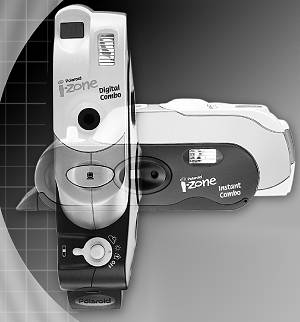
Polaroid Corp. premiered its new Polaroid I-Zone Digital & Instant Combo Camera at the Photokina 2000 show last week. We'd initially assumed the new Polaroid "Combo" camera used similar technology to the previously announced camera resulting from a cooperation between Polaroid and Olympus, but it turns out that this isn't the case. Instead, the "combo" camera literally combines a Polaroid I- Zone Instant Pocket Camera, and a VGA-resolution Polaroid digital camera, the unit featuring the entire, separate workings of both cameras in one chassis! You read that right - this unusual camera features two lenses, two flashes and two shutter buttons in one camera... (!)
 The digital side of "Combo" features a 640 x 480 VGA resolution digital camera with CMOS sensor capable of storing up to 18 digital photos in its on-board memory, ready for download, manipulation, e-mailing and sharing, courtesy of Polaroid's bundled imaging software. Polaroid describes the "Combo" camera as "[extending] the spirit of I-Zone freedom and fun into two dimensions offering 'one form, two functions' with the options of either traditional instant photography or digital photography". The digital side of "Combo" features a 640 x 480 VGA resolution digital camera with CMOS sensor capable of storing up to 18 digital photos in its on-board memory, ready for download, manipulation, e-mailing and sharing, courtesy of Polaroid's bundled imaging software. Polaroid describes the "Combo" camera as "[extending] the spirit of I-Zone freedom and fun into two dimensions offering 'one form, two functions' with the options of either traditional instant photography or digital photography".
Powered by four AAA batteries, the camera (or should that be a plural? :) features focus-free autoexposure and iconographic instructions, and is decorated in metallic shades of 'almost-midnight gray' and 'matte sterling-colored silver' with contrasting white and 'sunset orange' color accents. Customized 'PhotoImpression 2000 for Polaroid I-Zone' software provides for digital image enhancement, manipulation, morphing, mosaics, montages and collages, as well as the creation of calendars and greeting cards.
Polaroid's new i-zone.com website features tips, hints and ideas about sharing I-Zone digital and I- Zone instant images, encouraging the sharing of photos.
 Polaroid describes its new concept of a "Combo" camera as '[featuring] the option of share-now, share-later in one stylish, compact instrument that doubles as a fashion accessory'. The camera was developed in response to market research that revealed high scores for the idea of a combined instant and digital camera. Polaroid describes its new concept of a "Combo" camera as '[featuring] the option of share-now, share-later in one stylish, compact instrument that doubles as a fashion accessory'. The camera was developed in response to market research that revealed high scores for the idea of a combined instant and digital camera.
The new Polaroid I-Zone Digital & Instant Combo Camera is equipped with a wrist-strap, batteries and packaged with PhotoImpression 2000 software and a six-shot pack of Pocket Sticky Film. Suggested retail price is US$99.99. Marketing plans promise 'increasingly global availability'.
Source: Yahoo! Finance / PR Newswire

Tuesday, September 26, 2000
CreoScitex announces 6 megapixel Leaf C-Most digital back!
By Michael Tomkins, The Imaging Resource
(Tuesday, September 26, 2000 - 15:03 EDT)
 CreoScitex has unveiled its new Leaf C-Most back, a new digital camera back using the Leaf C-Most 6.6 megapixel CMOS image sensor which we first told you about back on January 13 2000 in our news item "Scitex announces 6.6 megapixel CMOS sensor". The Leaf C-Most back was exhibited at Photokina, September 20-25 in K�ln, Germany. CreoScitex has unveiled its new Leaf C-Most back, a new digital camera back using the Leaf C-Most 6.6 megapixel CMOS image sensor which we first told you about back on January 13 2000 in our news item "Scitex announces 6.6 megapixel CMOS sensor". The Leaf C-Most back was exhibited at Photokina, September 20-25 in K�ln, Germany.
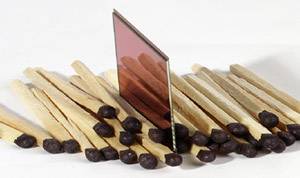
The Leaf C-Most back, billed as 'easy to use and simple to operate', sports the design and size of a film cassette making the integration with a medium format camera simple. Designed to be "plug-and-play" and to provide a high-quality, noise-free image, the sensor features both low power consumption and a special sensor power management mode to ensure a clear image, with minimum electronic noise. The Leaf C-Most back is claimed to provide over 11 f-stops of dynamic range using 14 bits of data per color."The introduction of the Leaf C-Most back marks a significant turning point in professional digital photography," said Amit Shvartz, Vice President, Marketing, Leaf Products, CreoScitex. "The unique value proposition of the Leaf C-Most back will draw more photographers to add digital photography to their offering, hence fueling the transition from analog to digital." The Leaf C-Most back features a burst-shooting rate of three frames per second. A 'Live Preview' feature enables photographers to compose a scene and focus with a video frame rate of up to 10 frames per second using a built-in electronic shutter.
 The 6.6 mega pixel Leaf C-Most, incorporated in the digital camera back, is claimed to be the largest CMOS sensor of its kind to be commercially developed. CreoScitex feels that the sensor "provides exceptional image quality when compared to other CMOS sensors due to a unique active pixel design, high sensitivity and low noise levels". The 6.6 mega pixel Leaf C-Most, incorporated in the digital camera back, is claimed to be the largest CMOS sensor of its kind to be commercially developed. CreoScitex feels that the sensor "provides exceptional image quality when compared to other CMOS sensors due to a unique active pixel design, high sensitivity and low noise levels".
Source: CreoScitex' Leaf C-Most Digital Camera Back announcement

Monday, September 25, 2000
New reviews from Steve's Digicams!
By Michael Tomkins, The Imaging Resource
(Monday, September 25, 2000 - 14:48 EDT)
Our friends over at the Steve's Digicams website have posted two new "first-look" reviews over the weekend, including the first review we've seen of Fujifilm's FinePix 4900 Zoom digital camera. Being first look reviews, there's no conclusions drawn yet - but there is plenty to keep you going in the meantime, with numerous sample photos and images of the FinePix 4900, as well as Pentax' EI-200. Check it out!

Digital imaging making news at the Olympics!
By Michael Tomkins, The Imaging Resource
(Monday, September 25, 2000 - 14:42 EDT)
Our friend David Kamanski over at the Digital Eye website has posted an interesting news item over the weekend on the 2000 Summer Olympics taking place in Australia currently. David has compiled a list of numerous websites posting pictures from the games, many of which are being taken with digital cameras such as Kodak and Nikon's "Pro" models. Interesting stuff - you'll find the list on the main Digital Eye page!

Friday, September 22, 2000
Delkin announces numerous flash devices!
By Michael Tomkins, The Imaging Resource
(Friday, September 22, 2000 - 21:24 EDT)
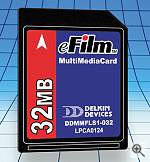 Delkin Devices Inc. today launched several new flash cards and related products. First up the company announces its new line of eFilm MultiMediaCards, MMC readers, and adapters. About half the size of a SmartMedia card, the eFilm MultiMediaCard is described by Delkin as 'the ideal portable solution for storing & transferring data to smaller digital cameras/camcorders'. One such device currently using MMC is the Digital DualCam digital video camera from JVC, which uses the cards for storing digital still pictures. Delkin’s MultiMediaCard family includes flash MMC cards with capacities of 16MB, and 32MB, (with plans to include a 64MB card by Q1 of 2001), the new eFilm Reader-8 (MMC to USB), and Delkin’s FlashPath adapter which allows users to access a MultiMediaCard through their 3 �" floppy disk drive. Delkin Devices Inc. today launched several new flash cards and related products. First up the company announces its new line of eFilm MultiMediaCards, MMC readers, and adapters. About half the size of a SmartMedia card, the eFilm MultiMediaCard is described by Delkin as 'the ideal portable solution for storing & transferring data to smaller digital cameras/camcorders'. One such device currently using MMC is the Digital DualCam digital video camera from JVC, which uses the cards for storing digital still pictures. Delkin’s MultiMediaCard family includes flash MMC cards with capacities of 16MB, and 32MB, (with plans to include a 64MB card by Q1 of 2001), the new eFilm Reader-8 (MMC to USB), and Delkin’s FlashPath adapter which allows users to access a MultiMediaCard through their 3 �" floppy disk drive."The major benefit of Delkin’s MultiMediaCards is high megabyte capacities in an ultra-small removable media for the latest compact digital devices which require additional memory," said Arthur Blanck, Chief Technical Officer, Delkin Devices, Inc. "Designed to be the smallest memory card, MultiMediaCards contain an embedded memory core which holds up to two pieces of solid-state flash memory and a controller inside this confined 1.4mm thick flash card," explains Mr. Blanck. "Since Delkin’s MultiMediaCards are built with non-volatile flash memory, they’re capable of operating at only 2.7 to 3.6 volts, so the cards don’t drain the device’s battery power. The other distinct advantage of using flash memory in our MultiMediaCards is their ability to re-write large amounts of data to the same card over 100,000 times!" At the same time, Delkin announced the eFilm Reader-8, an external MultiMediaCard reader/writer. Connecting to the USB port on a PC or Mac, the eFilm Reader-8 is claimed to transfer data up to 45 times faster than a standard serial port, and 6 times faster than a standard parallel connection. An entire 16MB eFilm MultiMediaCard can be downloaded to a computer in less than 20 seconds with the eFilm Reader’s micro-controller interface. Delkin also announced that they are offering a new version of the FlashPath floppy disk adapter, designed for MultiMediaCards. Similar to Delkin’s FlashPath for SmartMedia cards, the MMC FlashPath is an electronic 3.5 inch floppy disk device that allows users to access and transfer data from their MMC cards through their computer’s floppy disk drive.
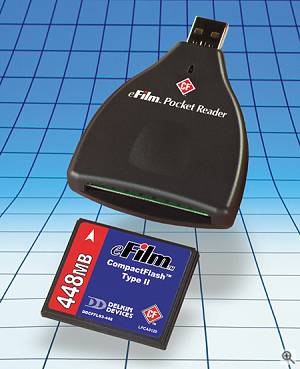
Delkin also today released a series of USB enabled, cable-free, reader / writers called eFilm Pocket Readers. Described by the company as 'about the size of a key chain ornament,' these external Pocket Readers feature a USB connector built directly into the back of each unit. The eFilm Pocket Reader can be directly plugged into the USB port on a laptop or directly into a desktop computer's USB port. The combination of a small, lightweight design, and no cables makes the eFilm Pocket Reader a good travel solution for downloading digital images, and data while on vacation, photo shoots, or business trips. Three different eFilm Pocket Readers are currently available from Delkin Devices: A CompactFlash Pocket Reader for accessing CF Type I and Type II, and IBM Microdrive memory cards. A SmartMedia Pocket Reader for downloading every capacity of SmartMedia, and also a MMC/SD Pocket Reader which can access both a 7-pin MultiMediaCard and a 9-pin Secure Digital memory card."These new eFilm Pocket Readers were designed for the purpose of being the most convenient tool for transferring images, songs and data from the memory card to computer when not in the office," noted Blanck. "Since the vast majority of PC and Mac laptops and desktops come equipped with a USB port, Delkin’s Pocket Readers contain a USB controller inside each reader. This micro-controller allows transfer of large megapixel images from the eFilm card to the computer in just a couple of seconds. In addition, Delkin has guaranteed its eFilm Pocket Reader to be 100% compatible with every manufacturer’s memory card format. So users who have different brands of CompactFlash cards, the CF Pocket Reader will accept all of them!" For computers with hard-to-reach USB ports, Delkin provides a 1-meter extension cable, allowing the Pocket Reader to become an external drive that can be conveniently placed on your desktop tower or next to your keyboard for home or office use. Once the eFilm Pocket Reader is attached to a USB port (either directly or connected with the extension cable) with an eFilm card inserted, the computer will automatically recognize it as another disk drive. From there, users can either drag & drop files to their hard drive, save images to the memory card, or erase the card for taking additional pictures.
The eFilm Pocket Reader is claimed by Delkin to have 'lightning fast transfer rates'. The half-inch thick device is capable of downloading 8MB of data to a PC or Mac computer in less than ten seconds. Delkin's benchmark test results found the readers to transfer data up to 45 times faster than a standard serial port. N external battery source since the reader obtains power through the USB port from the host system.
Finally, Delkin announced that it had increased the capacity of its Type-I CompactFlash memory cards up to 256MB, and CompactFlash Type II cards to 448MB. The new eFilm CompactFlash cards are being shown at the Photokina imaging show."For Delkin to manufacture the highest capacity CompactFlash and CompactFlash Type II cards to date, our engineers needed to use flash memory chips larger than 256Mbit in the design," explains Blanck. "Therefore we implemented a 512Mbit AND-type flash memory created from a Double Density Package, or DDP, which contains two 256 Mbit chips. These revolutionary 512Mbit flash chips gave us the necessary technology to reach such a high capacity in a single card," Delkin notes that its new CF cards come equipped with a new higher-speed controller which the company claims is still '100% compatible with every CF compliant device'.
No pricing or availability information was announced for any of the new Delkin products.

Moto Photo to merge with PhotoChannel subsidiary!
By Michael Tomkins, The Imaging Resource
(Friday, September 22, 2000 - 20:15 EDT)
 In one of the larger "clicks and mortar" deals that's yet gone down in the online photofinishing industry, PhotoChannel Networks Inc has announced that it has entered into a letter of intent for one of its subsidiaries to merge with Moto Photo Inc, the largest franchisor of retail imaging stores and the third largest specialty retailer of imaging services in North America. Moto Photo reported revenues of US $36.8 million for 1999 and a net income of US $1.65 million. In one of the larger "clicks and mortar" deals that's yet gone down in the online photofinishing industry, PhotoChannel Networks Inc has announced that it has entered into a letter of intent for one of its subsidiaries to merge with Moto Photo Inc, the largest franchisor of retail imaging stores and the third largest specialty retailer of imaging services in North America. Moto Photo reported revenues of US $36.8 million for 1999 and a net income of US $1.65 million."We are eager to access Moto Photo's unrecognized asset value represented by it's 2 million upscale customers who process 9 million rolls of film a year and generate one-quarter of a billion images," said Geoffrey G. Briant, CEO and Chairman of PhotoChannel. "Bricks and mortar retailers like Moto Photo will have an increasingly prominent role to play in the imaging world of the dot-com economy. Moto Photo's 419 locations will be a valuable link to PhotoChannel's digital world by providing us a widely distributed network for immediate film delivery and print pick-up. In the 1999 Annual Report for Moto Photo, Michael Adler, Moto Photo's Chairman & CEO commented, 'One dot-com company hails itself as one of the leading websites with 6 million images now being stored on its servers. That is equivalent to just 9 days volume for Moto Photo. This remark emphasizes for us the combined potential of PhotoChannel and Moto Photo." Moto Photo and it's franchisees have installed 100 digital workstations that enable its stores to print images from negatives and scan prints to digital images that could then be uploaded to the PhotoChannel web site. The Moto Photo system has also installed over 25 Fuji Frontier Digital Minilab systems that employ state-of the-art solid state laser exposure technology. These systems produce the highest quality prints from both film and digital media and can be configured to enable each store to upload to that store's private labeled version of the PhotoChannel site or to download images from the PhotoChannel site for print fulfillment and pick-up at that store. Moto Photo, combined with PhotoChannel, will have a larger installed-base of these state-of-the art digital minilab systems from Fuji than all of the all other photo-related dot-com companies in the world. "With this merger our shareholders, franchisees and associates will benefit from fully embracing digital photography. The combined superior management teams at Moto Photo and PhotoChannel, coupled with yesterday's announcement of PhotoChannel's new financial and strategic advisors at Salomon Smith Barney, gives us the foundation to build a new economy company" said Michael Adler, Chairman & CEO of Moto Photo. "I personally look forward to, and I am fully committed to, working with the merged entity. It is inevitable that imaging Internet companies will join forces with major retailers. I am excited that we are the first two companies to implement this strategy and I anticipate that others will want to join this newest imaging powerhouse." "With this merger our shareholders, franchisees and associates will benefit from fully embracing digital photography. The combined superior management teams at Moto Photo and PhotoChannel, coupled with yesterday's announcement of PhotoChannel's new financial and strategic advisors at Salomon Smith Barney, gives us the foundation to build a new economy company" said Michael Adler, Chairman & CEO of Moto Photo. "I personally look forward to, and I am fully committed to, working with the merged entity. It is inevitable that imaging Internet companies will join forces with major retailers. I am excited that we are the first two companies to implement this strategy and I anticipate that others will want to join this newest imaging powerhouse."
Dave's analysis: Perhaps the most significant point in all of this, but easily lost in amongst the details, is that MotoPhoto currently owns 25 of Fuji's (incredible) Frontier all-digital minilabs. These units provide scanning, image correcting and printing capabilities that are absolutely state of the art in the photofinishing world. PhotoChannel makes strong use of the Frontiers in their system, with powerful networking software that provides for linking the Frontiers to the internet. Until now, this has been both a strength and weakness for PhotoChannel, because the incredible demand for Frontier systems has significantly outstripped supply. The result is a many months-long waiting list for the units in the US, despite Fuji's dramatic ramp-up of Frontier production. By acquiring MotoPhoto, PhotoChannel has not only gained a very broad distribution network, but in one swoop has latched onto what's almost certainly one of the largest concentration of Fuji Frontier systems in the world. The net impact could be a tremendous acceleration of PhotoChannel's business plan.
There's also a very telling statistic in the press release that's worth repeating (which we're sure is why the PhotoChannel PR people put it there!): One of the leading photo-sharing sites has touted that they have over 6 million images now stored on their servers. Just to give you an idea of how vast the gulf is between the online photofinishing world and the traditional one, those 6 million images represent only *9* days of normal business volume for MotoPhoto's 2 million customers. Even a modest conversion ratio of film processing to online storage amongst MotoPhoto's customers could rapidly catapult PhotoChannel to the top echelon of online photofinishers!

Kyocera Finecam 3300 gets colorful!
By Michael Tomkins, The Imaging Resource
(Friday, September 22, 2000 - 19:27 EDT)
A photo on the excellent digitalcamera.gr.jp website caught our eye today, and sent us over to Kyocera Corp.'s Japanese website, where we found that the company intends to release colorful variants of its Finecam 3300 digital camera, which we first told you about back on July 18 in our news item 'Kyocera planning digital SLR and 3 megapixel point'n'shoot!'.
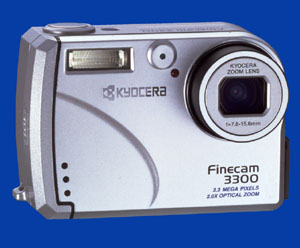 - Kyocera Finecam 3300 digital camera
- 3.34 megapixel 1/1.8" interlaced RGB CCD image sensor. Effective rating of 3.24 megapixels. EXIF 2.1 conforming JPEG and non-compressed TIFF-RGB image formats at resolutions of 2048 x 1536 (TIFF, JPEG Super-fine and Fine) or 1024 x 768 (JPEG Normal)
- 7.8 - 15.6mm F3.0 - 3.7 all-glass Kyocera 2x optical zoom lens equivalent to 38-76mm on a 35mm camera. Eight groups with nine elements. Minimum center resolution of 200 lines/mm. 1.3, 1.6 and 2x digital interpolation. Macro focusing down to 10 centimeters captures an image area of 42 x 36mm, normal focusing 0.6m to infinity. Automatic lens cover.
- 1.5" 110,000 pixel (512 x 218) low-temperature polysilicon TFT LCD display with brightness adjustment. No optical viewfinder.
- Type-II CompactFlash storage compatible with CompactFlash cards to 192MB or IBM Microdrive up to 1GB
- No PC connectivity (optional USB CompactFlash reader is available for ¥6,200 [US$58]). NTSC/PAL user-switcheable video output
- Aluminum alloy and reinforced plastic chassis
- Built-in four-mode flash (auto, auto with redeye reduction, on, off). Range of 0.6 - 3 meters at wide angle, 0.6 - 2.5 meters at telephoto. Charges in six seconds.
- Automatic exposure with +/- 2.0EV exposure compensation in 1/3EV increments, or Aperture priority AE (two settings of F3 or F6.6 possible)
- Shutter speeds of 1 - 1/2000 second, or manual shutter settings of 2, 4 or 8 seconds.
- Automatic, 4-preset (Daylight, Tungsten, Cloudy, Fluorescent) or manual white balance
- Contrast detection-type autofocus. Manual focus options are Macro or Infinity.
- Center-weighted averaging or Spot metering
- 2x or 4x sensitivity options
- AVI Movie capability; 15 frames per second for 15 seconds at 320 x 240 resolution. Quicktime 4.0 required.
- Sepia and Black & White modes (not possible in TIFF mode)
- 2x playback zoom
- 2 second or 10 second self-timer
- Sound at shutter release can be enabled/disabled
- Japanese/English switcheable menus
- Settings remembered when camera switched off
- DCF (Design Rule for Camera File System) and DPOF (Digital Print Order Format) compliant
- Single or all-image deletion
- Power from Lithium Ion rechargeable battery (bundled) which charges in-camera using the AC adaptor. One charge gives 200 photos or 90 minutes of use.
- Dimensions of 93.5 x 66 x 37.5mm, weight of 200 grams. Billed as the smallest and lightest 3 megapixel digital camera with zoom lens as of August 20, 2000.
- Available in 'Ice Blue', 'Aqua Pink', or 'Brilliant Silver' in Japan, 'Brilliant Silver' elsewhere (No, really! 'Aqua Pink' - we thought we were losing something in the translation, but we're not!)
- Bundled with Lithium Ion battery, AC adaptor, video cable and hand strap. Optional extras are CFR-1 USB CompactFlash reader (¥6,200, US$58) and extra BP-1100R Lithium Ion battery (¥4,500, US$42)
- Shipped on September 15 2000 in Japan at a price of ¥79,800 (US$749) with monthly production volume of 10,000 units

Source: Kyocera's Finecam 3300 press release

DPReview posts Photokina report!
By Michael Tomkins, The Imaging Resource
(Friday, September 22, 2000 - 13:12 EDT)
Our friends over at the Digital Photography Review have been at Photokina for a few days now, and they've finally gotten the time to post some news from the show. The article is quite long, so Phil has broken it up into 4 pieces, as follows:
Photokina Report Part 1- Agfa CL20 and CL34
- Canon G1, EOS D30, underwater housing, 400mm DO IS lens
- Casio QV-3X, QV-2300UX
- Delkin 256MB CF Type-I, 320MB & 448MB CF Type-II
- Foveon 16 megapixel CMOS, Hasselblad Dfinity
Photokina Report Part 2- Fuji Finepix 2400Z, Finepix 1300, Finepix 40i, Finepix 4700Z, Finepix 4900Z
- HP Photosmart C215, Photosmart C315, Photosmart C912
- IBM 512MB and 1GB Microdrives
- Kodak 16 megapixel CCD, DSC Pro Back, EZ-200, DC4800, DC5000, DC215
- Kyocera Contax N Digital SLR, Yashica Finecam 3300
Photokina Report Part 3- Leica Digilux 4.3
- Minolta Dimage 2330
- Nikon Coolpix 880, Coolpix 990, D1, MC-EU1 remote control
- Olympus E-10, E-100RS, C-3030Z, P-400 dye sublimation printer
- Panasonic iPalm PV-DC3000
Photokina Report Part 4- Pentax EI-2000 and unnamed digital SLR
- Ricoh RDC-i700
- Sandisk Photo-me station, 64MB SD MultiMediaCard with mockup digital camera, 300MB CF Type-II card
- Sony P1, DSC-F505V, DP-SV55 dye sublimation printer, MemoryStick picture frame

Thursday, September 21, 2000
Victor announces GC-X3 digital camera!
By Michael Tomkins, The Imaging Resource
(Thursday, September 21, 2000 - 20:01 EDT)
Consumer electronics manufacturer Victor Co. of Japan Ltd. (Better known overseas as Japan Victor Co., or JVC) has announced a new digital camera on its Japanese website, the PIXSTAR GC-X3. The camera appears to be a minor upgrade of Victor's previous PIXSTAR GC-X1 model, sold in the USA as the JVC GC-QX3U, which we first showed you at PMA last February.
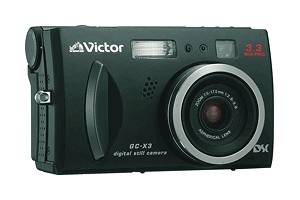
What's new in the PIXSTAR GC-X3? Well, it is actually a little difficult to tell; in our translation we only managed to turn up a few minor differences:- The same cold-forged aluminum chassis with a carbon-fiber reinforced polymer back as the original GC-X1 remains, but the color is now black instead of silver
- It appears that the top shutter speeds have been dropped somewhat (!) - our spec sheet on the original GC-X1 model lists shutter speeds of 1/750 to 1 second in Program AE mode, or 1/750 to 4 seconds in Night mode, whereas the spec sheet for the GC-X3 lists shutter speeds of 1/750 to 1/8 second in Program AE mode, and 1/750 to 2 seconds in Night mode.
- A High Definition Video output connector has been added to the camera for viewing images on an HDTV
- The camera is being promoted as having a "film copy mode"; similar to Leica's previous cameras, JVC are going to be releasing an adaptor to hold positive/negative film precisely 2 centimeters in front of the camera lens, allowing the film to be "photographed" in macro mode and hence copied. It isn't clear if the adapter will be bundled or sold separately, and if any software changes have been made to the digital camera itself to accomodate this.
The camera will go on sale in October at a price of ¥125,000 (US$1171), the same price as its predecessor, with a monthly production of 3,000 units. There is no note as to whether the GC-X1 will continue to be sold (we presume not, since the two cameras seem so similar), or whether the new model will be sold outside of Japan. More on this as we uncover any information!
Source: Victor GC-X3 press release

Jasc announces Paint Shop Pro 7.0!
By Michael Tomkins, The Imaging Resource
(Thursday, September 21, 2000 - 17:53 EDT)
 Jasc Software Inc. today announced the release of the latest version in their popular image editor series, Paint Shop Pro 7.0. Billed as 'the complete graphics and photo editor that offers the easiest, most affordable way to achieve professional results', v7.0's features new automatic tools and productivity features designed for digital photographers, home and business users, and Web designers. Jasc Software Inc. today announced the release of the latest version in their popular image editor series, Paint Shop Pro 7.0. Billed as 'the complete graphics and photo editor that offers the easiest, most affordable way to achieve professional results', v7.0's features new automatic tools and productivity features designed for digital photographers, home and business users, and Web designers."If you want one digital-imaging product that does it all, Jasc Paint Shop Pro 7.0 is the one for you," said Kris Tufto, CEO of Jasc Software. "No matter what you're into - digital photography, sharing family photos, creating business graphics, or designing Web sites - Paint Shop Pro 7.0 is packed with powerful tools that help you look great. But it's not a one-size-fits-all product. Newcomers will love the handy, automatic tools - and professionals will appreciate the top-notch, high-end features. So whether you're a new digital camera owner, or a graphics guru with your own Web site, Paint Shop Pro gives you an easy, very affordable way to make amazing, professional images." Paint Shop Pro 7.0 combines photographic enhancement and graphic design tools with a simple, intuitive interface to meet the image-editing demands of professionals and novices alike, Jasc feels. New features include: Automatically adjust color balance, enhance brightness, saturation, and hue Automatically adjust color balance, enhance brightness, saturation, and hue
- Remove red-eye, automatically - it works on people and animals
- Restore damaged photos with Scratch Removal Tool
- Adjustable Histogram enhances details without loss of information
- Automatically and manually improve video, scanned, and compressed images
- Remove noise, scratches, dust, or specks and improve crispness and impact
- Align, distribute, arrange, group and resize vector objects
- Create and save custom-styled lines with dots, dashes, and end-caps
- Create and save custom shapes for reuse
- Position more precisely with Snap-to grids and guides
- Experiment with over 20 new artistic and lighting special effects
- Speed-up downloading of Web graphics with Image Slicing
- Automatically create "hotspots" and embed URL links with new Image Mapping features
- Create visual mouse-overs with Image Rollover effects
- Preview graphics in various Web file formats in up to 3 browsers
- Repeat last command feature
- Save and retrieve workspaces to manage projects
- Identify and select with thumbnail previews of Picture Tubes, Gradients, Textures, Preset Shapes
- Navigate easier while in Zoom mode with the Overview Window Palette
- Protect critical work with customizable Auto-save
- Get started on the right foot with the new Getting Started Guide featuring hands-on tutorials
Enhanced features include:- Proofing, autoproofing, and reset options on most dialogs
- Support for nearly 50 file formats - claimed to be more than any other product on the market
- Vector shapes, lines, and text now support gradients, textures, and patterns on the stroke and fill commands
- Brushes now support gradients, textures, and patterns
- Create GIF animations with Animation Shop 3
- Optimize graphics for Web use with JPG/GIF/PNG Optimizer
Jasc Paint Shop Pro 7.0 is available at a suggested list price of $109 from Jasc Software, or through retail, Internet and mail-order sales channels. An electronic software distribution version is available for $99 from Jasc Software. Upgrades for registered users of previous versions are available for $39 through Jasc Software. In addition, certain users are eligible for corporate site licenses and educational discounts. An evaluation copy of Paint Shop Pro 7.0 may be downloaded from Jasc Software's Web site. Free, unlimited technical support is available to registered users directly from Jasc Software.

Hasselblad announces DFinity digicam with triple CMOS sensor design!
By Michael Tomkins, The Imaging Resource
(Thursday, September 21, 2000 - 15:10 EDT)
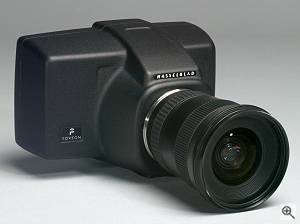
Swedish camera manufacturer Victor Hasselblad AB has combined efforts with Silicon Valley-based Foveon, Inc. to create the Hasselblad DFinity, a digital camera which the two companies are describing as 'the embodiment of Hasselblad's tradition of developing highest image quality camera solutions for professionals and the ability of Foveon to develop unique image capture technology'. In the creation of the DFinity, the press release notes, the two companies 'concentrated on their core competencies to develop a solution that combines the mechanical and optical expertise of Hasselblad with the CMOS-based imaging engine of Foveon'.President and CEO of Victor Hasselblad AB, G�ran Bernhoff, said of the cooperation, "We see Foveon as a very strong partner in the development of a photographic solution that will bring our customers the image quality they have been accustomed to in conventional film, also in the digital field. We see this as a first step in a fruitful cooperation where we combine the capabilities of our respective companies that will result in a series of compelling products for our customers." The Hasselblad DFinity will initially be sold by Victor Hasselblad AB as a special applications camera only for scientific, medical, archival and other digital imaging applications as well as to system integrators.
Until now, the press release continues, professional photographers have had to make a choice between the undesirable image artifacts created by single-shot, single-chip cameras using mosaic filter sensors and three-shot backs that are essentially free from artifacts but can't be used to capture moving subjects. The Hasselblad DFinity is designed to remedy this by integrating Foveon prism technology with three of its CMOS image sensors to improve color reproduction while providing protecting against moir� and other unwanted imaging artifacts found in the single-sensor cameras and backs."There's no doubt that the Foveon imaging engine, which consists, in part, of three 2Kx2K sensors mounted on a prism, results in superior images. Creating leading-edge CMOS-based sensor technology and reducing color artifacts are two of the pillars that Foveon is based on. We're extremely pleased that Hasselblad, a leader in professional image quality for over 50 years, recognizes the power and purity of this approach," said Carver Mead, Foveon's founder and Chairman of the Board.
"For several years Hasselblad has chosen not to market our own digital single-shot product for reasons of image quality. Only now with the Hasselblad DFinity concept can we truly say that the image quality matches that of film. This camera has the potential to replace today's three-shot backs as well as breaking new digital ground in applications such as portrait and fashion" says Patrik Mark, Vice president Marketing, Victor Hasselblad AB. The DFinity is housed in a compact camera body, which connects to a desktop or a laptop computer by an IEEE 1394 (FireWire) interface, allowing connection and disconnection of the camera at any time. The camera is controlled from the keyboard and screen, which functions as viewfinder, and captures up to 1 image every 1.5 seconds. Each image is 12 MB of true color information, i.e. 100% RGB information in every pixel as opposed to the common 33% in mosaic sensor cameras.
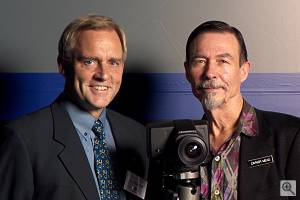
The screen delivers a live, color video preview, and a 'video focusing loupe', which can be moved freely to inspect any part of the image in 1:1 enlargement, meaning the photographer can see every pixel within the targeted area before he shoots. This ability is made possible by the direct access to each individual pixel inherent to the Foveon CMOS technology. This also provides the DFinity with the ability to selectively apply auto focus to any point in the image simply by pointing the magnifier loupe at the point and tapping a key. Hasselblad DFinity also incorporates an auxiliary shutter for automatic dark calibration as well as a sophisticated gamma correction, which gives a film-like response curve, thus providing an end result resembling that of conventional film.
Hasselblad will develop lenses specially optimized for the prism-imaging engine. The camera will however also work well with Canon EOS lenses by means of an adapter, thereby extending the range of available lenses.
Inside the camera is a Foveon-developed imager head that incorporates 3 sensors and a color separating prism. The prism is designed so that light entering it is split into red, green and blue components and then focused on each of three 2Kx2K CMOS sensors. Using a prism, the press release claims, enhances the system's ability to capture color that is purer than that captured by single-chip single-shot cameras using mosaic filters to create a color image. Further, by placing sensors on each of the 3 prism exit faces, the color of each point in the subject is sampled by three pixels (one red, one green and one blue).
The alternative color mosaic filter method samples the color using only one pixel and guesses at what the other two might be. Color artifacts typically seen as "Christmas tree lights" and the artificial color swirls from moir� patterns can result from this process. The artifacts typically occur in scenes that contain fabric patterns, fine hairs and highlights. This is where prism-based image capture is expected to provide images with fewer artifacts requiring correction, a process that slows image production and requires intervention by the photographer.
The camera software, DFinity CAM by Foveon, controls the camera and provides the photographer with two windows, one for a high-resolution color motion preview and one for reviewing images after capture. The DFinity CAM software runs under Windows 98 on a laptop or desktop computer. You can also keep track of what you've just shot by scrolling through and reviewing thumbnail images.
DFinity LAB by Foveon is the software for processing the images after they have been taken. Functionality includes: image review, tone reproduction control, color correction, images saved in either TIFF (8-bit and 16-bit) or JPEG format, image file sizes from 3MB to 48MB, and images saved with or without embedded color profiles. DFinity LAB runs on Macintosh or Windows 98. DFinity LAB for Macintosh can pull images from a Hasselblad DFinity camera through a network by using Windows/Macintosh networking software.
Source: Hasselblad's DFinity press release

Photokina Day Two report!
By Michael Tomkins, The Imaging Resource
(Thursday, September 21, 2000 - 14:28 EDT)
Yamada Kumio, the man behind the excellent Japanese digitalcamera.gr.jp website, has today posted his day two report live from the show floor at Photokina 2000 in Germany. There's a number of new cameras covered, as follows:- Kodak DC3200
The DC3200 is described by Yamada as a low-cost megapixel unit with an LCD display. He has posted two pictures of the camera, which he notes has a very simple exterior somewhat reminiscent of Fuji's DS-7 digital camera. The DC3200 has a fixed focal length lens and uses digital interpolation for zoom; storage is via 2MB of built-in memory and a CompactFlash card slot. Yamada felt the response of the LCD display to be quite slow, as was the shot-shot time of 18 seconds per shot. The DC3200, which Yamada speculates is actually built by Sharp, will cost 499 DM (US$216, £153, ¥23,000) when it ships in Germany.
- Sanyo Electric DSC-SX560 and unnamed ID Photo disk reference design
Sanyo is showing two interesting new developments at Photokina. First up is the first camera we've seen that uses the long-awaited iD 720MB magneto-optical disks that we told you about back on July 26 1999. When first announced, Sanyo (who created iD in cooperation with Olympus and Hitachi) had expected to have a camera using the disks to be shipping by this summer; since then they have been overtaken capacity-wise by IBM's 1 gigabyte Microdrive, as well as 1 gigabyte PC cards from the likes of Viking - but they could still be extremely worthwhile if the cost per disk is low enough in comparison with these other media... The new reference design features a 1.5 megapixel CCD and 3x optical zoom lens in an SLR-style camera. Detailed information on the camera is apparently hard to come by, so we can't confirm whether the unit actually has a TTL optical viewfinder or an LCD viewfinder, nor any other specifications, but as soon as we hear more we'll cover the camera in more detail...
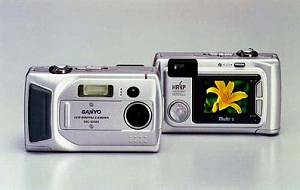
Also from Sanyo is a newly-announced camera, the DSC-SX560. The unit features a design based on Sanyo's DSC-SX550 digital camera (sold in the USA with an IBM Microdrive as the VPC-SX550MD), but has a one important change. Retaining the SX550's 1/2" 1.5 megapixel CCD, 7mm F2.4 fixed focal length lens (equivalent to 38mm on a 35mm camera), and Microdrive-compatible Type-II CompactFlash storage, the SX560 builds on its predecessor's already noteworthy speed. Movie recording capabilities are the same - up to 7.5 minutes of 640 x 480 15fps video, 35 minutes @ 320 x 200 15fps, and a whopping 50 minutes @ 160 x 120 15fps - plus a choice of 30fps and/or fine instead of normal compression in both of the lower resolutions. Where the SX550 could capture 7.5 frames per second of still images for 15 (fine) or 20 (normal) shots at 1360 x 1024, 20 fine or normal shots at 7.5 or 15fps in 1024 x 768, and 40 fine or normal shots at 7.5 or 15 fps in 640 x 480, though, the SX560 really shines. How about 7.5 or 15 frames per second for 15 (fine) or 20 (normal) shots at the full 1360 x 1024 resolution and 50 fine or normal shots at 7.5, 15 or 30 fps in 640 x 480? Wow... Yamada notes that the European and Japanese designs differ for the camera, the European design looking essentially identical to the current VPC-SX550MD, whilst the Japanese version will feature a rubberized handgrip...
- Kyocera/Contax N Digital
No new information here, but Yamada presents us with two new photos of the N Digital body (without a lens) as well as a picture showing Contax' display stand with a variety of N system camera bodies, lenses and the suchlike.
- Canon DO lens
We told you about Canon's new diffractive optical element, a development that allows smaller, lighter lens designs in our news item 'Canon announces diffractive optical element breakthrough!' of September 7th, and at that time showed you pictures of the new lens alongside an equivalent non-DO lens. Yamada has now seen the new DO lens in person, and has posted similar photos of the DO element and a lens comparison, as well as a photo of the new lens on a Canon EOS 1V body, and a closeup photo of the DO element which demonstrates the concentric diffraction grating rings quite nicely... According to Yamada's discussion with Canon, they intend to develop the DO element for use in both digital camera and single-lens reflex camera lenses and increase lens density (smaller, more powerful lenses).
Source: Yamada Kumio / digitalcamera.gr.jp

Updated: Minolta announces Dimage 2330 digital camera!
By Michael Tomkins, The Imaging Resource
(Thursday, September 21, 2000 - 2:49 EDT)
 Minolta Corp. has unveiled a new digital camera at the Photokina show in Germany, the Dim�ge 2330. The new camera, which looks to follow in the footsteps of Minolta's previous Dim�ge 2300 but with the welcome addition of a 3x optical zoom lens, retains the 2300's 2.3 megapixel image resolution in a similarly styled (but not identical) chassis. Here's the full specs (pictures updated 09/27/00 12:22EST with some better ones): Minolta Corp. has unveiled a new digital camera at the Photokina show in Germany, the Dim�ge 2330. The new camera, which looks to follow in the footsteps of Minolta's previous Dim�ge 2300 but with the welcome addition of a 3x optical zoom lens, retains the 2300's 2.3 megapixel image resolution in a similarly styled (but not identical) chassis. Here's the full specs (pictures updated 09/27/00 12:22EST with some better ones):
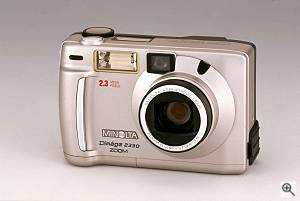 - Minolta Dim�ge 2330 ZOOM digital camera
- 1/1.75" 2.31 megapixel RGB interline CCD gives images of 1792 x 1200 or 896 x 600 pixels in EXIF 2.1 JPEG format, Fine, Standard or Economy compression
- 8 - 24mm 3x optical zoom lens equivalent to 38 - 114mm on a 35mm camera. 9 elements in 6 groups, including 3 aspherical elements. f/3.4 - f/3.6. macro mode focusing down to 40mm (1 9/16"). 2.5x digital interpolation.
- 1.8-inch TFT LCD display
- Type-I CompactFlash storage media
- 5-mode built-in flash (Auto, Fill, Off, Auto with Redeye Reduction, Fill with Redeye Reduction)
- USB connectivity
- TTL autofocusing system
- TTL Programmed AE exposure with +/- 2.0EV exposure compensation in 0.5EV increments
- Center-area average TTL metering
- ISO rating of 100
- Shutter speeds 1/500 to 1 second
- Automatic or 3-preset manual (Daylight, Fluorescent, Tungsten) white balance
- Burst mode of approx. 1 frame per second for 12 frames in economy compression, 896 x 600 pixel resolution
- 10-second self timer
- Complies with DCF (Design Rule for Camera File System) and DPOF (Digital Print Order Format)
- Power from 4 AA alkaline or NiMH batteries, or external 6V DC AC adapter
- Dimensions of 116 x 73 x 62mm (4 9/16 x 2 7/8 x 2 7/16 inches)
- Weighs 220 grams (9 7/8 ounces) without batteries or flash card
- Bundled with AA alkaline batteries, 8MB CompactFlash card, Video cable, USB cable, camera case, hand strap, USB driver CD-ROM, Adobe PhotoDeluxe CD-ROM (Mac/Windows)
- Optional AC adapter (AC-1 100-120V 50/60Hz for North America and Japan, AC-2 100-240V 50/60Hz for Europe, Asia except Japan, and Oceania)
- Expected MSRP of US$499
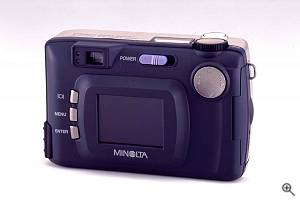

Wednesday, September 20, 2000
Konica announces 4 new digital cameras!
By Michael Tomkins, The Imaging Resource
(Wednesday, September 20, 2000 - 18:30 EDT)
In a follow on from the previous news item, the same pages we referenced at the Japanese PC Watch and digitalcamera.gr.jp websites list details of 4 new digital cameras from Konica. PC Watch's Photokina Day 1 page describes the 2.11 megapixel KD-200Z, which also features a 3x optical zoom lens, built-in flash, Color LCD, info LCD and SD card storage (also compatible with the MultiMediaCard); further details on the camera have yet to be announced.
Also shown were three other cameras, all VGA (0.35 megapixel)resolution; the KD-35V, KD-35L and KD-35MP3. The KD-35V is the lowest model, with a fixed focus lens and optical viewfinder, to which the KD-35L adds an LCD display. A different chassis is used for the KD-35MP3, which also gets a built-in flash and MP3 audio capability.
All of the cameras, of which digitalcamera.gr.jp also has photos, are apparently aimed at the American marketplace where low-priced digital cameras are more popular.

Pentax digital SLR - first photos online!
By Michael Tomkins, The Imaging Resource
(Wednesday, September 20, 2000 - 17:46 EDT)
We told you back on September 14th about an upcoming SLR from Pentax, and today we can lead you to the first photos you'll see on the web of the new camera! Our friend Yamada Kumio has posted front and rear photos of the camera at the PC Watch website, and small thumbnails of the front, rear and spec sheet on his own digitalcamera.gr.jp website.
Yamada has been unable to get any further information as to the specifications of the camera, although looking at the photos will tell you quite a bit about it. To recap, here's the specs:- Unnamed Pentax Interchangeable-lens SLR digital camera
- Full 35mm-frame sized 6 megapixel CCD and a DSP both developed by Philips
- Newly designed magnesium alloy SLR body which is also used by a new flagship film camera being announced by Pentax at the same time, features 2-inch LCD display, built-in retractable TTL flash unit, fixed pentaprism TTL optical viewfinder
- Pentax KAF2 bayonet lens mount, which is compatible with K-mount, 645N and 67II lenses by use of a converter
- Type-II PC card and Type-II CompactFlash slot which can be used simultaneously
- Files saved in TIFF, JPEG or RAW formats
- IEEE 1394 (FireWire) connection
- 6-point autofocus system
- Shutter speeds up to 1/6000 second

Panasonic announces PV-DC3000 digital camera!
By Michael Tomkins, The Imaging Resource
(Wednesday, September 20, 2000 - 17:22 EDT)
 Panasonic Consumer Electronics Co. has announced what it is calling 'the world's first SD Memory Card-compatible digital camera', the Panasonic ipalm digital camera PV-DC3000. Scheduled to hit the market next month, the PV-DC3000 uses the SD recording medium, a postage stamp-sized memory card which features built-in copy protection, something Panasonic's parent company Matsushita Electric (which developed the SD Memory Card format in cooperation with SanDisk Corp. and Toshiba Corp.) feels 'will be indispensable in the coming digital networking era'. Panasonic Consumer Electronics Co. has announced what it is calling 'the world's first SD Memory Card-compatible digital camera', the Panasonic ipalm digital camera PV-DC3000. Scheduled to hit the market next month, the PV-DC3000 uses the SD recording medium, a postage stamp-sized memory card which features built-in copy protection, something Panasonic's parent company Matsushita Electric (which developed the SD Memory Card format in cooperation with SanDisk Corp. and Toshiba Corp.) feels 'will be indispensable in the coming digital networking era'."In addition to being SD Memory Card-compatible, the new PV-DC3000 ipalm digital camera also takes print-quality photos that can easily be e-mailed with audio accompaniments, all at the touch of a button," says Mary Miceli, product manager of the Consumer Video Division for Panasonic Consumer Electronics Company. "And, as attractive as it is useful, the new ipalm digital camera also has a striking, vertically-oriented, easy to hold design that fits more naturally into the palm of the user's hand." Here's the full specs on the new camera:
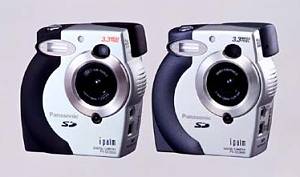 - Panasonic ipalm PC-DC3000 digital camera
- 0.55" 3.3 megapixel CCD. Images stored in JPEG (Super Fine, Fine, Normal and Burst-Mode) or TIFF (uncompressed) formats. Resolutions of 2048 x 1536 in TIFF and JPEG Super Fine/Fine, 1024 x 768 in JPEG Normal or Burst-Mode.
- 2x optical zoom lens equivalent to 32-64mm on a 35mm camera. 3x digital interpolation.
- 1.5-inch color TFT LCD display
- Built-in flash with red-eye reduction
- SD card slot compatible with SD Memory Card or MultiMediaCard. 16MB MultiMediaCard bundled.
- PC or Mac compatible USB connectivity with "Easy Transfer" (press a button on the camera to automatically transfer all images to PC)
- Easy Mail feature will automatically attach an image to an email message by pressing the Mail and Shutter buttons.
- Program AE exposure with shutter speeds 1/30 to 1/1000 second or 1/4 to 1/1000 second in slow shutter mode, and apertures from F2.9 to F8
- Still images can be tagged with up to 5 seconds of audio
- Automatic white balance
- QuickTime MotionJPEG compliant movie capture with audio, 320 x 240 resolution up to 12 seconds per movie, 10 frames per second
- Burst mode uses higher resolution and can capture up to 3 images per burst, time between images not specified
- Time lapse mode automatically captures images at intervals of 1, 5, 10, 30 minutes, or 1, 6, 12 or 24 hours
- Self-timer
- Bundled with a 16MB MultiMediaCard, USB cable, PC USB driver (Mac version is not yet available but will be posted on Panasonic's website), video cable, camera strap, 4 AA alkaline batteries, Adobe PhotoDeluxe (Home Edition v4.0 for Windows or 2.0 for Macintosh) and QuickTime
- Power from 4 AA Alkaline batteries
- Available in the USA in October, 2000 at an MSRP of US$899.95, and in Japan as the PV-DC3000J on October 25th at an MSRP of ¥95,000 (US$)
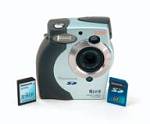 The PV-DC3000J, which will be available with black or dark-blue trim in Japan, will be on display at the CEATEC JAPAN 2000 show, to be held from October 3 to 7 at the Makuhari Messe Convention Center in Chiba, east of Tokyo. The PV-DC3000J, which will be available with black or dark-blue trim in Japan, will be on display at the CEATEC JAPAN 2000 show, to be held from October 3 to 7 at the Makuhari Messe Convention Center in Chiba, east of Tokyo.
Source: Yahoo! Finance / PR Newswire

Conexant announces 1.3 megapixel CMOS reference design!
By Michael Tomkins, The Imaging Resource
(Wednesday, September 20, 2000 - 16:10 EDT)
 Conexant Systems Inc. has launched a new 1.3-megapixel CMOS digital camera reference design that it notes in a press release 'allows manufacturers to quickly, easily and inexpensively bring digital still camera products to market'. The reference design enables production of of digital still cameras that are more compact and have longer battery lives than existing products on the market today, Conexant claims. Conexant Systems Inc. has launched a new 1.3-megapixel CMOS digital camera reference design that it notes in a press release 'allows manufacturers to quickly, easily and inexpensively bring digital still camera products to market'. The reference design enables production of of digital still cameras that are more compact and have longer battery lives than existing products on the market today, Conexant claims.
The reference design kit incorporates the company's 1.3-megapixel CMOS sensor and the Raptor II-C digital camera processor. Together, the kit incorporates all the necessary hardware, firmware and software needed to create a digital still camera, simplifying the design process and shortening time-to-market.
In addition, the reference design kit can be expanded to incorporate communications technologies such as Bluetooth wireless networking and embedded V.90/V.92 modems. Conexant will demonstrate the new reference design this week at the Photokina 2000 exhibition in Cologne, Germany."The reference design kit is the first of many complete 'turnkey' product deliverables developed from the acquisition of Sierra Imaging in June of this year," said Douglas Cebik, senior product marketing manager for Conexant's Personal Imaging Division. "Our full-featured reference design appeals to both traditional digital still camera manufacturers, and a new class of companies that want to add imaging to their product portfolio with our product's easy-to-manufacture architecture and cost-effective design. Our design allows camera manufacturers to reduce the cost, power consumption and size of their megapixel digital cameras without sacrificing image quality or click-to-click performance." Conexant's reference design kit includes the CX20450 1.3-megapixel CMOS image sensor; the CX11637 Raptor II-C device, which is based on the company's Raptor II digital camera processor; the S3P (Small-scale System Software Platform) real-time operating system; and the company's Image Expert(TM) imaging software.
Conexant's reference design kit supports features such as a cycle rate of less than two seconds, NTSC/PAL output and simultaneous support for Compact Flash or SmartMedia storage. Images captured by the reference design allow users to create standard 5x7 or 4x6-inch prints which are 'nearly indistinguishable from prints created by film', Conexant notes.
Conexant's CX20450 is claimed to be the first consumer megapixel image sensor in production based on CMOS technology. Conexant's mixed-signal CMOS process offers improved sensitivity and less noise over alternative process technologies, resulting in higher-quality pictures, the company feels. The Raptor II-C processor is claimed to be faster than general-purpose digital signal processors by a factor of 10.
The reference design kit comes complete with camera hardware, reference design files such as schematics and recommended bill-of- materials, documentation and calibration setup information and procedures. In addition, the reference design kit allows OEMs to localize and customize portions of the user interface and feature set in order to meet global needs.
Conexant's 1.3-megapixel CMOS digital camera reference design kit (part number TR08-D001) is available now and priced at $15,000 per kit.
Source: Yahoo! Finance / Business Wire

Tuesday, September 19, 2000
Kodak announces 16 megapixel Pro Back!
By Michael Tomkins, The Imaging Resource
(Tuesday, September 19, 2000 - 2:13 EDT)
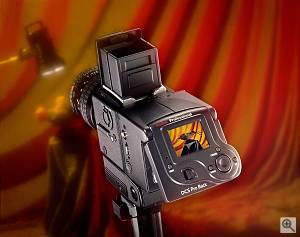 Kodak Professional will today make a major addition to its professional digital camera line by announcing the Kodak Professional DCS Pro Back, a Kodak-designed and manufactured medium-format camera back with a whopping 16-megapixel resolution that creates 48-megabyte image files. Kodak Professional will today make a major addition to its professional digital camera line by announcing the Kodak Professional DCS Pro Back, a Kodak-designed and manufactured medium-format camera back with a whopping 16-megapixel resolution that creates 48-megabyte image files.
Providing untethered freedom of operation, a fully featured LCD with histogram, new-generation software and a host of other capabilities, the DCS Pro Back is, says Kodak, designed for commercial location and tabletop photography and high-end portraiture applications. In particular it is targetted at advertising and catalog photographers, table-top studios, and in-house and independent portrait studios.
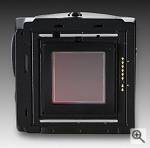 Complementing the DCS Pro Back is Kodak Professional DCS Capture Studio Software, Version 1.5, a stand-alone application for capturing and editing digital images. Capture Studio, notes Kodak, 'delivers exceptional workflow and optimized image quality, using an open systems approach to color management that maintains the integrity of captured images for virtually all monitors and printers, computer platforms and imaging applications.' Complementing the DCS Pro Back is Kodak Professional DCS Capture Studio Software, Version 1.5, a stand-alone application for capturing and editing digital images. Capture Studio, notes Kodak, 'delivers exceptional workflow and optimized image quality, using an open systems approach to color management that maintains the integrity of captured images for virtually all monitors and printers, computer platforms and imaging applications.'"The DCS Pro Back represents everything Kodak Professional has learned about digital image capture and workflow, studio and portraiture applications, and what photographers want after more than a decade of developing the world's best-selling professional digital cameras," said Jerry Magee, Worldwide Product Line Manager, DCS Capture Systems, Kodak Professional."This digital camera back marries Kodak's image science and color management expertise with important new photographic features and our own 4K-by-4K ITO sensor, representing the highest standard of image quality and light detection on the market,” Magee said. “The result is large, precise, quality image files that are remarkably easy to capture, evaluate and process in a professional workflow." The DCS Pro Back is a single-shot unit that is designed to afford photographers as much freedom as possible. Currently compatible with Hasselblad 555 ELD and Mamiya RZ film cameras, the camera back will in time have interfaces for a wide range of medium- and large-format camera systems. And the DCS Pro Back operates untethered, making it suitable for high-end location photography as well as studio work.
The fully featured LCD gives photographers critical real-time control over the images they take. The LCD screen has a full 90 degrees of movement for waist-level operation and can be controlled one-handed. In addition to acting as a viewfinder, the LCD provides instant review, a histogram for precise exposure control, focus check, and a built-in spot meter. The DCS Pro Back can also perform 1:1 zoom and pan functions for precise images, and offers video review capability for high-angle or other out-of-reach camera placements.
The camera back's full-frame CCD delivers more than twice the resolution of any single-shot, medium-format camera back currently available, says Kodak. This sensor, measuring 36.86mm by 36.86mm, produces 48mb files with very low noise. A removable anti-aliasing filter, digital anti-aliasing solutions and a non-reflecting IR cutoff filter help ensure the highest image quality.
The DCS Pro Back captures images at the equivalent of ISO 100. It can capture an image every two seconds, and store up to eight images before writing to either of its two internal PC card slots or a host computer via an IEEE 1394 "firewire."
The hardware advances of the DCS Pro Back are complemented by new software that uses standard photographic terms. It includes familiar imaging tools such as masking/feathering, as well as sharpening tools and an eyedropper-style color selector. The camera back's new-generation software, Kodak feels, 'understands how photographers work with images and greatly simplifies workflow'. DCS Capture Studio Software, Version 1.5, gets the best possible quality out of the DCS Pro Back's pictures with time-saving intuitive features that let professional photographers concentrate on taking pictures. The software is initially available for Macintosh computer systems, with a Windows-compatible version planned for the future.
The back ships with ICC-enabled color management tools and other software specifically designed for photographic workflows. It can be powered either by internal rechargeable batteries or via a "firewire" cable attached to a host computer.
The Kodak Professional DCS Pro Back will be available in the first quarter of 2001 from authorized dealers of Kodak Professional products. Pricing information is not yet available.
Here's full details as we have them on the DCS Pro Back:
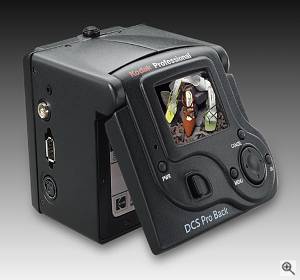 - Kodak DCS Pro Back
- 16 megapixel CCD image sensor. 4,096 x 4,096 pixel resolution, 9um pixel size. 12-bit dynamic range, 'extremely low noise'. Yields 48MB files.
- Compatible with Hasselblad 555 ELD and Mamiya RZ medium format camera systems; interfaces for other medium- and large-format camera systems planned.
- 1.3x focal length magnification in a medium format camera
- LCD display with 90-degree tilt movement, instant review, histogram, overexposure indicator, 1:1 focus check, RGB spot meter
- S-Video review port
- Removeable anti-aliasing filter
- Dual PC card slots, compatible with the IBM Microdrive, allows up to 2 gigabytes of in-camera storage!
- Powered by IEEE 1394 "FireWire" port or internal rechargeable battery
- Burst mode allows for one image every 2 seconds for 8 images
- ISO rating of 100
- Stand-alone host software with ICC-enabled color management tools. Features include up to 10 input profiles mimicking film emulsions and one custom input profile
Exclusive: The following four screenshots are taken from Kodak's new DCS Capture Studio version 1.5, and demonstrate the program's 'Exposure and Toning', 'Composition' and 'Color Adjustment' dialogs:
Note from Dave: This is really big news for a lot of reasons, only part of which is the amazing resolution. We won't know the price until probably Spring PMA, but I for one am betting that it'll be aggressively priced: Kodak Professional will be wanting to gain some sort of ascendancy again, after the drubbing they've been taking in the Pro SLR arena. The big thing I see in the screen shots above is Kodak really looking at how commercial photographers think. Note how the tone-adjustment tool combines a histogram and a tone curve that looks very much like a d/logE curve from conventional film. Also note something that passed with little notice in the press release as well as coverage elsewhere: The Pro Back will come with up to 10 different "input profiles" to simulate different film emulsion types. Say again? - Notice the innocuous-looking box on the "Exposure and Toning" screen called "look". Think "Vericolor" (now called Portra), "Ektachrome VS", "Kodachrome", etc, etc. We haven't had hands on a unit yet (for obvious reasons), so can't comment too much on the user interface Kodak's developed, but it sure looks interesting for studio photographers. - And not just Studio Folks either! - How about that 2-gig onboard capacity, thanks to a pair of MicroDrives? 100 or so shots not enough? Just pop in another $1K worth of drives, and shoot another 100 exposures! (Of course, a laptop with a roomy hard drive and PC-card adapter would be an obvious solution too, if absolute portability wasn't an overriding concern.) Hey, and what about that itty bitty (relatively speaking) 1.3x focal length multiplier? Can you say "wide angle?" Take it to the bank, this one's going to be a hot product!

Diver Drubs Dave! Review Updated!
By David Etchells, The Imaging Resource
(Tuesday, September 19, 2000 - 0:17 EDT)
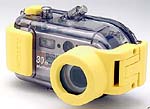 Reader Allen Wicks took us rather severely to task for our admittedly fizzy review of the Sony Marine Pack underwater case for the new CyberShot DSC-P1. He felt that our comments were really too sweeping, and didn't take into account a range of professional-level underwater cases available on the market for a variety of digicams. Guess what: He was right! We really should have qualified our comments as being made relative to other housings we've seen at a similar price point to the Marine Pack, and have now modified the P1 review to reflect this enlightened understanding. Allen also took time to point out some general limitations consumer-level digicams have for underwater work: Read the updated DSC-P1 review for the details. (Easy to find, they're at the end of the section on the Marine Pack.) Thanks, Allen! Reader Allen Wicks took us rather severely to task for our admittedly fizzy review of the Sony Marine Pack underwater case for the new CyberShot DSC-P1. He felt that our comments were really too sweeping, and didn't take into account a range of professional-level underwater cases available on the market for a variety of digicams. Guess what: He was right! We really should have qualified our comments as being made relative to other housings we've seen at a similar price point to the Marine Pack, and have now modified the P1 review to reflect this enlightened understanding. Allen also took time to point out some general limitations consumer-level digicams have for underwater work: Read the updated DSC-P1 review for the details. (Easy to find, they're at the end of the section on the Marine Pack.) Thanks, Allen!
Source: Update of Imaging Resource DSC-P1 Review

Monday, September 18, 2000
Full Review of Epson PhotoPC 3000Z posted!
By David Etchells, The Imaging Resource
(Monday, September 18, 2000 - 23:17 EDT)
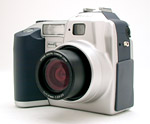 We confess this one's been a long time in coming, we having had the camera here far too long (this week looks to be a bit of a catch-up week on camera reviews, dealing with a couple in this category). After *much* badgering of Epson for a review unit of one of their cameras, we finally got our hands on a sample of their PhotoPC 3000Z. This is Epson's entry into the high-end "prosumer" market, and it's quite a worthy contender at that. It boasts all the requisite features, including full exposure control (aperture and shutter priority as well as full-manual control), provision for external flash, good picture quality, and an a user interface that's somewhat unusual, but that we found highly effective. Overall, a very worthy entry into the 3 megapixel race, and one we suspect will make for many happy owners. Read the review for all the details! We confess this one's been a long time in coming, we having had the camera here far too long (this week looks to be a bit of a catch-up week on camera reviews, dealing with a couple in this category). After *much* badgering of Epson for a review unit of one of their cameras, we finally got our hands on a sample of their PhotoPC 3000Z. This is Epson's entry into the high-end "prosumer" market, and it's quite a worthy contender at that. It boasts all the requisite features, including full exposure control (aperture and shutter priority as well as full-manual control), provision for external flash, good picture quality, and an a user interface that's somewhat unusual, but that we found highly effective. Overall, a very worthy entry into the 3 megapixel race, and one we suspect will make for many happy owners. Read the review for all the details!
Source: Imaging Resource review of PhotoPC 3000Z

Canon announces PowerShot Pro70 successor!
By Michael Tomkins, The Imaging Resource
(Monday, September 18, 2000 - 12:38 EDT)
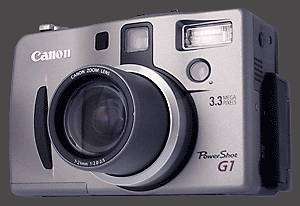
 The folks at the digitalkamera.de website in Germany have posted the first news we've seen of a new camera from Canon, the PowerShot G1 digital camera. Billed as a successor to the popular PowerShot Pro70, the G1 features a 3 megapixel CCD and 3x optical zoom lens, but loses the SLR-style design of the Pro70 (which wasn't actually an SLR, and still had separate viewfinder/lens optics), instead taking on a much more traditional form. Digitalkamera.de's coverage was shortly followed by the folks at the Digital Eye website, who in turn pointed out that Canon's own BeBit website had posted information on the G1 as well as two sample photos. The Digital Photography Review website then followed with their own coverage of the camera adding further specifications... Without any further ado, here's the full story: The folks at the digitalkamera.de website in Germany have posted the first news we've seen of a new camera from Canon, the PowerShot G1 digital camera. Billed as a successor to the popular PowerShot Pro70, the G1 features a 3 megapixel CCD and 3x optical zoom lens, but loses the SLR-style design of the Pro70 (which wasn't actually an SLR, and still had separate viewfinder/lens optics), instead taking on a much more traditional form. Digitalkamera.de's coverage was shortly followed by the folks at the Digital Eye website, who in turn pointed out that Canon's own BeBit website had posted information on the G1 as well as two sample photos. The Digital Photography Review website then followed with their own coverage of the camera adding further specifications... Without any further ado, here's the full story:
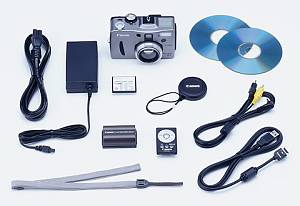 - Canon PowerShot G1 digital camera
- 1/1.8 inch 3.34 megapixel CCD. 3.24 megapixel effective rating. Images stored in JPEG (Super Fine, Fine or Normal compression) or RAW format (2048 x 1536 pixels only). Resolutions of 2048 x 1536, 1024 x 768 or 640 x 480 pixels.
- 7 - 21mm F2.0 - F2.5 3x optical zoom lens, equivalent to 34 - 102mm on a 35mm camera. 8 elements in 7 groups. Digital interpolation: 2X, 4X. Focusing range:
- Normal AF 70 cm - infinity (2.3 ft. - infinity)
- Macro AF 6 cm (wide)/ 20 cm (tele) - 70 cm (2.4 in. (wide)/ 7.9 in. (tele) - 2.3 ft.)
- Manual Focus 6 cm (wide)/ 20 cm (tele) - infinity (2.4 in. (wide)/ 7.9 in. (tele) - infinity)
- Real-image type optical zoom viewfinder with diopter adjustment and 1.8" TFT flip/tilt/swivel LCD display (97% coverage, anti-reflective coating).
- CompactFlash card storage (Type I and Type II) with support for IBM MicroDrive
- Mac/PC compatible USB/ RS232C/RS-422 computer connectivity. User-selecteable NTSC or PAL video connectivity with monaural audio
- TTL autofocus (continuous or single). Focus lock and Manual focus are available. Red-eye reduction lamp doubles as AF Auxiliary Light Emitter.
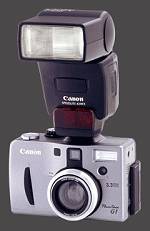 Mechanical and electronic shutter. Shutter speeds 8 - 1/1,000 second; 8 sec. shutter is available in Shutter-Priority mode or Manual mode. High-speed shutter setting from 1/640 to 1/1000 sec. are available only at F8 aperture setting. Slow shutter speeds of 1.3 sec. or more operates with noise reduction Mechanical and electronic shutter. Shutter speeds 8 - 1/1,000 second; 8 sec. shutter is available in Shutter-Priority mode or Manual mode. High-speed shutter setting from 1/640 to 1/1000 sec. are available only at F8 aperture setting. Slow shutter speeds of 1.3 sec. or more operates with noise reduction
- ISO ratings of 50, 100, 200 400, auto (ISO 50 & 100 only) or user selectable
- Center-weighted average metering or Spot metering
- Program AE, Shutter-priority AE, Aperture-priority AE or Manual exposure control. AE lock is available. Exposure compensation: +/- 2.0EV (in 1/3-stop increments)
- TTL auto white balance, pre-set white balance (available settings: Daylight, Cloudy, Tungsten, Fluorescent or Flash) or Custom white balance
- Built-in flash with Auto, Red-eye reduction auto, Red-eye reduction On, On or Off modes. Flash range 70 cm - 4.5 m (2.3 ft. - 14.8 ft.) at wide angle, 70 cm - 3.6 m (2.3 ft. - 11.8 ft.) at telephoto with sensitivity set to ISO 100
- Flash-sync terminals at accessory shoe. The following external flashes are recommended: Canon Speedlite 220EX, 380EX, 420EX and 550EX. Other flashes can be used but will be non-intelligent (ie. will fire at full strength). Maximum flash sync is 1/250 second.
- Flash exposure compensation: +/- 2.0EV (in 1/3-stop increments)
- Pan-focus, Portrait, Landscape, Night scene, Black & white, Stitch Assist and Movie modes
- Built-in microphone (front of camera) and speaker (left side of camera)
- Movie mode records Motion JPEG-conforming AVI movies with monaural sounds, 320 x 240 pixels at 15 frames per second up to 30 seconds per movie.
- Annotation feature records sound as a monaural wave file
- 10 second self-timer (Red-eye reduction lamp doubles as indication of self-timer)
- Infrared remote control included, with control of shutter, zoom and LCD display in "Record" mode, and LCD display with single or multi (9 images) and playback zoom (2.5 or 5x) with playback pan in "Play" mode. When shooting with remote control, image is captured 2 seconds after shutter button pressed . Infrared sensor is on front of camera (not visible from rear). Range of 5 meters (16.4 feet)
- PC-connected shooting over USB connection only. Proprietary software on the PC controls the camera over the USB connection (!)
- Continuous shooting : Approx. 1.7 image/sec. in Large/Fine mode with LCD viewfinder off
- Shutter lag of 0.07 seconds when camera is prefocused
- Metal tripod thread (left side of camera, not on central axis of lens)
- Design Rule for Camera File system (DCF), and Digital Print Order Format (DPOF) compliant
- Single, Multi, (9 thumbnail images), Magnified (approx. 2.5X or 5X on build-in LCD monitor) or Slide show playback modes
- Power from BP-511 rechargeable Lithium-Ion battery or AC adapter (both included in the camera kit), and Charge Adapter/Car Battery Cable Kit CR-560 (optional extra). Battery life of 800 images (LCD off), 260 images (LCD on) or 160 minutes of playback. Battery pack recharges in camera body with AC adapter.
- Operating environment: Temperature 0 - 40 degrees C (32 - 104 degrees F), Humidity 10 - 90 %
- Dimensions 119.7 x 76.8 x 63.8 mm (4.7" x 3.0" x 2.5") (excluding protrusions)
- Weight approx. 420 g (14.8 oz) (excluding batteries and CF card)
- Bundled with 16MB CompactFlash card, USB cable, Video cable, Lithium Ion battery and AC adapter. Software bundle includes TWAIN drivers, ZoomBrowser EX, PhotoStitch, RemoteCapture, Adobe Photoshop 5.0 LE for PC, and Plug-In Module, ImageBrowser, PhotoStitch, RemoteCapture and Adobe Photoshop 5.0 LE for Mac.
- Optional extras include LA-DC58 58mm threaded conversion lens adapter (required for use of add-on lenses), WC-DC58 0.8x wide converter, TC-DC58 1.5x tele converter and 250D close-up lens (allows focusing down to 12-20cm / 4.7-7.9" with the camera in macro mode)
- Scheduled for avilability in late October/early November in Europe at a price of €1250 (£765, ¥115,012, US$1071)
The Canon BeBit website has, as we mentioned earlier, published sample photos from the camera. At the time of this writing however, the links to the full-sized sample photos are faulty - but we have found the correct locations of the two samples images for you:
Sample photo 1
Sample photo 2
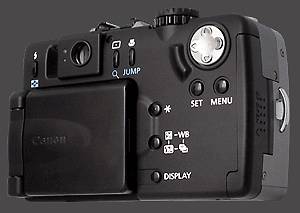
Source: DigitalKamera.de's Canon PowerShot G1 coverage

Foveon announces 16 megapixel CMOS sensor!
By Michael Tomkins, The Imaging Resource
(Monday, September 18, 2000 - 0:14 EDT)
 Silicon Valley-based Foveon Inc. has announced its manufacture of the world’s highest resolution Complementary Metal Oxide Semiconductor (CMOS) based image sensor. The 16.8 megapixel (4096 x 4096) image sensor, says Foveon, 'represents resolution and quality advances that were previously seen as unachievable for CMOS sensors. It is the first CMOS-based image sensor that exceeds the resolution and quality of Charge-Coupled Device (CCD) sensors'. Large photographs from the sensor and a working prototype digital camera will be on display September 20-25, 2000 at the Photokina trade show in Cologne, Germany. Silicon Valley-based Foveon Inc. has announced its manufacture of the world’s highest resolution Complementary Metal Oxide Semiconductor (CMOS) based image sensor. The 16.8 megapixel (4096 x 4096) image sensor, says Foveon, 'represents resolution and quality advances that were previously seen as unachievable for CMOS sensors. It is the first CMOS-based image sensor that exceeds the resolution and quality of Charge-Coupled Device (CCD) sensors'. Large photographs from the sensor and a working prototype digital camera will be on display September 20-25, 2000 at the Photokina trade show in Cologne, Germany.
Foveon notes that it has worked closely with its principle investor and manufacturing partner National Semiconductor Corporation, to increase CMOS sensor resolution and image quality, and improve CMOS imager manufacturing. The technological achievements being announced will, Foveon feels, have 'a profound impact towards bringing higher quality and lower costs to the future of digital photography'.
Image sensors made using CCD technology can be one of the most expensive components of today’s digital cameras. Production of CCD sensors requires fabrication facilities that are exclusively used for this type of chip. This specialization has limited the amount of money reinvested into updating CCD fabrication facilities to provide lower costs, higher resolution and improved image quality. As a result, high-resolution film-quality CCD sensors are expensive, which in turn contributes to the high price of high-quality digital cameras.
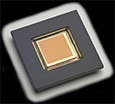 CMOS-based image sensors have been anticipated to significantly improve the price/performance of digital cameras thanks to the approximately $50 billion currently being invested into CMOS production facilities, which are used to manufacture a variety of computer chips, including microprocessors. Until now, however, CMOS image sensors have not replaced CCD sensors due to their poor image quality and low resolution. Foveon claims that its 16 megapixel image sensor 'represents a leap ahead of the entire CCD and CMOS image sensor industry in both resolution and quality'. CMOS-based image sensors have been anticipated to significantly improve the price/performance of digital cameras thanks to the approximately $50 billion currently being invested into CMOS production facilities, which are used to manufacture a variety of computer chips, including microprocessors. Until now, however, CMOS image sensors have not replaced CCD sensors due to their poor image quality and low resolution. Foveon claims that its 16 megapixel image sensor 'represents a leap ahead of the entire CCD and CMOS image sensor industry in both resolution and quality'.
The Foveon sensor is, the press release continues, about 3 times the resolution of any previously announced photographic CMOS image sensor, more than 50 times the resolution of the most commonly manufactured CMOS image sensors, and almost 3 times the data of the 6 megapixel CCD sensors found in today's highest resolution commercially available professional digital cameras."We are tremendously excited about this achievement. High resolution image sensors are what will accelerate the adoption rate of digital cameras and digital photography. Our sensor is the first viable 16 megapixel image sensor of any kind (CCD or CMOS) that can be produced in commercial volumes. Foveon has shattered the quality and resolution ceiling held by CCD sensors since their inception over 30 years ago,” said Dr. Carver Mead, the company’s founder. Current CMOS image sensors are made with 0.35 or 0.50 micron process technology, whilst Foveon’s 16 megapixel sensor is the first image sensor of any size to be manufactured with 0.18 micron CMOS process technology. The use of 0.18 micron processing enables more pixels to be packed into a given physical area, resulting in a higher resolution sensor. Transistors made with the 0.18 micron process are smaller and therefore do not take up as much of the sensor space, which can be used instead for light detection.“Our close working relationship with National Semiconductor has been a key to our success. National Semiconductor has a state-of-the-art 0.18 micron fabrication facility, is a world leader in low defect manufacturing and has the analog fabrication process expertise that is essential to manufacturing a sensor with this level of complexity,” said Richard Merrill, Foveon’s Senior Scientist and Chief Sensor Architect.
“The technical challenges have been formidable. With nearly 70 million transistors, the Foveon 16 megapixel sensor has almost 2.5 times the number of transistors as an Intel Pentium III,” said Brian Halla, Chief Executive Officer of National Semiconductor. "Without question, Foveon has made a quantum leap in analog chip design and in photography, " added Halla. The 4096 x 4096 sensor measures 22mm x 22mm and has an estimated ISO speed of 100 with a dynamic range of 10 stops. Shutter speeds are currently quoted from 2 seconds to 1/8000 of a second using an integrated fully-electronic shutter which eliminates another component of a camera: a mechanical shutter. Foveon's electronic shutter ensures that the exposure for all 16.8 million pixels is terminated at precisely the same moment with no lag between rows, columns or subset regions of the imager."Now that we have proven that the 16 megapixel sensor can be manufactured, over the course of the next 18 months we expect to see it in products for the high-quality professional markets, including professional cameras, film scanners, medical imaging, document scanning and museum archiving," said Eric Zarakov, Foveon's Vice President of Marketing. "Over the next few years we are, of course, anticipating our technologies to migrate down to the larger mass markets. It is a very exciting time in photography,” continued Zarakov.

Sunday, September 17, 2000
New digital imaging site; Olympus E-10 previewed!
By Michael Tomkins, The Imaging Resource
(Sunday, September 17, 2000 - 19:52 EDT)
We received an email from Mike's old home of Hong Kong today, with news of a new digital imaging website, photography.com.hk. Sam Cole, who emailed us, had the following to say on the launch:"Together with my colleague in Hong Kong, we started our own site for Digital Cameras (Bilingual Chinese & English versions available).
The first cover story published is about the beta/engineering sample E-10 supplied by Olympus Japan HQs. We did a hands-on report on it and took some Sample Photos with the beta version. We may be the first to make it available other than Japan.
You are cordially invited to visit, comment and hopefully you would share your experience with us. Thank you!" Check out the new site, and their Olympus Camedia E-10 Beta review...

Saturday, September 16, 2000
Remove dark current noise, enhance your pictures!
By Michael Tomkins, The Imaging Resource
(Saturday, September 16, 2000 - 18:44 EDT)
 An email from programmer Roman Voska of Media Chance, who has created such programs as RGB Lights (which combines three similar images to create special lighting effects) and CleanSkinFX (which smoothes out skin in portrait photos without affecting hair or background) has emailed us with news of an update to one of his programs, and another program which makes its debut! An email from programmer Roman Voska of Media Chance, who has created such programs as RGB Lights (which combines three similar images to create special lighting effects) and CleanSkinFX (which smoothes out skin in portrait photos without affecting hair or background) has emailed us with news of an update to one of his programs, and another program which makes its debut!
HotPixels Eliminator is designed to remove dark current "stuck" pixels which appear in long-exposures on digital cameras, as well as what Roman calls "blue noise chunks". The effect is a much smoother, cleaner final picture but with minimal effect to image detail.
A new version of Digital Camera Enhancer, meanwhile, includes the following updates:- The size on the screen is smaller.
- DCE 1.2 has now a rapid preview of the effect on the image. When you are in preview mode (default) you can slide the controls and you see the result without waiting. When you are satisfied, just press OK (in XTR) or Save (in Stand Alone) and the settings will be rendered in the full image.
- During the rendering, DCE writes which part of the enhancing process is doing.
- Zoom: Original Size - this will do the processing on the full original image. What you see is what will be saved. This is good if you want to verify sharpness or noise reduction effect on the image.
- Zoom: Preview Size (default) - DCE 1.2 has now a preview mode where the process will be rendered on a preview of the image. This is very fast and it allows you to test and see the changes almost in real time. After you press Save (or OK on XTR) the Enhancer will actually do the process on the full image. In preview mode you can clearly see the color adjusting but you can't sense the proper value of Enh. Details and De-Noiser. The actual effect could be different on the full size.
Digital Camera Enhancer is available as a stand-alone program, or a plug-in for Media Chance's own image editor, Photo-Brush.

Thursday, September 14, 2000
All at sea with digital photography! Why not? :)
By Michael Tomkins, The Imaging Resource
(Thursday, September 14, 2000 - 13:20 EDT)
Want to get away from it all on a cruise, and learn something at the same time? If so, then the '8-day Digital Workshop-At-Sea', embarking from Miami on December 3, 2000, may be just what you're looking for! The workshop, which will feature Digital Photography for beginning and intermediate photographers, is one of a series of cruises planned by photo-sharing site Zing, and will offer instruction in photodigital technologies in a relaxed learning environment.
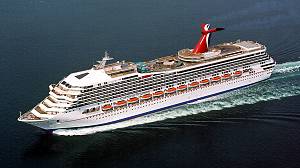
Each workshop attendee will, the press release notes, receive over $500 in gifts from participating sponsors including Kodak, Epson, Delkin, Tiffen, Tamrac, Red River paper, Quest, Unity Digital, Shortcourses, Pix.com, Microtech International, and others.
Both student work and pictures of class activities will be transmitted daily to Zing via satellite Internet facilities aboard Carnival Cruise Lines' newest superliner VICTORY so that, even if you can't attend, you can follow the progress of the cruise.
The cost of the cruise workshop starts at $1495 with non-attendee companions paying half-price. Scheduled ports of call include San Juan, St. Croix and St Thomas.
A total of 30 beginners and intermediates, will participate in lectures, demonstrations, and hands-on use of a wide range of equipment. They will also take photos, have them critiqued, and print them.
The lead instructor for the workshop will be Arthur H. Bleich, award-winning photographer, digital photography expert, educator, and Feature Editor of Digital Camera Magazine, along with other professionals from Zing.
Further information about the Zing Digital Photography Workshop At Sea can be found at Arthur Bleich's Digital PhotoCorner website...

Pentax planning to announce digital SLR!
By Michael Tomkins, The Imaging Resource
(Thursday, September 14, 2000 - 12:54 EDT)
 According to a news item from our friend Yamada Kumio over at the digitalcamera.gr.jp website, Asahi Optical Co. Ltd., which sells its cameras under the Pentax brand name, is planning to announce a new interchangeable-lens SLR with a 6 megapixel CCD at the Photokina 2000 show in Germany next week. The camera will feature a full 35mm-frame sized 6 megapixel CCD and a DSP both developed by Philips in a newly designed SLR body which is also to be announced at the show (presumably Yamada is referring to the camera body being used by a new film camera as well as the digital SLR). According to a news item from our friend Yamada Kumio over at the digitalcamera.gr.jp website, Asahi Optical Co. Ltd., which sells its cameras under the Pentax brand name, is planning to announce a new interchangeable-lens SLR with a 6 megapixel CCD at the Photokina 2000 show in Germany next week. The camera will feature a full 35mm-frame sized 6 megapixel CCD and a DSP both developed by Philips in a newly designed SLR body which is also to be announced at the show (presumably Yamada is referring to the camera body being used by a new film camera as well as the digital SLR).
The camera will also feature a Pentax KAF2 bayonet lens mount, which is compatible with K-mount, 645N and 67II lenses, and both a Type-II PC card and Type-II CompactFlash slot which can be used simultaneously. Files will be saved in TIFF, JPEG or RAW formats, and transferred over an IEEE 1394 (FireWire) connection. The camera will have a 2-inch LCD display, built-in retractable TTL flash unit, fixed pentaprism TTL optical viewfinder, 6-point autofocus system, shutter speeds up to 1/6000 second, and a magnesium alloy chassis.
No pricing or availability information is available yet... More on this camera as we get it! ;)
Source: Yamada Kumio / digitalcamera.gr.jp

Kodak Pro camera price cuts!
By Michael Tomkins, The Imaging Resource
(Thursday, September 14, 2000 - 11:00 EDT)
Following on from the previous news item on the subject of digital camera pricing, here's another resurrected news item from the midst of Mike's email troubles; Kodak recently announced a complete re-jig of its pro camera pricing.Here's a summary of the changes- DCS 560 and DCS 660 list prices cut from $24,995 to $15,995
- DCS 330 list price cut from $4,495 to $3,495
- DCS 315 list price cut from $2,995 to $1,795, and a 24-70mm IX-Nikkor lens added to the DCS 315 bundle
Kodak's press release also notes that "dealer incentives" are being offered on the DCS 620 and DCS 620x digital camera, although what the incentives are is unspecified. The release notes only that the cameras are available "for many hundreds less", and that the incentives will expire on October 15th, 2000.

Canon fixes EOS D30 pricing?
By Michael Tomkins, The Imaging Resource
(Thursday, September 14, 2000 - 10:41 EDT)
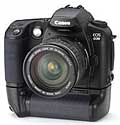 Our friends over at the Digital Photography Review website have posted news this week that Canon has fixed pricing of its EOS D30 SLR digital camera (which we recently reviewed) in two European markets. No source is quoted and we have been unable to locate the same information on Canon's website or in a press release ourselves, but we felt the information worth mentioning here regardless. Our friends over at the Digital Photography Review website have posted news this week that Canon has fixed pricing of its EOS D30 SLR digital camera (which we recently reviewed) in two European markets. No source is quoted and we have been unable to locate the same information on Canon's website or in a press release ourselves, but we felt the information worth mentioning here regardless.
The MSRP for the French market is quoted by Phil as being 18,395 FF (US$2418) + tax = 22,000 FF (US$2892); for Germany Phil lists prices of 5459 DM (US$2407) + tax = 6,499 DM (US$2866). Both of the before-tax prices are within €10 of the €2,800 mark, suggesting that Canon has chosen to fix the European pricing at €2,800 plus tax.
A related news item on the Rob Galbraith Online website notes, again without reference to a specific source, that Canon USA has fixed the EOS D30 pricing yesterday at US$3500, with an expected street price of US$3000. This matches exactly with Canon's own press release of May 17th which also quoted a price of US$3500...
Update 11:06 EST, an email from Phil Askey at the DPReview website notes that his source for the German price was the powershot.de website... Thanks, Phil!
Update 15:03 EST, an email from Matti Harju of the digicamera.net website notes that German retailer Computer Universe is currently listing the Canon EOS D30 at a retail price of 5,399 DM (US$2381 / €2760) - and this is with tax! Whilst we have no idea of the reputation of this German retailer, this does serve to give some idea of how the street price will likely compare to the MSRP. Thanks, Matti!
Thanks to Digital Photography Review / Rob Galbraith Online for this item!

Wednesday, September 13, 2000
Fuji announces FinePix 1300, 2400 ZOOM digital cameras!
By Michael Tomkins, The Imaging Resource
(Wednesday, September 13, 2000 - 16:52 EDT)
 Fuji Photo Film U.S.A., Inc. today announced the latest additions to its digital camera line: the FinePix 1300 and the FinePix 2400 ZOOM. The cameras are Fujifilm’s fifth and sixth introductions of 2000, with offerings ranging from entry-level shooters like the FinePix 1300 to professional cameras like the FinePix S1 Pro digital SLR. Fuji Photo Film U.S.A., Inc. today announced the latest additions to its digital camera line: the FinePix 1300 and the FinePix 2400 ZOOM. The cameras are Fujifilm’s fifth and sixth introductions of 2000, with offerings ranging from entry-level shooters like the FinePix 1300 to professional cameras like the FinePix S1 Pro digital SLR."At Fujifilm, we have a history of offering digital cameras that appeal to specific sectors of the market and the FinePix 1300 and FinePix 2400 ZOOM are no exceptions," remarked Darin Pepple, Product Manager, Consumer Digital Products, Fuji Photo Film U.S.A., Inc. "As a whole, digital photographers are a diverse lot with certain features and controls appealing to some, but not others. If there is one common denominator among them it’s the desire for colorful, true-to-life pictures and as a company world renowned for its color reproduction, we can deliver just that with our new digital cameras." Designed as 'the ultimate family camera' according to Fuji, the FinePix 1300 builds upon the tradition of the sub-$300 digital cameras such as Fujifilm’s MX-1200. Sporting a 1.3 megapixel CCD, the FinePix 1300 records images at resolutions up to 1280 x 960, suitable for 4 x 6- and 5 x 7-inch prints."With the picture-taking ability of the FinePix 1300 there has never been a better time for families to make the leap into digital photography," said Pepple. "This starter model, with its quality image reproduction and transferability, is a superb, entry-level digital camera." While the FinePix 1300 was designed for families and beginners, the FinePix 2400 ZOOM is, says Fuji, aimed at 'a more discerning digital photographer'. Featuring a 2.1 megapixel CCD in a point-and-shoot camera body, the FinePix 2400 ZOOM captures images through an aspherical 3x optical zoom lens that has a range equivalent to that of a 39mm-117mm zoom in the 35mm format. And, according to Fuji, the FinePix 2400 ZOOM has a bevy of easy-to-find features that make it easy for just about anyone to pick up the camera and take pictures."Rather than have most of the key controls placed within an internal menu system, we pulled the controls 'out' of the FinePix 2400 ZOOM and placed them on the body of the camera for ease of operation," explained Pepple. "This makes the camera very user friendly, allowing just about anyone who has operated a camera, film or digital, to take pictures with the FinePix 2400 ZOOM." The Fujifilm FinePix 2400 ZOOM and Fujifilm FinePix 1300, which will both ship with Adobe PhotoDeluxe Home Edition 3.0 software, will be available in September and October, respectively. The FinePix 2400 ZOOM will be available at an estimated street price of $499, while the FinePix 1300 will retail for approximately $249.
Following are specifications on each of the new cameras:
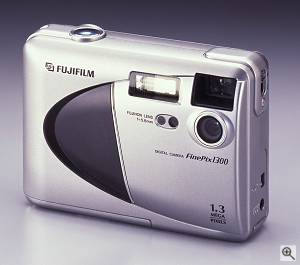 - Fujifilm FinePix 1300 Digital Camera
- 1/2.7-inch 1.3 megapixel CCD, 36 bit color depth (12 bit per channel). Gives files at resolutions up to 1280 x 960 pixels.
- Fixed focus, fixed focal length lens equivalent to 36mm on a 35mm camera. 2X Digital interpolation in VGA mode only. Macro focusing to 3.1 inches.
- 1.6-inch D-TFD LCD display (55,000 pixels) and Optical viewfinder
- SmartMedia storage (3.3V, 2-64MB); 8MB SmartMedia card bundled
- Mac/PC compatible USB connectivity
- Built-in Flash (effective range: 2.6 in. to 9.8 ft.) with Auto, Red-Eye, Forced Flash, Suppressed, Slow Sync modes
- Rated at ISO 125
- Automatic selection of shutter speeds from 1/2 to 1/1000 second.
- Files saved in 24-Bit JPEG (EXIF) with 3 compression levels (1/4, 1/8, 1/16)
- Auto plus 6 Manual Preset white balance settings
- Program AE exposure, manual Exposure Compensation
- 64-zone TTL metering
- DPOF Compliant
- Auto Power Off Disable
- Playback Modes are Auto Playback, 9-up, Zoom, Resize, DPOF
- Burst Mode: 2 frames/sec. up to 9 frames (VGA)
- Self Timer
- Continuous Exposure mode in 640 x 480 only
- Exposure Interval 2.2 seconds with LCD off
- Booting Time 1 sec.
- Power from Alkaline, Ni-MH, Ni-CD AA batteries or optional DC5V AC adapter
- Dimensions of 4.3" x 3" x 1.4"; weight of 7.1 ounces
- Estimated Street Price US$249.00; available in October 2000
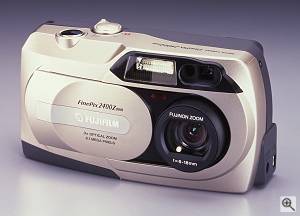 - Fuji FinePix 2400 ZOOM Digital Camera
- 1/2.7-inch 2.1 megapixel CCD, 36 bit color depth (12 bit per channel). Gives files at resolutions up to 1600 x 1200 pixels.
- 3x Aspherical Fujinon optical zoom lens, F3.5/F8.7 . Equivalent to 39-114mm on a 35mm camera. 2.5x Digital interpolation. Macro focusing from 3.9" to 2.6'; Auto focusing from 2.6 ft. to infinity
- 1.6-inch D-TFD LCD display (55,000 pixels) and Optical viewfinder
- SmartMedia storage (3.3V, 2-64MB); 8MB SmartMedia card bundled
- Mac/PC compatible USB connectivity
- Built-in Flash (effective range: 1 ft. to 8.6 ft.) with Auto, Red-Eye, Forced Flash, Suppressed, Slow Sync modes
- Rated at ISO 100
- Automatic selection of shutter speed from 1/2 to 1/750 second.
- Files saved in 24-Bit JPEG (EXIF) with 3 compression levels (1/5, 1/11, 1/27)
- Auto plus 6 Manual Preset white balance settings
- Program AE exposure, manual Exposure Compensation
- 64-zone TTL metering
- DPOF Compliant
- Auto Power Off Disable
- Playback Modes are Auto Playback, 9-up, Zoom, Resize, DPOF
- Continuous Exposure mode in 640 x 480 only
- Exposure Interval 2.2 seconds with LCD Off
- Booting Time 3 sec.
- Self Timer
- Power from Alkaline, Ni-MH, Ni-CD AA batteries or optional DC5V AC adapter
- Dimensions of 4.96" x 2.5" x 2.1"; weight of 8.8 ounces
- Estimated Street Price $499.00; available in September 2000

Tuesday, September 12, 2000
One answer to RDC-7 exposure issues? (!)
By David Etchells, The Imaging Resource
(Tuesday, September 12, 2000 - 23:57 EDT)
Reader Ron Tolmie posted the results of a very interesting experiment that might explain some of the variable results some users have reported with the Ricoh RDC-7 in some exposure situations. (His specific results seem to only apply to flash exposures, but it looks like he's definitely pinned down part of the problem.) Check his discussion thread in the IR RDC-7 forum!
Source: Exposure comment thread in IR RDC-7 forum

FULL Imaging Resource review of Sony DSC-P1 posted!
By David Etchells, The Imaging Resource
(Tuesday, September 12, 2000 - 15:50 EDT)
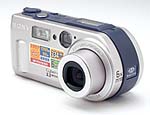 Wow, good things really *do* come in small packages! We've just completed and posted our full review of Sony's new ultra-compact DSC-P1 digicam, with a FULL set of our reference images, which will also be available in the Comparometer(tm) by the end of the day. We were unusually impressed by the P1, given the very high quality images it produces despite its small size. We characterized it as a "no excuses" ultracompact, producing image quality and having capabilities every bit on a par with much larger cameras. Wow, good things really *do* come in small packages! We've just completed and posted our full review of Sony's new ultra-compact DSC-P1 digicam, with a FULL set of our reference images, which will also be available in the Comparometer(tm) by the end of the day. We were unusually impressed by the P1, given the very high quality images it produces despite its small size. We characterized it as a "no excuses" ultracompact, producing image quality and having capabilities every bit on a par with much larger cameras.
We also got a chance to play with Sony's unique "Marine Pack", a superbly-engineered underwater housing for the DSC-P1 that's waterproof to 100 feet (30m). If we were impressed with the design and functioning of the P1 itself, adjectives fail us at the beautiful design of the Marine Pack: You can really control just about every function of the camera from outside the case, all the buttons and pure stainless steel, firmly spring-loaded to prevent accidental actuation at depth, and everything is securely o-ring sealed. A beautiful piece of work! (If you have any interest in underwater digital photography, this is absolutely the digicam for you!) Check the review for all the details!
Source: Imaging Resource full review of DSC-P1

UPDATE: Lots more on Sony's DSC-P1!
By Michael Tomkins, The Imaging Resource
(Tuesday, September 12, 2000 - 11:17 EDT)

We told you earlier this morning about a new camera from Sony, the DSC-P1, which features a 3x optical zoom and 3 megapixel resolution in a chassis which is Sony's smallest yet; Sony's announcement on the camera is scheduled for 11AM EST today, however the Digital Photography Review posted specifications earlier this morning on the camera, allowing us to release the same information as it was already publicly available. Well, the folks over at the DPReview have now posted a full review of the camera, which basically means that the camera has been publicly unveiled; as such we're happy to bring you the full specifications. We also have our own review of the DSC-P1 on the way, expected to go online later today! In the meantime, here's an updated specs list, and a couple of new images of the camera itself:
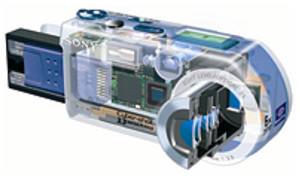 - Sony DSC-P1 digital still camera
- 1/1.8" 3.34 megapixel Super HAD RGB interlaced CCD image sensor. 3.24 megapixel effective rating. Image sizes of QXGA (2048 x 1536), 3:2 (2048 x 1360), UXGA (1600 x 1200), XGA (1024 x 768), and VGA (640 x 480). 12-bit A/D converter; JPEG, uncompressed TIFF or GIF (Text mode and Clip Motion mode) storage.
- 8-24mm 3x optical zoom lens, equivalent to 39-117mm on a 35mm camera. F2.8 - F5.3. 6x "precision" digital zoom. Focuses infinity to 0.5 meters, or 0.5 meters to 0.1 meters in macro mode.
- 1.5" Diagonal, 123,000 pixel precision LCD display and optical viewfinder
- MemoryStick storage media; 8MB MemoryStick card bundled
- USB connectivity, compatible with Mac and Windows and NTSC/PAL user-switcheable video out
- Four-mode internal flash (Auto, Anti-Red Eye, Forced-Flash and No flash modes). Range of 0.5 to 2.3 meters (wide) or 0.5 to 1.2 meters (tele)
- Built-in mono microphone and speaker with volume control
- High-speed scan autofocus system
- Shutter speeds 2 to 1/2000 second, automatically selected
- Auto exposure with +/- 2.0EV exposure compensation in 1/3EV steps.
- Program AE exposure (Twilight, Twilight+, landscape, Pan-focus and Spot-meter modes)
- Auto/Indoor/Outdoor/Hold white balance settings
- 5 user-selectable sharpness settings
- Auto-orientation feature automatically detects orientation of camera and tags image accordingly before saving so that it is displayed upright in playback mode.
- Movie mode with sound MPEG video file, 320 x 240 at 15 (HQ) or 8 (Normal) frames per second for 5, 10 or 15 seconds. Video Email mode captures up to 60 seconds of 160 x 112 MPEG video.
- Clip motion mode captures up to 10 images at 0.5 second intervals, and combines them into a GIF animation with size < 200KB. Resolutions of 160 x 120 pixels (normal) or 80 x 72 pixels (mobile)
- Voice memo mode allows annotation of images with audio
- EXIF information such as shutter speed, exposure info etc. automatically recorded with each image
- Email mode stores a low-resolution *VGA (320 x 240) file in a separate folder from the original image
- Text mode saves images as a black and white GIF file
- 5x playback zoom, 640 x 480 trim and resize capability. Zoomed/trimmed images can be saved as a new file, not affecting the original.
- File protection and deletion (selected or all images)
- Slide-show mode
- Ability to superimpose date/time on images
- 4 in-camera picture effects (sepia, black and white, negative and solarization)
- 10 second self-timer
- Power from Sony NP-FS11 InfoLithium batteries Lithium Ion batteries with AccuPower time-remaining display. Battery and charger included. Up to 90 minutes / 1700 shots of continuous usage without flash.
- Power consumption 3.0 watts (LCD on); 2.2 watts (LCD off)
- Bundled with 8MB MemoryStick, NP-FS11 battery and AC adapter/charger, AV cable, USB cable, USB software, MGI PhotoSuite 8.1 (Win), MGI VideoWave SE (Mac)
- Optional extras include the MPK-1 Marine Pack for using the camera in rain or underwater up to 30 meters (100 feet). Most camera functions accessible by spring-loaded, O-ring sealed stainless steel operation keys on Marine Pack. (see photo below), LCS-P1 soft carrying case (blue, green, yellow, orange; all except blue are limited production), LCS-HGP1 leather soft case, VF-MP1K Marine Pack Color Filter Kit, VCT-MP1K Marine Pack Video Light Arm Kit, HVL-ML20 Underwater Video Light
- Dimensions of 113 x 53.9 x 43.8mm, 4 7/16" x 2 1/8" x 1 3/4".
- Weighs 250 grams with battery, media and wrist-strap, 208 grams without battery or media.
- Will ship in Japan on October 20 at a price of ¥99,800 (US$941) with a monthly production of 150,000 units worldwide expected.
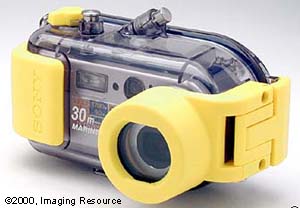
Sony Japan is promoting the camera as compatible with its I-Jump service, also to be launched October 20, which allows PC users to send color images over the web to NTT DoCoMo i-mode mobile phones. On top of this, Sony Japan is also emphasising that the DSC-P1 can be used with its PlayStation II games console and Picture Paradise software to view/edit pictures, and with the PrintFan software/hardware to make photo prints, all without the need for a personal computer. Check back for our in-depth review of the DSC-P1 later today, complete with standardized comparison images!
Update 11:08 EST, Steve's Digicams has now posted their review of the DSC-P1, noting: "I can say without reservation that the Sony DSC-P1 is the most impressive of all of the "ultra compact" digicams we have reviewed to date. It may be small in size but there's nothing small about the 2048x1536 pictures that it creates. The focus system is highly accurate even in low light conditions and the white balance system works flawlessly even in mixed-light environments. The overall image quality, sharpness and color balance is on the same level as cameras three times its physical size. The P1 is an excellent choice for anyone that wants a camera that can be easily carried in their pocket or purse."
Update 11:22 EST, Japanese website PC Watch has also posted info on the DSC-P1, with several photos of the camera itself including an interesting 'exploded' view of the camera dismantled in a display case, and a look at the circuit boards out of the camera.

Sony announces DSC-P1 digital camera!
By Michael Tomkins, The Imaging Resource
(Tuesday, September 12, 2000 - 9:03 EDT)
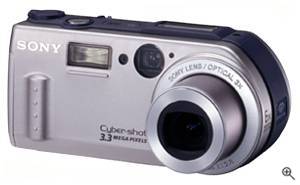
Sony USA will today announce their DSC-P1 digital camera, a 3 megapixel unit with 3x optical zoom, MemoryStick storage and a very small form factor... Here's the specifications:- Sony DSC-P1 digital still camera
- 1/1.8" 3.34 megapixel Super HAD CCD image sensor. Image sizes of QXGA (2048 x 1536), 3:2 (2048 x 1360), UXGA (1600 x 1200), XGA (1024 x 768), and VGA (640 x 480). JPEG, TIFF or GIF (Text mode and Clip Motion mode) storage.
- 8-24mm 3x optical zoom lens, equivalent to 39-117mm on a 35mm camera. F2.8 - F5.3.
- 1.5" Diagonal, 123,000 pixel precision LCD display and optical viewfinder
- MemoryStick storage media; 8MB MemoryStick card bundled
- USB connectivity, compatible with Mac and Windows
- Four-mode internal flash (Auto, Anti-Red Eye, Forced-Flash and No flash modes)
- Auto exposure with +/- 2.0EV exposure compensation in 1/3EV steps.
- Program AE exposure (Twilight, Twilight+, landscape, Pan-focus and Spot-meter modes)
- Auto/Indoor/Outdoor/Hold white balance settings
- Movie mode with sound (MPEG HQ video file, 320 x 240 or 160 x 112 pixel resolution). Up to 15 frames per second in all resolutions.
- Clip motion mode captures up to 10 images and combines them into a GIF animation
- Playback zoom, trim and resize capability
- Power from Sony NP-FS11 InfoLithium batteries Lithium Ion batteries with AccuPower time-remaining display. Battery and charger included. Up to one hour of continuous usage without flash.
- Optional extras include a marine housing for using the camera in rain or underwater
- Dimensions of 113 x 53.9 x 43.8mm, 4 7/16" x 2 1/8" x 1 3/4".
- Weighs 250 grams with battery and media.
We'll have much more detail on this camera later today, so keep checking back!
Update 08:14 EST, Reuters has reported on the Japanese announcement of the DSC-P1. The DSC-P1 will launch October 20 in Japan at a price of ¥99,800 (US$940), with plans to ship 150,000 units monthly worldwide.

Olympus announces portable dye-sub printer!
By Michael Tomkins, The Imaging Resource
(Tuesday, September 12, 2000 - 0:31 EDT)
One we missed from a little while back in the midst of Mike's computer hassles, but worth going back for - Olympus America Inc. has introduced the Camedia P-200 Printer, what it describes as a 'professional-quality, high-speed dye-sublimation portable printer'. The Camedia P-200 Printer brings photo-quality dye-sub printing capability on the road with you!"The Camedia P-200 printer is the missing piece in the puzzle of digital photography. Now our customers can produce high quality images anywhere, anytime, without cables or the need to first download images to a PC," said Mark Gomz, President of Olympus America. "It really untethers the digital photographer from the PC, and answers the need for mobility in our increasingly wireless world." The P-200 is targetted at applications ranging from test prints at on-location shoots to real estate, travel, insurance, law enforcement (accident and crime scenes).
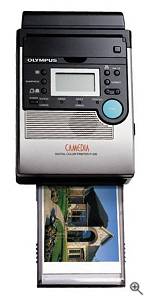 Utilizing dye sublimation printing technology, the Camedia P-200 Printer produces continuous tone images at a resolution of 320 dots per inch. The printer supports 128 gradation levels per color for smooth color transitions, and delivers finished A-6 size prints (3" x 4" print area) in about 90 seconds. The Camedia P-200 Printer employs 4-pass printing technology, one each for the Cyan, Magenta and Yellow primary colors, plus a UV overcoat layer to seal and protect the image. Utilizing dye sublimation printing technology, the Camedia P-200 Printer produces continuous tone images at a resolution of 320 dots per inch. The printer supports 128 gradation levels per color for smooth color transitions, and delivers finished A-6 size prints (3" x 4" print area) in about 90 seconds. The Camedia P-200 Printer employs 4-pass printing technology, one each for the Cyan, Magenta and Yellow primary colors, plus a UV overcoat layer to seal and protect the image.
The Camedia P-200 Printer is compatible with a number of Olympus filmless digital cameras, including the new Camedia E-10 and E-100 RS models introduced simultaneously with the P-200. It is also planned to function with upcoming Olympus digitals. Like the new E-10 and E-100 RS models, the Camedia P-200 Printer has dual media slot capability. Users simply insert either a SmartMedia or Type I or II CompactFlash card directly into the appropriate media slot, select the desired image number, and press print. The Camedia P-200 Printer outputs full-size images; 2, 4, 9, or 16 images per page; and 40-image index prints. The P-200 is compatible with Digital Print Order Form (DPOF) technology for image scheduling and number setting; as well as DCF (Design Rule for Camera File System), JPEG and TIFF file formats.
The Camedia P-200 Printer offers image manipulation capabilities including a three-step sharpness control, the ability to crop images and add the time and date to prints. A Copy function allows users to program the Camedia P-200 Printer to produce up to 25 prints in a single job. The 25-sheet paper cassette matches the 25-print ribbon capacity of the printer, eliminating any confusion as to when to change the ribbon, and the risk of producing sub-par prints."This introduction broadens our product reach, and is evidence of Olympus’ total commitment to the digital photographer," said Gomz. "We want the marketplace to view Olympus as the leading single-source provider for all digital imaging applications, from capture to output. The Camedia P-200 Printer, with its outstanding image quality, will help us achieve that objective." The Camedia P-200 Printer has dimensions of 4.8" (W) x 2.1" (H) x 6" (D) and a total weight of 30 ounces, making it easy for users to carry in standard camera gadget bags. The Camedia P-200 Printer kit comes complete with NiMH (Nickel-Metal-Hydride) rechargeable batteries that provide 50 prints between recharges, AC adapter, paper cassette, trial paper pack with color ink ribbon cartridge, plus an instruction manual, warranty and registration cards. The Camedia P-200 will be available October, 2000 for an estimated price of US$599. Additional paper packs will cost US$24.95 per pack (25 sheets with ribbon) from Olympus.

Kodak announces 5.1, 16.6 megapixel image sensors!
By Michael Tomkins, The Imaging Resource
(Tuesday, September 12, 2000 - 0:12 EDT)
Eastman Kodak Co. has announced the latest additions to its line of Kodak Blue Plus Color CCDs, the KAF-5100CE and the KAF-16801CE. These image sensors, says Kodak, 'reinforce its position as the world’s leading supplier of large-format, full-frame CCDs for high performance digital imaging applications.'
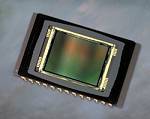 The KAF-5100CE is a 5.1 million pixel CCD image sensor based on a 6.8 micron pixel architecture. The sensor’s 4/3-inch optical format provides a light capturing surface which is six times larger than the half-inch CCDs found in many of today’s consumer and advanced-amateur digital cameras. The sensor delivers features typically found in professional-grade digital cameras such as high resolution, ultra-low image noise and outstanding color fidelity yet at a price point Kodak feels is ideal for the advanced-amateur market. The 2614 x 1966 pixel array is packaged in a 26-pin ceramic package. The KAF-5100CE is a 5.1 million pixel CCD image sensor based on a 6.8 micron pixel architecture. The sensor’s 4/3-inch optical format provides a light capturing surface which is six times larger than the half-inch CCDs found in many of today’s consumer and advanced-amateur digital cameras. The sensor delivers features typically found in professional-grade digital cameras such as high resolution, ultra-low image noise and outstanding color fidelity yet at a price point Kodak feels is ideal for the advanced-amateur market. The 2614 x 1966 pixel array is packaged in a 26-pin ceramic package."Kodak’s ability to deliver large silicon sensors is a tremendous advantage given the current trends in the digital camera marketplace," said Chris McNiffe, vice president, Sales & Marketing, Image Sensor Solutions, Eastman Kodak Company. "Today, CCD manufacturers increase the resolution of their sensors by continually shrinking the size of each pixel which ultimately limits dynamic range and image quality. Kodak’s expertise in delivering high quality, large format sensors is a key advantage for us in the digital camera marketplace as performance and image quality, not simply pixel count, become the primary differentiating factor." 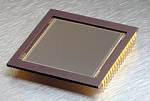 The KAF-16801 is designed for the studio and high-end digital camera marketplace and features a whopping 16.6 million (4080 x 4080) pixel resolution. The device incorporates a nine micron pixel architecture and is packaged in a 34-pin DIP ceramic package. The KAF-16801 is designed for the studio and high-end digital camera marketplace and features a whopping 16.6 million (4080 x 4080) pixel resolution. The device incorporates a nine micron pixel architecture and is packaged in a 34-pin DIP ceramic package.
The KAF-16801CE, with its ultra-high resolution and large pixel size, meets requirements of studio photographers, Kodak feels, by providing superior dynamic range and low noise.
Both new devices utilize Kodak's patented Blue Plus Color process, which incorporates proprietary on-chip color filter arrays, providing enhanced photo-responsivity. The devices are ideal for performance imaging applications in the digital still camera marketplace where superior image quality is required, the press release continues.
Samples of both the KAF-5100CE and the KAF-16801CE are available immediately from Eastman Kodak Co. Evaluation boards and reference design for each sensor are also available.

Monday, September 11, 2000
New megapixel CCD with integrated shutter/clock driver, CDS unit!
By Michael Tomkins, The Imaging Resource
(Monday, September 11, 2000 - 22:16 EDT)
Eastman Kodak Co. has introduced the Kodak Digital Science KAI-1020 image sensor, a new one megapixel interline CCD imager which integrates most of the discrete components previously required to build a digital camera system. The device is designed to allow Kodak customers to more easily develop cost-effective, power efficient cameras.
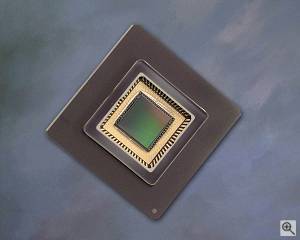
One of the most complex elements of digital camera design is, according to Kodak, the need to control the multiple clock signals at various voltages that drive the electronic shutter and then transfer the image through and out of the CCD. The KAI-1020 is designed to simplify this design process by integrating an on-chip shutter driver, vertical clock driver and a correlated double sampling unit on the same die as the CCD. The level of integration offered by the KAI-1020 reduces the number of components required to build a digital camera, resulting in smaller size, lower power consumption and lower cost."The launch of the KAI-1020 is another example of Kodak innovation and expertise in CCD imaging," said Chris McNiffe, vice president, Sales & Marketing, Image Sensor Solutions, Eastman Kodak Company. "A key part of our product strategy is to continue to simplify the development process for our customers without compromising performance or image quality. The KAI-1020 is an excellent example of this strategy in action." The progressive scan architecture and global electronic shutter 'provide excellent image quality for full motion video and still image capture', according to Kodak. Combining its resolution and light sensitivity with a frame-speed, the KAI-1020 is targetted at a range of applications, including machine vision, industrial control cameras and scientific and medical imaging products.
Features of the KAI-1020 include:- Color and monochrome versions
- 1 million pixels, 1000 (H) by 1000 (V)
- 10 bits dynamic range at room temperature
- 7.4 mm square pixels for high sensitivity
- Progressive scan (non-interlaced)
- High frame speed (30 fps using one output; 48 fps with two outputs)
- Integrated vertical clock drivers
- Integrated correlated double sampling (CDS) up to 40 MHz
- Integrated electronic shutter driver
- Reversible HCCD capable of 40 MHz operation
- All timing inputs 0 to 5 volts
- Single or dual video output operation
- Fast line dump for high speed sub-window readout
- Anti-blooming protection
Samples and evaluation boards for the KAI-1020 are available immediately from Kodak. Pricing for the monochrome version starts at approximately $400 in 5,000 piece quantities.

Qimage Pro 9.1, Sony DSC-D7XX plugin released!
By Michael Tomkins, The Imaging Resource
(Monday, September 11, 2000 - 18:51 EDT)
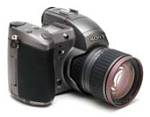 We just received the following email from Mike Chaney, author of the superb QImage Pro (a program we often use ourselves at the Imaging Resource), with news of a new version of the program which should be of particular interest to users of the recent crop of 3-megapixel digicams, and a new plugin for users of Sony's Cyber-shot Pro DSC-D700, DSC-D770 and DKC-FP3 cameras: We just received the following email from Mike Chaney, author of the superb QImage Pro (a program we often use ourselves at the Imaging Resource), with news of a new version of the program which should be of particular interest to users of the recent crop of 3-megapixel digicams, and a new plugin for users of Sony's Cyber-shot Pro DSC-D700, DSC-D770 and DKC-FP3 cameras:
"Qimage Pro v9.1 was released today with a new filter that removes or drastically reduces color fringing. In addition, we have updated the exposure compensation filter to give users control over the clipping values and therefore the amount of "pop" being added to images. Finally, we also released the Sony D770 color profile plugin which results in quite a dramatic improvement in color for the D770 as well as the D700. Info and samples for the new plugin can be obtained by clicking on the D770 link at the Qimage Pro plugins page. Additional information and samples regarding the new color fringing filter can be seen in the Qimage Pro website news section."QImage Pro is probably one of the best-supported and most-often updated shareware imaging programs we've seen. If you've not tried it before, be sure and check it out!
Source: Qimage Pro website

Kodak Image Sensor division opened up to OEMs!
By Michael Tomkins, The Imaging Resource
(Monday, September 11, 2000 - 18:35 EDT)
Eastman Kodak Co. has announced an initiative to market its solid-state sensor technology into worldwide digital imaging markets through the company’s Image Sensor Solution division. Kodak has redefined the ISS business charter to enable the division to market Kodak's image sensor technology directly to original equipment manufacturers as well as other business units within Kodak. The new initiative will allow Kodak to realize additional revenue and earnings opportunities from its core digital imaging technology.
Until recently, Kodak’s ISS Division existed primarily to supply products and services to other Kodak divisions for use in film and paper scanners, professional digital cameras, and various government programs. Under its new charter, ISS will expand more broadly into external markets by finding new applications and revenue opportunities for Kodak image sensor products.
As part of the new thrust, Kodak has hired three semiconductor industry veterans to drive ISS's strategy and operations. Dona Flamme, the new division General Manager and Vice President, brings experience in senior management and technical marketing from Micrel Semiconductor and NCR Microelectronics to ISS. Chris McNiffe, who has held a variety of sales and marketing management positions with 8x8, Inc., NCR Microelectronics, and RCA Solid State, has been hired as Vice President for Marketing and Sales for ISS. Alan Sabanosh recently joined Kodak as Director of Operations for ISS. Mr. Sabanosh has extensive experience in managing wafer fab and Quality operations from GMT Microelectronics and Commodore Semiconductor."The image sensor product line carries forward Kodak’s century-long tradition as the world’s imaging leader," stated Dona Flamme, general manager and ISS, and vice president, Digital & Applied Imaging. "ISS will extend and open up opportunities for Kodak’s high-performance image sensors to be integrated in all cutting-edge digital imaging products and solutions." Kodak notes in its release that it is the only supplier to offer a complete line of imagers spanning multiple device platforms – full-frame devices for professional and "prosumer" digital cameras; interline devices for consumer digital cameras and industrial applications; linear devices for scanners and CMOS sensors for low-power, cost-conscience applications. Kodak offers devices that range in resolution from VGA up to over 16 million pixels, and all are designed to offer 'best-in-class' performance in terms of image quality, frame rate, low noise, and high dynamic range.

Motorola, Kodak cooperate on CMOS sensors!
By Michael Tomkins, The Imaging Resource
(Monday, September 11, 2000 - 18:11 EDT)
 Eastman Kodak Co. has announced the latest additions to its line of Kodak Digital Science image sensors and the first to be based on CMOS technology. The KAC-0310 VGA sensor and the KAC-1310 Megapixel sensor, says Kodak, 'represent a unique application of Kodak’s twenty-plus years of imager research to today’s most mainstream, high volume manufacturing process'. Kodak’s new family of CMOS imagers offer performance features commonly found in CCD devices yet at the cost, integration and power consumption levels that have made CMOS imagers so popular, the press release continues. Eastman Kodak Co. has announced the latest additions to its line of Kodak Digital Science image sensors and the first to be based on CMOS technology. The KAC-0310 VGA sensor and the KAC-1310 Megapixel sensor, says Kodak, 'represent a unique application of Kodak’s twenty-plus years of imager research to today’s most mainstream, high volume manufacturing process'. Kodak’s new family of CMOS imagers offer performance features commonly found in CCD devices yet at the cost, integration and power consumption levels that have made CMOS imagers so popular, the press release continues.
Kodak feels that its new CMOS imagers have superior image quality, high light sensitivity, true color fidelity and low noise. Both devices utilize Kodak’s patented 'pinned photodiode' active pixel structure, which provides higher ISO capability compared to other CMOS devices.
Kodak’s CMOS devices are highly integrated image sensors featuring on-chip timing, programming control, analog signal processing and a 10-bit analog-to-digital converter to deliver a 'camera-on-a-chip' imaging solution. This enables the design of smaller, more portable, lower cost systems which consume less power. The devices are offered in both monochrome and color versions, with and without microlenses which further enhance sensitivity. The color devices are available in both Bayer and complementary array patterns and utilize Kodak’s proprietary color filter materials to improve color reproduction."This announcement represents the first application of Kodak’s wealth of imaging expertise and technology into the CMOS marketplace," said Chris McNiffe, vice president, Sales & Marketing, Image Sensor Solutions, Eastman Kodak Company. "Kodak has been a leading innovator in the imager marketplace for many years. Our CMOS imagers are a natural extension of Kodak’s product line and will allow us to address a much broader market than we currently serve with our CCD products." 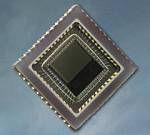 Kodak’s KAC-0310 VGA CMOS image sensor is a 640 x 480 pixel array in a 1/3" optical format using a 7.8 micron pinned photodiode active pixel structure. The KAC-0310 incorporates Kodak’s patented 'global shutter' technology which reduces image blur by simultaneously exposing the entire pixel array rather than sequencing the exposure line by line as is typical of other CMOS devices on the market today. The image size is programmable to a user defined window of interest and allows sub-sampling to provide the higher frame rates needed for auto-exposure and auto-focus functions. It operates with a single 3.3V power supply and requires only a single master clock to operate. It is housed in a 48 pin ceramic LCC package. Kodak’s KAC-0310 VGA CMOS image sensor is a 640 x 480 pixel array in a 1/3" optical format using a 7.8 micron pinned photodiode active pixel structure. The KAC-0310 incorporates Kodak’s patented 'global shutter' technology which reduces image blur by simultaneously exposing the entire pixel array rather than sequencing the exposure line by line as is typical of other CMOS devices on the market today. The image size is programmable to a user defined window of interest and allows sub-sampling to provide the higher frame rates needed for auto-exposure and auto-focus functions. It operates with a single 3.3V power supply and requires only a single master clock to operate. It is housed in a 48 pin ceramic LCC package.
Kodak’s 1.3 megapixel KAC-1310 CMOS sensor shares many of the features of the KAC-0310. The megapixel imager is a 1280 x 1024 pixel array in a half-inch optical format using a 6 micron pinned photodiode pixel structure. The sensor output is 8 or 10 digital bits and it supports both progressive or interlace scan modes. The chip is packaged in a 48-pin ceramic LCC package.
 Kodak’s CMOS imagers are the first commercial sensors to be produced through a joint development agreement between Kodak and Motorola. Both devices are fabricated in the ImageMOS process jointly developed and patented by the companies. Kodak’s CMOS imagers are the first commercial sensors to be produced through a joint development agreement between Kodak and Motorola. Both devices are fabricated in the ImageMOS process jointly developed and patented by the companies.
Kodak’s VGA CMOS image sensor is available immediately in full production quantities. Samples of the 1.3 megapixel sensor will be available by the end of this year.

Epson announces 3 new photo printers from $99!
By Michael Tomkins, The Imaging Resource
(Monday, September 11, 2000 - 17:36 EDT)
 Epson America Inc. has announced its new line of four-color ink jet printers designed for business, small office and home users, starting at a cost of US$99. The EPSON Stylus Color 777, Stylus Color 880, Stylus Color 980 and Stylus Color 980N all offer faster speeds and greater ease of use over their predecessor models, Epson claims, and offer photo-quality printing. Epson America Inc. has announced its new line of four-color ink jet printers designed for business, small office and home users, starting at a cost of US$99. The EPSON Stylus Color 777, Stylus Color 880, Stylus Color 980 and Stylus Color 980N all offer faster speeds and greater ease of use over their predecessor models, Epson claims, and offer photo-quality printing."This collection of printers represents our best line of consumer-level ink jet printers to date," said Steve Semos, product manager, consumer ink jet printers, Epson. "The fact that we were able to once again enhance our successful lineup of printers -- resulting in faster speeds, outstanding print quality and even lower prices -- truly makes this a winning combination that benefits our customers." Features of the new printers include up to 2880 x 720 dots per inch hardware resolution, twice that of Epson's previous models, as well as Epson's Advanced Micro Piezo technology, which delivers the industry's smallest ink droplet size.
All models in the line feature significantly faster output speeds on both color and black text printing as compared to their predecessors, Epson says.The printer software has also been changed to give greater saturation and better shadow and highlight detail to give the best print quality, and printing photo quality images is a standard feature out of the box with no other ink cartridges to buy, the press release continues.
The new double-sided/booklet printing feature enables easy printing on both sides of the paper, and animated 'Fix-It Flix' help users troubleshoot without referring to a manual.
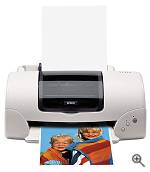 The EPSON Stylus Color 777 is, says Epson, 'tailored to meet the needs of consumers who want the most value for the lowest price'. Priced at US$99, the Stylus Color 777 printer features 2880 dpi resolution and four-picoliter droplets, as well as up to eight pages per minute in black text printing and up to six ppm for text and color graphics. The printer also features a new 'modern rounded industrial design'. The Stylus Color 777 uses Epson's 'Intelligent Ink' cartridge technology that enables users to remove and replace a cartridge that may be low on ink in order to complete larger print jobs. The original cartridge can be reinstalled later for smaller print jobs. The EPSON Stylus Color 777 is, says Epson, 'tailored to meet the needs of consumers who want the most value for the lowest price'. Priced at US$99, the Stylus Color 777 printer features 2880 dpi resolution and four-picoliter droplets, as well as up to eight pages per minute in black text printing and up to six ppm for text and color graphics. The printer also features a new 'modern rounded industrial design'. The Stylus Color 777 uses Epson's 'Intelligent Ink' cartridge technology that enables users to remove and replace a cartridge that may be low on ink in order to complete larger print jobs. The original cartridge can be reinstalled later for smaller print jobs.
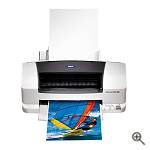 The EPSON Stylus Color 880 is aimed at more demanding consumers, and with a US$149 pricetag, delivers up to 12 ppm black text output and up to nine ppm text and color graphics for what Epson considers to be the fastest color printing in its class. It also combines 2880 dpi and four-picoliter droplets to deliver high print quality, and a printer mechanism that delivers ultra-quiet operation to minimize impact on the user's working environment. An optional external Ethernet interface is also available. The EPSON Stylus Color 880 is aimed at more demanding consumers, and with a US$149 pricetag, delivers up to 12 ppm black text output and up to nine ppm text and color graphics for what Epson considers to be the fastest color printing in its class. It also combines 2880 dpi and four-picoliter droplets to deliver high print quality, and a printer mechanism that delivers ultra-quiet operation to minimize impact on the user's working environment. An optional external Ethernet interface is also available.

Aimed at 'the user who demands the ultimate combination of outstanding print quality with blazing-fast output', Epson's Stylus Color 980 is priced at US$249 (a US$50 rebate brings this down to US$199), and offers the industry's smallest droplet at three picoliters and 2880 dpi resolution. The Stylus Color 980 delivers up to 13 ppm in its default normal mode. Users can also print color Microsoft PowerPoint pages in as little as 15 seconds and high-resolution (720 dpi) full-color 8" x 10" photos in approximately 78 seconds. The Stylus Color 980 features a 5,000 pages-per-month duty cycle and connectivity options for FireWire and Ethernet network solutions. An Adobe Postscript software option (Epson StylusRIP) will also be available later this fall.
The EPSON Stylus Color 980N, which will be available in mid-October, combines all of the output features found in the Stylus Color 980 with more advanced networking features. Priced at US$449, this printer offers a built-in 10/100 Mbit print server in addition to full multi-protocol support of networks such as TCP/IP, IPX/SPX, AppleTalk and NetBEUI. The Stylus Color 980N also includes network printer management software for management of all printers on the network and supports all printers that contain an MIB.
Each of these new printers is compatible with both Windows and Macintosh platforms and has both USB and parallel connectivity. Each model, except for the Stylus Color 980N, also comes with a software bundle that includes EPSON Film Factory for collecting and organizing digital photos and Trellix Web for creating personalized Web sites.
Additionally, Corel Printhouse is included specifically with the Stylus Color 777, and ArcSoft Photo Impression 2000 and ArcSoft Photo Montage are included with the Stylus Color 880 and Stylus Color 980.
Thanks to David Kamanski of the Digital Eye website for providing us with photos of these new printers!
Source: Yahoo! Finance / Business Wire

Sunday, September 10, 2000
Ricoh to announce digicam with Internet connectivity!
By Michael Tomkins, The Imaging Resource
(Sunday, September 10, 2000 - 1:44 EDT)
 Ricoh's PC Peripherals Business Unit will on Monday announce its new RDC-i700 digital camera. The RDC-i700 is in essence an Internet-connected Handheld PC and digital camera in a form factor similar to Ricoh's current RDC-7 digital camera, producing what the company calls 'an ultra-portable business productivity solution for anywhere, anytime image communications'. Ricoh's PC Peripherals Business Unit will on Monday announce its new RDC-i700 digital camera. The RDC-i700 is in essence an Internet-connected Handheld PC and digital camera in a form factor similar to Ricoh's current RDC-7 digital camera, producing what the company calls 'an ultra-portable business productivity solution for anywhere, anytime image communications'.
The 3.34-megapixel, Internet-ready RDC-i700 imaging tool provides the ability to capture images and video, send and receive e-mail with attachments, send images via fax, surf the Web, create image-rich documents and HTML files, and FTP data and images directly from the camera. The RDC-i700 will be available in Japan September 20, 2000 at a suggested retail price of ¥158,000 (~US$1,500) with a planned production of 5000 cameras per month.
The RDC-i700 is, says Ricoh, 'the first of a new breed of cameras that enable business users to enhance the workflow process'. By simply inserting a PC Card modem, LAN adapter, or storage card into the built-in PCMCIA Type II expansion slot, the RDC-i700 can serve as a mobile communications, workstation and presentation device. A separate CompactFlash slot and 8MB of built-in memory serve as image storage.
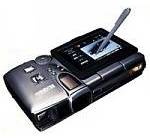 The RDC-i700 features a 'Virtual Assistant' that integrates Microsoft Word and Excel templates inside the camera to help generate data management, guided capture and text/HTML-based applications. It provides the ability to automatically populate pre-defined source files and then transfer the information directly to the PC. The RDC-i700 features a 'Virtual Assistant' that integrates Microsoft Word and Excel templates inside the camera to help generate data management, guided capture and text/HTML-based applications. It provides the ability to automatically populate pre-defined source files and then transfer the information directly to the PC."The Ricoh RDC-i700 does it all, making it the 'Swiss Army Knife' of digital cameras," said Jeff Lengyel, digital camera manager of Ricoh PC Peripherals Business Unit. "This camera is the ultimate business tool providing any road warrior with the ability to fully complete any application from capture to documentation to Internet distribution and publishing. No other camera manufacturer takes into account the unique and diverse requirements of today's Internet-dependent mobile professional." The RDC-i700 is, notes Ricoh, extremely user-friendly. It features a huge (by digital camera standards), rotating 3.5-inch touch-screen LCD for viewing multimedia images, presentations, files and Web pages on the go. The accompanying stylus pen can be used for editing images, jotting notes onscreen or entering text via the onscreen keyboard. The camera also offers a series of enhanced modes, including text mode for capturing documents, motion picture mode for creating small movies, and voice memo mode to annotate still images.
Along with a 3.34-megapixel CCD, the RDC-i700 features a 3x optical zoom lens, equivalent to 35-105mm on a 35mm film camera, and image resolutions of up to 2048 x 1536 pixels. The camera also offers a macro-mode to capture close-ups as near as 1cm (0.4 inches).
To further extend the camera's Internet connectivity, the RDC-i700 can be connected to via a host PC's Web browser to manage images in the camera or copy them to the hard disc drive. The RDC-i700 software pack includes the Explorer Plug-In for Windows and Mac. Once installed, the RDC-i700 can also emulate an external disc drive.
The RDC-i700 also doubles a presentation tool. Using the large 3.5-inch LCD screen or a standard NTSC or PAL television monitor, users can create, edit and display multimedia presentations. To further simplify the process, an optional remote control unit is available.
The RDC-i700 ships with a rechargeable lithium-ion battery, battery charger, lens cap, soft case, neck strap, stylus pen, USB cable, and AV cable. An AC adapter, remote control and lithium-ion battery are optionally available. The kit also includes a software CD with Image Capture Guide List templates and a USB driver.

Here's the full specifications:- Ricoh RDC-i700 Internet digital camera
- 1/1.8" 3.34 megapixel RGB CCD. TIFF (MMR type ITU-T.6) and JPEG (EXIF v2.1; Fine, Normal or Economy compression) image formats in 2048 x 1536, 1024 x 768 and 640 x 480 pixel resolutions. (Note the RDC-7's interpolation and pixel-shifting PRO modes are not available in the RDC-i700)
- 7.1 - 23.9mm 3x optical zoom lens equivalent to 35-105mm on a 35mm film camera. Same lens as the RDC-7; f/2.6-5.3 (wide), f/3.4-7.0 (tele) all-glass design with 10 elements in 7 groups. Macro focusing 24 cm down to 1 cm, normal focusing 24 cm to infinity. No filter threads. Digital zoom (1.28, 1.6 and 3.2x) available in 640 x 480 mode only.
- Real image type optical viewfinder and huge 3.5" 200,000 pixel touch-screen LCD display (!). Can be flipped out rotated 270 degrees to allow it to face the subject or be folded flat against the camera body with screen out for use, or away for protection. Information can be input to the camera through on-screen keyboard (British or Kana-Kanji Japanese) or by "writing" on the screen (not handwriting recognition). Touch-screen stylus included.
- Type-II ATA PC Card and Type-II CompactFlash slots. PC Card slot compatible with PC Card peripherals such as modems and network cards. Both slots can be used simultaneously, allowing for images to be accessed whilst camera is connected to a LAN or PSTN telephone network. 8MB built-in memory, of which 6MB can be used to store images as well, images can be copied from built-in memory to CompactFlash or PC Card. No flash card bundled due to built-in memory.
- Chassis style similar to Ricoh's RDC-7, but larger to accommodate 3.5" LCD etc. Second shutter button on camera front is designed to make it easier to take photos with the LCD display open.
- Built-in flash with auto, forced on, slow-synch, forced off and red-eye reduction modes.
- RS-232C or USB connectivity (Compatible with Windows 95 OSR2, 98, 98SE or 2000, Windows NT 4.0 Japanese edition, and MacOS 8.6 or 9)
- NTSC and Pal Video-out connectivity (user switcheable)
- ISO ratings of 150, 200 or 400 (user-switcheable)
- Shutter speeds 1 to 1/1000 second, or fixed at 2, 4 or 8 seconds using a mechanical shutter. Shutter speeds for Motion Picture mode are 1/15 to 1/10000 second with an electronic shutter.
- Auto and manual focus
- Program AE exposure with +/- 2.0EV exposure compensation in 0.5EV steps. TTL center-weighted metering.
- Auto or 4-preset manual white balance (Fluorescent, Cloudy, Tungsten and Outdoor)
- 10 second self-timer
- Interval mode takes images from once every 30 seconds to once every three hours.
- "Motion Picture" mode captures AVI OpenDML MotionJPEG video clips at 320 x 240 pixel resolution with audio, maximum length dependent on recording media and battery power remaining.
- "Text" mode stores images in monochrome (black and white), suitable for Optical Character Recognition etc. Text mode images are either 2048 x 1536 or 1024 x 768 pixels in size.
- Annotation feature allows images to be "tagged" with audio clips
- Internet connectivity built-in. Features email client with support for attachments, web browser with support for HTML 3.2 and SSL encryption, web server and FTP client. Dialup connectivity is via PPP connection. Email is POP3/SMTP/MIME compliant. Internet features require PCMCIA modem, LAN card, ISDN Terminal Adapter, or PHS communication card and compatible mobile phone.
- Fax connectivity built-in (EIA Class1 and Class2 compatible). Images which were saved in "Text" mode can be faxed from the camera to a fax machine or PC with faxmodem. Fax features require a PCMCIA modem.
- Email client can store up to 50 email addresses, which can either be entered via the camera's on-screen keyboard or by connecting to the camera from a desktop computer using the web browser and configuring the it remotely. Images can be sent as attachments in one of five resolution/compression settings without affecting the original image file, allowing for low-resolution versions of images to be emailed and the full-resolution images to be saved for archival/printing etc. "Quick send" feature allows the camera to be configured to automatically send images to a single email address, saving time as you don't have to manually choose which address to send to. Emails with attachments can be received as well as sent.
- Web server allows for remote configuration of the camera over the USB connection. Camera settings (email and network environment etc.) can be changed and files can be organised through a standard PC web browser. Images can be viewed through a web browser over the USB connection, so image viewing software isn't necessary on the host PC.
- HTML file creation software in the camera allows for creation of index web pages of images. HTML files and images can be uploaded via FTP to a website from the camera. Camera can also create a list all images taken.
- Word and Excel templates can be loaded into the camera and images automatically linked into the templates for export to a PC.
- In-camera image editing allows images to be annotated with the stylus pen and touch screen. For example, you could draw an arrow and write a brief note to highlight an important aspect of a photo.
- Images can also be annotated with voice clips (WAV format), or with text by typing on the on-screen keyboard. Also, resolution can be changed and images can be rotated and cropped in-camera.
- Images and sound clips can be replayed as presentations on the built-in screen or on an NTSC/PAL TV. Presentations can consist of images taken in the camera, and also images created or edited on a PC.
- Complies with DCF (Design Rule for Camera File System) with support for multiple image folders for organisation of images in-camera. Camera can be mounted as an external disk drive on a PC using the RDC-i700 Explorer Plug In / RDC-i700 Mounter.
- Complies with DPOF (Digital Print Order Format) for in-camera selection of images to be printed, quantities, etc.
- Power from DB-30 Lithium-Ion rechargeable battery (battery and charger included). One charge gives 50 minutes of picture-taking or 60 minutes of Internet communication with LCD screen on, at normal temperature. Battery charges in 150 minutes. 5V AC adapter is optional. AC adapter costs ¥3500 (US$), spare battery costs ¥5500 (US$), spare charger costs ¥6800 (US$)
- Optional accessories include DR-3 remote controller (¥3000 / US$), AC-3 AC adapter, spare DB-30 Lithium Ion battery, spare BJ-1 battery charger. Included accessories are rechargeable lithium-ion battery, battery charger, lens cap, soft case, neck strap, stylus pen, USB cable, AV cable and software CD.
- Recommended third-party accessories are Sandisk SDCFB-16 to SDCFB-128 CompactFlash cards, Lexar MCF-32 to MCF-128 CompactFlash cards, TDK TC016HS to TC064MS CompactFlash cards, 3COM 3CXM756JP and TDK DF5660ES PCMCIA modem cards, I-O Data Device PCINSII-128 PCMCIA ISDN Terminal Adapter card, and TDK LAK-CD021BX and LAK-CD031 LAN cards.
- Dimensions of 157mm x 93mm x 33mm excluding projections (as compared to 135.4mm x 74mm x 26.6mm for the RDC-7, and 0.5mm slimmer, 8mm wider and 14mm deeper than Nikon's Coolpix 990, to give an idea of the relative size.)
- Weighs 450 grams excluding the battery (as compared to 270 grams for the RDC-7, 375 grams for the Coolpix 990)
- Will ship in Japan on September 20, 2000 at a price of ¥158,000 (US$1502). Expected to ship in the USA in February 2001 at approximately the same price.
Four sample images from the RDC-i700 shot at a resolution of 2048 x 1536 pixels are available on Ricoh's Japanese website.
Apologies for the faulty link to the larger version of the RDC-i700 image above; we just noticed this and have now corrected it!

Friday, September 8, 2000
DCRP reviews the Kodak DC340!
By Michael Tomkins, The Imaging Resource
(Friday, September 8, 2000 - 16:21 EDT)
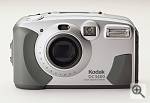 The Digital Camera Resource Page has posted its review of Kodak's DC3400 digital camera... Here's what Jeff had to say on this 2.3 megapixel, 2x optical zoom camera which is based on the Kodak DC280: The Digital Camera Resource Page has posted its review of Kodak's DC3400 digital camera... Here's what Jeff had to say on this 2.3 megapixel, 2x optical zoom camera which is based on the Kodak DC280: "My conclusions about the DC3400 are very similar to those of the DC280 that it replaces. It's a good camera, but not the best for the money. I compared the DC3400 to the Olympus D-490Z at the beginning of the review, and I'd say the D-490Z wins the battle hands down. If the Olympus had USB, it would be the perfect $500 camera. The Kodak is lacking many of the features that the Olympus model has, like TIFF mode, multiple ISO settings, a 3X zoom, and movie mode - plus it's much slower too." For a second opinion, be sure to read the review from the folks over at the Digital Eye website...
Source: Digital Camera Resource Page Kodak DC3400 review

Steve reviews PDR-M60, Unity FireWire CF reader!
By Michael Tomkins, The Imaging Resource
(Friday, September 8, 2000 - 14:47 EDT)
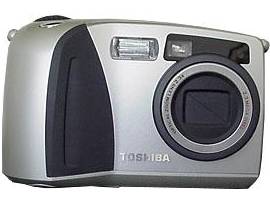
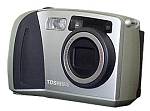 Our good friend Steve Sanders over at Steve's Digicams has posted his reviews of two new items over the last couple of days... First up is the first full review we've seen yet of Toshiba's 2 megapixel, 2.3x optical zoom PDR-M60. Steve concludes: Our good friend Steve Sanders over at Steve's Digicams has posted his reviews of two new items over the last couple of days... First up is the first full review we've seen yet of Toshiba's 2 megapixel, 2.3x optical zoom PDR-M60. Steve concludes: 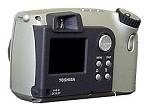 "The PDR-M60 is an entry-level two megapixel camera for those seeking an easy to use camera with good image quality. It is basically a fully automatic point and shoot type of camera without a complex menu system or a myriad of advanced controls. Overall it is a fairly robust camera ... operating it is as simple as turning the mode dial to Auto, point and shoot! And owning one shouldn't be much of a problem either as the MSRP is a low $499." "The PDR-M60 is an entry-level two megapixel camera for those seeking an easy to use camera with good image quality. It is basically a fully automatic point and shoot type of camera without a complex menu system or a myriad of advanced controls. Overall it is a fairly robust camera ... operating it is as simple as turning the mode dial to Auto, point and shoot! And owning one shouldn't be much of a problem either as the MSRP is a low $499."
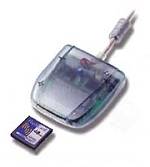 Also, Steve reviews an interesting device for those of us with a need for speed - Unity Digital's MDCF-FW IEEE1394 FireWire CompactFlash reader. Steve found the MDCF-FW to be exactly what you'd expect of a FireWire reader. We won't repeat the exact wording used, but suffice to say he found it to be blazingly fast... Also, Steve reviews an interesting device for those of us with a need for speed - Unity Digital's MDCF-FW IEEE1394 FireWire CompactFlash reader. Steve found the MDCF-FW to be exactly what you'd expect of a FireWire reader. We won't repeat the exact wording used, but suffice to say he found it to be blazingly fast...

Thursday, September 7, 2000
Ricoh RDC-7 Experiences?
By David Etchells, The Imaging Resource
(Thursday, September 7, 2000 - 19:28 EDT)
Well, today I got (mildly) flamed by the webmaster/publisher of one of the other "big four" digicam sites (I won't tell who, to maintain his cover). The reason? He felt we should have been much harder on the Ricoh RDC-7 in our review. Why? The main reason seemed to be the reported AutoExposure (AE) problems when some units of the RDC-7 are run with the LCD panel closed. He had other beefs with the camera (ergonomics, poor "feel" to the shutter button, etc) that I could see some people objecting to, but that I didn't have a particular problem with. (I personally found that I had no problem with the feel of the shutter button after I'd used the camera for an hour or two, my biggest beef with its ergonomics was that the front shutter button was very awkward to use with the LCD screen flipped open.
A big part of his concern though (echoed by at least one user who emailed us) was that he had problems with the cameras AE system when the LCD screen was closed (some kind of operating mode thing, apparently), and had also heard from several of his readers that they'd also had a problem in this area. I was chastised for not calling attention to this in our own review of the product. The problems I have with making an issue of this though, are: 1) We didn't experience the reported AE problems in either the first (very "beta") test unit we received, nor in the second essentially production-ready unit we actually used in our tests. 2) Ricoh told me that some preproduction units did in fact have an AE problem of this sort, but that none of the units released to the public had it. 3) I haven't personally had any email from readers who *themselves* have had an AE problem with the RDC-7. (A couple reporting on other reviewer's experiences, but none from actual users of the camera.) So what could we do? - We didn't see a problem, Ricoh said that some prototypes had it, but not production units, and nobody had emailed us showing any evidence to the contrary.
Given the vehemence of the email I received from the unnamed party though, and the fact that he apparently *had* received a number of emails from users having problems, I thought it would be useful to clear the air on the whole topic, by soliciting comments from actual users of the RDC-7, through a special RDC7-only discussion area we've set up. Here's the drill: If you're an actual RDC-7 user, could you post a note to that forum thread stating the following?
- Your RDC-7 experience, good OR bad
- Approximately when you bought your camera and where
- Serial number of your unit, if you know it
It's important in all this that RDC-7 owners respond whether you've had an AE problem or not. If only people who've had a problem post messages, we'll get skewed statistics.
Thanks!
(If folks out there can think of other issues like this they'd like to get a "straw poll" on, let us know by emailing [email protected], and we'll put something together for those issues too!
Source: Imaging Resource RDC-7 discussion forum

Canon announces diffractive optical element breakthrough!
By Michael Tomkins, The Imaging Resource
(Thursday, September 7, 2000 - 16:09 EDT)
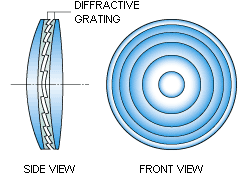
Not strictly speaking a digital imaging item, but we spotted this morning that Canon U.S.A. has announced the development of the world's first "Multi-Layer Diffractive Optical Element" for camera lenses. The development allows for smaller, lighter lenses with better optical properties (less distortion, and less chromatic abberation) - and is likely to show up in future digital camera lens designs, amongst other places. The technique is quite interesting, and the improvement in lens size is demonstrated admirably in the photo below, which compares an existing Canon EF 400mm f4 lens with the new prototype Canon EF 400mm f4 DO IS USM lens (abbreviations are Diffractive Optical, Image Stabilisation, Ultrasonic Motor respectively).
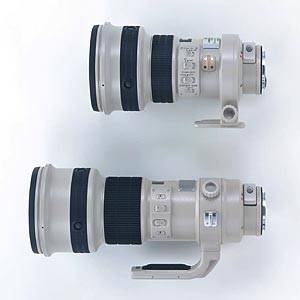
A prototype Canon EF 400mm f4 DO IS USM lens incorporating the new element will be exhibited at Photokina 2000 in Cologne, Germany, from Sept. 20-25. A commercial version of the lens will, Canon says, be marketed during the first half of 2001.
Canon's history of optical element development includes the creation of fluorite and aspherical elements, which have contributed to the realization of high-performance camera lenses, the press release notes. These optical elements are now found in many lenses, such as those used for interchangeable SLR cameras, video camcorders and digital cameras. Canon's Multi-Layer Diffractive Optical Element is claimed to possess the characteristics of both fluorite and aspherical elements.
Diffractive optical elements have a diffraction grating that alters the path light travels through diffraction. Such elements are already incorporated in such industrial instruments as spectroscopes and in signal-reading optical systems found in CD and DVD players. Diffractive optical elements, however, have not been employed in camera lenses due to the tendency of natural (white) light to produce superfluous diffracted light upon entering the lens, resulting in flare that degrades image quality (see diagram below).
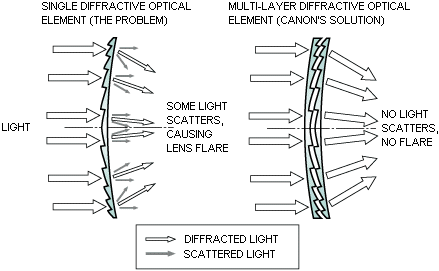
Canon's Multi-Layer Diffractive Optical Element features a multi-layer construction comprising two single-layer diffractive optical elements with opposing concentric circular diffraction gratings. When incident light enters the Multi-Layer Diffractive Optical Element, superfluous diffracted light is not produced and almost all of the light is used for the image. The achievement makes possible for the first time the incorporation of a diffractive optical element in a camera lens.
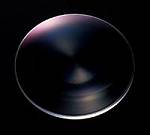 The most significant characteristic of the diffractive optical element is that the positions where the wavelengths combine to form an image are reversed from those of a refractive optical element. By combining a Multi-Layer Diffractive Optical Element and a refractive optical element within the same optical system, chromatic aberration (color smearing), which adversely affects image quality, can be corrected even more effectively than with a fluorite element, Canon claims. Also, by adjusting the pitch (spacing) of the diffraction grating, the diffractive optical element makes possible the same optical characteristics as a ground and polished aspherical surface, which the press release notes effectively corrects for spherical and other aberrations. The most significant characteristic of the diffractive optical element is that the positions where the wavelengths combine to form an image are reversed from those of a refractive optical element. By combining a Multi-Layer Diffractive Optical Element and a refractive optical element within the same optical system, chromatic aberration (color smearing), which adversely affects image quality, can be corrected even more effectively than with a fluorite element, Canon claims. Also, by adjusting the pitch (spacing) of the diffraction grating, the diffractive optical element makes possible the same optical characteristics as a ground and polished aspherical surface, which the press release notes effectively corrects for spherical and other aberrations.
During the manufacture of the Multi-Layer Diffractive Optical Element's diffraction grating, the height and pitch of the diffraction grating as well as its positioning requires micron-level precision (1 micron equals 1/1000 mm). Such accuracy is made possible through Canon's proprietary three-dimensional ultra-high-precision micro manufacturing technologies and the replicated aspherical lens manufacturing technology used in the production of Canon EF lenses.
Canon notes that it intends to continue its research and development efforts with the aim of incorporating the Multi-Layer Diffractive Optical Element in a variety of products, such as interchangeable SLR camera lenses, digital camera lenses, Head-Mounted Displays, LCD projector lenses, and other imaging equipment.
The Multi-Layer Diffractive Optical Element is claimed to be effective in correcting chromatic aberrations and, accordingly, should serve well in super telephoto lenses, in which chromatic aberrations are prone to occur. As an initial trial application, Canon has placed the element in a prototype EF 400mm f/4 DO IS USM lens. This lens is claimed to achieve the same level of image quality as that of comparable super telephoto lenses incorporating only refractive optical elements - but with the EF 400mm f/4 DO IS USM lens being much smaller and lighter than the current lenses.
To make a lens smaller and lighter, the spacing between the elements is shortened and the refractive properties of the front and rear lens groups are made more pronounced. This, however, results in increased chromatic aberration. To resolve this problem, the Multi-Layer Diffractive Optical Element is located within the lens to cancel out the occurrence of chromatic aberration. Compared with conventional super telephoto lenses, the prototype EF 400mm f/4 DO IS USM lens, measuring 233 mm in length, is about 26% shorter and, weighing 1,930 grams (including the 140 gram tripod collar), about 36% lighter.
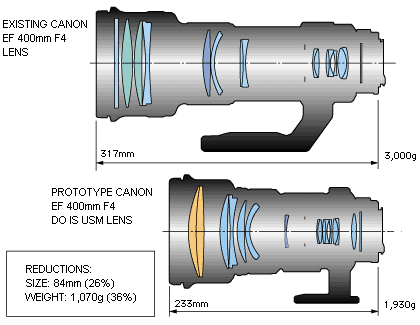
The Multi-Layer Diffractive Optical Element placed in the front lens group is claimed to eliminat chromatic aberration caused by the refractive lens group. Chromatic aberration is thereby reduced to an absolute minimum. Furthermore, the aspherical effect corrects for spherical and other aberrations, resulting in high resolution and high contrast for outstanding image quality.
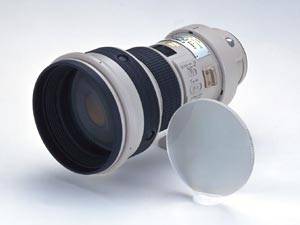
(Dave here) - This looks like really big news for the digicam world, even though the announcement initially applies to Canon's 35mm film-camera lenses. Why's that? Well, for a few reasons: 1) Canon currently makes and sells digicam lenses to at least 3 other manufacturers, possibly more. 2) Long-ratio zoom lenses (10x or more) are going to become increasingly popular/prevalent on digicams in the near future, a trend we're already beginning to see. 3) Long telephoto lenses *really* need stabilization to be usable without a tripod, and the general digicam market really isn't oriented toward shooting from tripods. 4) A more subtle but very important point: Digicam bodies are light compared to film cameras, and traditional optical stabilization elements are relatively heavy. One effect of this is that the engineers designing stabilization systems have to tweak the response of the moving element pretty carefully to avoid the reactive force of its motion from affecting the camera position and leading to oscillations. (We know of at least one digicam with optical stabilization that we can throw into continuous vibrations simply by holding the body lightly and rapping the lens with a finger.) This sensitivity to oscillation limits how aggressive the engineers can be in correcting for camera movement. With a much lighter moving element, they can crank up the gain quite a bit on the feedback loop, producing much more stablization, and thereby allowing much longer exposures than would otherwise be possible. Bottom line? This announcement will turn out to be very good news for digicam users, we suspect in the not too-distant future (12 months?). Keep an eye not only on Canon, but on manufacturers who use their lenses in their cameras - Companies including Casio, Epson, Sony and Toshiba, and doubtless others as well. I predict that we're going to start seeing a whole generation of long-ratio zoom digicams with optical stabilization, probably starting about this time next year...
Source: Yahoo! Finance / Business Wire

Y Media announces 3.17 megapixel CMOS sensor!
By Michael Tomkins, The Imaging Resource
(Thursday, September 7, 2000 - 13:48 EDT)
 Y Media Corp. has introduced a new CMOS image sensor, designed for both high-resolution digital still and video in consumer electronics appliances, in a press release distributed by PR Newswire. Y Media's new 3.17 megapixel YM-3170A C3D image sensor is, says the company, 'the first to offer the largest resolution array yet smallest pixel size.' (Don't get confused here - C3D is Y's trademark; the chip is a CMOS image sensor and we'll refer to it as such for the rest of this news item -- Mike) Y Media claims the chip offers the lowest power consumption in CMOS-based technology along with full video frame rates, and that it will "match and exceed the imaging performance of the current generation of CCD sensors. Y Media Corp. has introduced a new CMOS image sensor, designed for both high-resolution digital still and video in consumer electronics appliances, in a press release distributed by PR Newswire. Y Media's new 3.17 megapixel YM-3170A C3D image sensor is, says the company, 'the first to offer the largest resolution array yet smallest pixel size.' (Don't get confused here - C3D is Y's trademark; the chip is a CMOS image sensor and we'll refer to it as such for the rest of this news item -- Mike) Y Media claims the chip offers the lowest power consumption in CMOS-based technology along with full video frame rates, and that it will "match and exceed the imaging performance of the current generation of CCD sensors."We believe that our revolutionary approach of design and process improvements provides consumer electronics manufacturers a high-quality image sensor option that previously was not available in the marketplace," states Y Media's CEO and President Ian Olsen. "Delivering a totally new class of image sensor innovation for the consumer space means that Y Media is well-positioned to assist OEMs as they transition from the previous capture technology to the next generation." The YM-3170A is claimed to offer the lowest power consumption combined with the highest resolution capture area available to a wide audience of OEMs, with a visible resolution matches that of 3 Megapixel CCDs currently on the market. Y Media feels that its new sensor will give OEMs 'the functionality that they need to transform today's discrete products into new hybrids such as high-density digital still plus video all-in-one cameras, as well as video camcorders with resolutions ideal for digital broadcasting'. The new sensor uses a 0.25-micron process, allowing the Company to create sensors with more than three times as many pixels in the same area as the current CMOS imager industry benchmark, notes the press release.
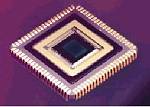 Y Media goes on to note that smaller array sizes 'enable more complex functionality, greater speeds, further miniaturization, and lower power dissipation resulting in the best image solution for battery-powered mobile consumer devices'. The YM-3170A features an individual pixel size of 3.3-microns, claimed to be the smallest pixel size available in CMOS. Y Media's smaller pixel size allows more than three times as many pixels without increasing the overall size of the image array or chip, thus accommodating a true 1/2" optical format for the 3.17 Megapixel image sensor. This provides the OEM with a greater selection of lens choices, allowing optimization of cost and performance in camera applications. Y Media goes on to note that smaller array sizes 'enable more complex functionality, greater speeds, further miniaturization, and lower power dissipation resulting in the best image solution for battery-powered mobile consumer devices'. The YM-3170A features an individual pixel size of 3.3-microns, claimed to be the smallest pixel size available in CMOS. Y Media's smaller pixel size allows more than three times as many pixels without increasing the overall size of the image array or chip, thus accommodating a true 1/2" optical format for the 3.17 Megapixel image sensor. This provides the OEM with a greater selection of lens choices, allowing optimization of cost and performance in camera applications.
Y's CMOS sensor is claimed to approach the quality of film-based pictures with a full-frame 4:3 aspect ratio that is 'three times the resolution of any competitive solution'. The image sensor also offers a range of programmable features, such as variable windowing mode, making possible different aspect ratios including 3:2 and the 16:9 format used in HDTV. Programmable windowing simplifies camera functions like digital pan and zoom. Since the YM-3170A integrates features into the image sensor, back-end ASIC or companion chip-processing needs as well as overall power consumption are reduced. OEMs can add artistic options and differentiation for end-users by enabling features like selective color gain, motion-focus tracking, and color-enhanced preview. In addition, the sensor offers automatic VGA (640 x 480 pixels) resolution sub-sampling for preview mode that reduces data processing requirements when using an LCD display or for capturing video clips. The YM-3170A can record video at a full 30 frames per second.
Y Media collaborated with another unnamed company to bring a 0.25-micron process into CMOS image sensor design. The reduction in process geometry allows for both an increase in the number of transistors and fill factor (the ratio of the area of the chip actively gathering light as against total chip area) without compromising performance, in addition to increasing pixel design options. The 0.25 micron process allows more complex image sensor functionality, greater speeds, and lower power dissipation.
CMOS image sensor solutions consume less power, offer higher integration, and reduce system costs as compared to image sensors that use CCD technology, notes Y Media's release. First, CMOS image sensors typically draw 5 to 10 times less power than CCDs. This benefit allows portable products such as digital still and video cameras to run longer by extending the battery life. Second, with a CMOS image sensor, both the array and required peripheral circuitry are formed within a single process technology, thus integration into a system-on-a-chip is possible. CMOS image sensors use the same manufacturing platform as most microprocessors and memory chips, making them easier to produce and more cost-effective. Third, by combining all camera functions on-chip, from the capture of photons, processing and output of digital information, CMOS image sensors reduce the component count in end products, which in turn boosts reliability, eases miniaturization, and simplifies programming of camera parameters.
Y Media's YM-3170A will be sampling in November with volume production expected in early 2001. Pricing for the YM-3170A is as yet unannounced, but will be "competitive with equivalent high-resolution and performance consumer image sensor solutions", the company notes.
Source: Yahoo! Finance / PR Newswire

Civil engineers - win a Polaroid digicam!
By Michael Tomkins, The Imaging Resource
(Thursday, September 7, 2000 - 12:50 EDT)
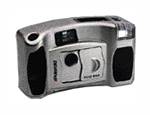 Are you a civil engineer? If so, a company by the name of Haestad Methods is running a challenge to visitors of their web site - and you've probably got higher odds of winning in this competition than most! Engineers can log in and test their mettle with the Haestad Methods eQuiz, dubbed "Who wants to be a Civil Engineer." Contestants are asked to answer a series of multiple choice questions, and depending on their score are entered to win a number of prizes such as a Compaq laptop computer, a Polaroid PhotoMAX PDC 640 Digital Camera, and Haestad Methods merchandise. New questions are posted on an ongoing basis so engineers can return to play every month. Prizes are awarded in categories based on your score in the quiz each month. Are you a civil engineer? If so, a company by the name of Haestad Methods is running a challenge to visitors of their web site - and you've probably got higher odds of winning in this competition than most! Engineers can log in and test their mettle with the Haestad Methods eQuiz, dubbed "Who wants to be a Civil Engineer." Contestants are asked to answer a series of multiple choice questions, and depending on their score are entered to win a number of prizes such as a Compaq laptop computer, a Polaroid PhotoMAX PDC 640 Digital Camera, and Haestad Methods merchandise. New questions are posted on an ongoing basis so engineers can return to play every month. Prizes are awarded in categories based on your score in the quiz each month.
 To play, just visit the Haestad Methods web site. Players must be directly involved with hydraulics, hydrology, or a related civil/environmental engineering field, and be 18 years or older to qualify for the monthly prize drawing. Winners are selected randomly from all eligible entries, and names of the winners will be announced by Haestad Methods. To play, just visit the Haestad Methods web site. Players must be directly involved with hydraulics, hydrology, or a related civil/environmental engineering field, and be 18 years or older to qualify for the monthly prize drawing. Winners are selected randomly from all eligible entries, and names of the winners will be announced by Haestad Methods.
Source: Yahoo! Finance / PR Newswire

Wednesday, September 6, 2000
Zoran postpones annual stockholder meeting!
By Michael Tomkins, The Imaging Resource
(Wednesday, September 6, 2000 - 17:24 EDT)
 Zoran Corp. announced today that it has postponed the reconvened annual meeting previously scheduled for September 12, 2000, at which shareholders were to vote on an additional proposal to increase the authorized common stock from 20,000,000 to 55,000,000 shares. Zoran Corp. announced today that it has postponed the reconvened annual meeting previously scheduled for September 12, 2000, at which shareholders were to vote on an additional proposal to increase the authorized common stock from 20,000,000 to 55,000,000 shares.
On Aug. 24, 2000, Zoran and Nogatech, Inc. announced that they had signed a definitive merger agreement. The merger is subject to approval by the stockholders of Nogatech, compliance with the notification and waiting period requirements of the Hart-Scott-Rodino Antitrust Improvements Act, and other conditions.
After the completion of the merger, Zoran expects to schedule a special meeting of stockholders to consider the proposal to increase the authorized shares of common stock.
Source: Yahoo! Finance / Business Wire

Intermec announces CE Handheld with built-in digicam!
By Michael Tomkins, The Imaging Resource
(Wednesday, September 6, 2000 - 16:21 EDT)
 Intermec Technologies Corp. has announced a new handheld pen tablet computer featuring an integrated digital camera, Windows CE operating system and optional Wi-Fi certified (802.11 High Rate) wireless network capabilities. Intermec Technologies Corp. has announced a new handheld pen tablet computer featuring an integrated digital camera, Windows CE operating system and optional Wi-Fi certified (802.11 High Rate) wireless network capabilities."The 6651 is ideal for insurance adjusters, building inspectors, utility repair workers and other mobile personnel that need a lightweight computing tool to capture both a picture along with a data record," said Matt Miller, Senior Product Manger for Intermec. "Now high-quality digital photos and video clips can be captured on the same device used for e-mail, Internet access, calendars and other Windows applications. And, best of all, workers won't have to recharge their unit for an entire workday -- eight hours of battery life. The very bright, high-contrast active color matrix display on the 6651 makes it easy to read in many lighting conditions."
"Warehouse and manufacturing workers can use the 6651 to transmit real-time data and video across a wireless local area network with the optional IEEE 802.11 High-Rate feature," added Miller. The Intermec 6651 comes with productivity software including Personal Information Management tools and Pocket Office versions of popular Microsoft applications such as Outlook, Word, Excel, Access and PowerPoint. It can be used as an 'enterprise computing companion,' offering access to applications and data via its Pocket Internet Explorer built-in browser thin client software, such as Citrix ICA client. The 6651's 'fold-over' display offers both clamshell and pen tablet modes. A 'flip-screen' software feature lets workers electronically reverse the angle of the display panel to change the unit into a signature-capture device so customers can digitally sign receipts and proofs of delivery.
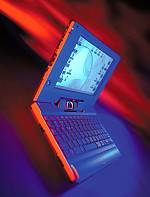 Based on the Microsoft Windows CE operating system (Handheld PC Professional Edition v2.11), the 6651 features an active matrix LCD screen with a 7.1-inch viewing area and 64K colors. The digital camera has a rotatable, 350,000-pixel CMOS imaging sensor that can capture both still images as well as short video clips. Based on the Microsoft Windows CE operating system (Handheld PC Professional Edition v2.11), the 6651 features an active matrix LCD screen with a 7.1-inch viewing area and 64K colors. The digital camera has a rotatable, 350,000-pixel CMOS imaging sensor that can capture both still images as well as short video clips.
The unit has a Toshiba 129 MHz MIPS processor, and comes standard with 32 MB RAM, and a Lithium ION battery pack that recharges in 2.5 hours. The 6651 is certified for Intermec wireless LANs (11 mbps. Wi-Fi, IEEE 802.11b and OpenAir). It has both PC Card and Compact Flash capabilities, and VGA /Serial, IrDA and USB ports. The Intermec 6651 Handheld PC carries a suggested retail price of $1,495 and is available currently.
Source: Yahoo! Finance / Business Wire

REAL PRINTS from our Standard Test Shots! (!!)
By David Etchells, The Imaging Resource
(Wednesday, September 6, 2000 - 2:46 EDT)
 Zounds! REAL PRINTS of our test shots! Zounds! REAL PRINTS of our test shots!
If the proof of the pudding is in the eating, the proof of the digicam is in the printing! (Whew, that'scertainly a tortured simile, 'guess it's getting late today!) Our biggest goal here at The Imaging Resource has always been to provide a solid, standardized basis of comparison between digicams. The problem with the internet though, is that most of us tend to share and look at photos as prints, rather than on a CRT. Thus, the main way we have of presenting our test photos to you is most likely not the way you're going to be viewing the final images from whatever camera you buy. Throw in the fact that different CRTs are *really* different, and things get even further complicated. What to do? Well, through a special arrangement with our friends over at Ofoto.com, we're setting up a massive archive of our test photos in Ofoto albums (link removed as this offer doesn't exist any more, 2005/06/30). Our readers can now visit any of our Ofoto albums of test images and order high quality photographic prints. (Ofoto seems to regularly win in quality comparisons, a recent study showing that fully 80% of people polled in a blind test preferred the Ofoto prints over those of the competition.) We've created two types of test photos for each camera we have listed, one that's a composite of six of our test shots, intended for printing at 8x10 size, and the other sets of individual photos pretty much as they came from the camera. (Meaning we've stripped-in IR and Ofoto logos, camera and copyright info, but not otherwise manipulated the image.) The prints aren't *quite* free, but we think well worth the cost if you're looking at spending a few hundred dollars on a digicam. If you're new to Ofoto, you get a quantity of free 4x6 prints when you sign up. 8x10s currently cost $3 each. Bottom line, for $10 or so, you could get a really good idea of how two or three different digicams you're considering compare to each other under real-world conditions, including real-world photo printing! We're very excited about this, and will be adding to the nearly 30 cameras we currently have albums posted for, the plan being to do this routinely for every camera we test from here on out. Click for more info and a list of cameras we have up currently (link removed as this offer doesn't exist any more, 2005/06/30), or jump to a thread in our forums that we've set up for folks to ask questions and dialog on this. Check it out! (link removed as this offer doesn't exist any more, 2005/06/30)
Source: Intro page to IR sample prints index

Tuesday, September 5, 2000
1GB Microdrives now shipping!
By Michael Tomkins, The Imaging Resource
(Tuesday, September 5, 2000 - 18:16 EDT)
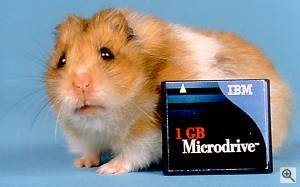
IR advertiser d-store.com has been in touch to let us know some great news - they're now shipping IBM's 1 gigabyte Microdrives! The 1GB Microdrive requires a camera with a Type-II CompactFlash or Type-II PC card slot; some cameras do meet this requirement but still don't support the Microdrive, so do check with your digicam manufacturer before buying one to avoid disappointment. Prices from d-store for the 1GB Microdrive are $499 for the drive itself, or $509 including a PC Card adapter...
(Dave here: Jeez, this makes me feel old: I remember back around 1991 or so, when I was selling hardware for the Mac platform, we had a unit called the "Micah Drive". It was a 20 Meg hard drive with hardware to mount in a Mac Plus chassis. It was the size of a largish book, held all of 20 megabytes, and we sold it for the *unbelievable deal price* of only ~$1400! Times sure have changed...) ;-)
Source: d-store.com

Digicam sales help raise Sanyo profit projections!
By Michael Tomkins, The Imaging Resource
(Tuesday, September 5, 2000 - 17:58 EDT)
 A news item from press agency Reuters notes that Japanese consumer electronics giant Sanyo Electric Co. has raised its profit forecasts for the period Apri to September 2000 by some 80%. The company noted that the increase was thanks to increased sales of digital cameras, electronics components for computer-related devices and semiconductors used in mobile phones. Sanyo now expects to report a profit of some ¥19 billion (US$180 million), as compared to previous projections of ¥10.5 billion (US$100 million). Sanyo reported profits of ¥3.6 billion (US$34 million) in the same period last year... A news item from press agency Reuters notes that Japanese consumer electronics giant Sanyo Electric Co. has raised its profit forecasts for the period Apri to September 2000 by some 80%. The company noted that the increase was thanks to increased sales of digital cameras, electronics components for computer-related devices and semiconductors used in mobile phones. Sanyo now expects to report a profit of some ¥19 billion (US$180 million), as compared to previous projections of ¥10.5 billion (US$100 million). Sanyo reported profits of ¥3.6 billion (US$34 million) in the same period last year...
(Dave again: A lot of folks using their cameras don't realize that they're actually holding a Sanyo in their hands: While Sanyo has marketed a few cameras of their own, their main business is building cameras to other manufacturer's specs. I don't know all the alliances they have, but they build a *lot* of cameras. Examples? Look no further than the hugely popular Nikon 950 and 990...
Source: Yahoo! Finance / Reuters

Lexar CF chosen for Coolpix 880 bundle!
By Michael Tomkins, The Imaging Resource
(Tuesday, September 5, 2000 - 17:43 EDT)
Lexar Media Inc. has announced that its 8X 8MB USB-enabled CompactFlash digital film cards will be bundled with the new Nikon Coolpix 880 digital camera. The Nikon 880 is a versatile, fully automatic 3 megapixel digital camera that is designed to create high-quality images and prints.
 Lexar Media's USB-enabled CompactFlash digital film cards are available in a variety of capacities. For the consumer photography market, Lexar offers USB-enabled CompactFlash digital film cards in 16, 32, 48, 64 and 80MB capacities with sustained write speeds of 600KB/sec, and 32, 48, 64, 80, 128, 160 and 256MB capacities with write speeds of 1.2MB/sec. Lexar also offers a 160MB USB-enabled CompactFlash card with write speeds of 1.5MB/sec for professional photographers who require faster write speeds for sports, fashion and high-speed photography. The Pro Series CompactFlash cards are designed for professional digital cameras such as the Nikon D1 and others. Lexar Media's USB-enabled CompactFlash digital film cards are available in a variety of capacities. For the consumer photography market, Lexar offers USB-enabled CompactFlash digital film cards in 16, 32, 48, 64 and 80MB capacities with sustained write speeds of 600KB/sec, and 32, 48, 64, 80, 128, 160 and 256MB capacities with write speeds of 1.2MB/sec. Lexar also offers a 160MB USB-enabled CompactFlash card with write speeds of 1.5MB/sec for professional photographers who require faster write speeds for sports, fashion and high-speed photography. The Pro Series CompactFlash cards are designed for professional digital cameras such as the Nikon D1 and others.
Source: Yahoo! Finance / PR Newswire

Zing licenses Corbis library!
By Michael Tomkins, The Imaging Resource
(Tuesday, September 5, 2000 - 17:25 EDT)
 Online photofinisher Zing Network Inc. and online photo archive Corbis Corp. have announced a strategic partnership in which Corbis will provide digital images for use on Zing.com. The addition of Corbis' library of images will enhance Zing's e-commerce offerings to consumers and give them more choice for ordering prints and picture gifts. Zing.com's 2.2 million members will expose the Corbis collection of images to an even greater amount of Internet users. Online photofinisher Zing Network Inc. and online photo archive Corbis Corp. have announced a strategic partnership in which Corbis will provide digital images for use on Zing.com. The addition of Corbis' library of images will enhance Zing's e-commerce offerings to consumers and give them more choice for ordering prints and picture gifts. Zing.com's 2.2 million members will expose the Corbis collection of images to an even greater amount of Internet users.
Under terms of the agreement, Zing will offer Corbis images in the ZingStore for embellishing picture gifts, including framed prints, mugs, mouse pads, T-shirts and picture cookies."Zing offers picture enthusiasts a great online experience with a suite of products and services for sharing and ordering prints and picture gifts. Corbis adds the world's greatest images and products to the mix, and it's a natural partnership," said Rip Warendorf, vice president of Corbis' consumer division. "Corbis images bring a fresh and exciting element to the offering on Zing.com, and Zing provides Corbis with a new venue for featuring its pictures and picture products to consumers."The collection of Corbis images will be available for purchase on www.zing.com in a variety of sizes and product configurations. Zing members will have the option to use famous images for ZingCards, or in their own personal photo albums and slideshows. Scheduled for delivery in September, Corbis images will also be seen in ZingWorld, Zing's online e-zine with digital photography tips, advice and spotlight features."We welcome the addition of Corbis' historic, world-renowned photographs to Zing's consumer photo archive. We are continuously adding features and product offerings that will prove to further enrich the user's experience," said Mark Platshon, Zing president and chief executive officer. "Zing and Corbis share a common vision toward making digital photography easy and accessible for people to make a part of their everyday lives. I think that with our new partnership, we are one step closer to achieving that goal."
Source: Yahoo! Finance / Business Wire

SmashCast, PhotoPoint bring MovieMaker online!
By Michael Tomkins, The Imaging Resource
(Tuesday, September 5, 2000 - 17:05 EDT)
Online photo-sharing webiste PhotoPoint.com and SmashCast Inc. have announced the launch of PhotoPoint MovieMaker, which allows PhotoPoint members to create and broadcast Web Movies, incorporating digital images, music, text and animated content. The announcement marks the first integration of SmashCast Movie Studios version 3.0 into a partner website."The future of video online is very exciting. We're delighted to be working with SmashCast to debut PhotoPoint MovieMaker, a valuable rich media production tool unlike anything else available on the Web today," said Ed Bernstein, CEO of PhotoPoint. "PhotoPoint MovieMaker gives our members the opportunity to see the future today by combining their digital photographs with music and animated content to create photo 'shows.' SmashCast's technology breaks new ground and demonstrates the promise for the day when video online will be as big a part of a person's life as still photographs." In less than five minutes, PhotoPoint members can produce and broadcast a "Web movie" directly from their browser, notes the press release. Members select up to 24 photos from their online photo albums and PhotoPoint MovieMaker walks them through the rest of the process. A variety of animated storyboards, with themes like baby, birthday, pets and travel, and a library of popular music titles are available, enabling users to preview and choose content to accompany their photos. A web-based editing suite allows users to "drag and drop" thumbnail images into any order, and add text captions. The personal Web Movie is then instantly ready to broadcast from a private URL. Members can invite their family and friends back to PhotoPoint.com to view their Web Movie as often as they wish."Rich media brings a dynamic new dimension to traditional, static digital images. With the ability to turn images into a Web Movie in just a few easy steps, PhotoPoint members may never look at their photos the same way again," said Dan Hobin, founder and CEO of SmashCast, Inc. "We are excited to deliver this dramatically different digital photography experience." The two companies first announced their plans for PhotoPoint MovieMaker on April 27, covered in our news item "PhotoPoint, SmashCast offer web movie making!". At that time, it was predicted to launch in the second quarter of 2000.
Source: Yahoo! Finance / PR Newswire

Altamira announces Nikon GF deal!
By Michael Tomkins, The Imaging Resource
(Tuesday, September 5, 2000 - 16:57 EDT)
 Nikon Inc. and Altamira Group Inc. have announced a new bundling arrangement with the newest Nikon digital camera, the Coolpix 880. Similar to the previous partnership with the Coolpix 990 camera, the Coolpix 880 bundle will include a copy of Altamira's Genuine Fractals 2.0 LE. Nikon Inc. and Altamira Group Inc. have announced a new bundling arrangement with the newest Nikon digital camera, the Coolpix 880. Similar to the previous partnership with the Coolpix 990 camera, the Coolpix 880 bundle will include a copy of Altamira's Genuine Fractals 2.0 LE."The process of capturing, editing and resizing high quality digital images is made easier with Nikon and Altamira's partnership. The introduction of Nikon's newest camera in their award-winning digital camera line-up provides exciting opportunities for all digital camera enthusiasts to print vibrant digital images at unprecedented sizes and resolutions," said Sonja Palosaari, senior director of marketing for Altamira. The Coolpix 880 camera is designed for a range of users, from novice to professional. The camera is based on a 3.34 megapixel CCD and a 2.5X (38-95 mm) optical zoom Nikon lens and features a "Quick Review" option that allows the user to instantly preview the photos taken. The Coolpix 880 possesses 11 different automatic scene adjustments that Nikon feels make it as convenient as a point-and-shoot, as well as a manual mode feature and ability to shoot up to 40-second QuickTime video files.
With Altamira's Genuine Fractals, the company notes that users can scale their photographs to larger sizes without sacrificing image quality or resolution. Images may also be reduced to compact, agile files that can be easily edited, transported, and stored.
Source: Yahoo! Finance / Business Wire

IrfanView 3.25 released!
By Michael Tomkins, The Imaging Resource
(Tuesday, September 5, 2000 - 16:00 EDT)
 A new version of the popular program IrfanView, the image viewer created by Austrian programmer Irfan Skiljan, has been released over the weekend. IrfanView 3.25 has the following changes over the previous version: A new version of the popular program IrfanView, the image viewer created by Austrian programmer Irfan Skiljan, has been released over the weekend. IrfanView 3.25 has the following changes over the previous version:- LWF-PlugIn can save now images up to 4096x4096 pixels
- Support for LDF files (LuraDocument format, from LuraTech GmbH, Germany)
- IrfanView can create multipage LDFs (Menu: View->Multipage images)
- New feature: Selection/crop/cut now possible in zoom mode :-)
- Support for lossless JPG rotation/flip (Menu: Options->JPG Transformation)
- New advanced batch option: 'Crop' (Crop all images, set X, Y, Width, Height)
- New save option for PNGs: 'Set compression level' (Save dialog->Options)
- Change: 'Fit big images to desktop' moved to View menu
- Some minor bugs/features fixed/added
For full details and to download the program, head over to the IrfanView website...

PhotoPoint to sell Sony UP-DP10 photo printer!
By Michael Tomkins, The Imaging Resource
(Tuesday, September 5, 2000 - 11:56 EDT)
Sony Electronics and PhotoPoint Corp. have announced that they have entered into a co-marketing agreement whereby Sony will sell its new UP-DP10 home photo printer to online photo-sharing enthusiasts through PhotoPoint.com. Sony's decision to work with PhotoPoint came after a review of the membership, features and e-commerce services offered by several online photo-sharing and print-processing websites, the press release notes.
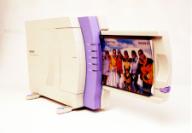
PhotoPoint is using the launch of its new virtual shopping cart to promote sales of the UP-DP10 for $389, plus shipping and handling. This price also includes a complimentary media pack that produces 25 prints, a $14.99 value."By aligning with one of the fastest-growing photo communities on the Internet, we're introducing the UP-DP10 directly to active photo-sharing enthusiasts," said Steven Blum, vice president of digital photography, for Sony Electronics' Broadcast and Professional Company. "Our agreement with PhotoPoint is a great way to bring the value of our home printer directly to these digital photo buffs."
"With Sony's breakthrough new photo printer, we're raising the bar on the type of products and services we bring to our membership," said PhotoPoint CEO Ed Bernstein. "We're convinced that members will find this affordable home printer to be a great tool for helping them share and celebrate their lives in pictures and prints." With a vertical design, the Sony UP-DP10 printer has a tiny footprint, that allows it to fit well as a second home printer dedicated to making pictures. The home photo printer uses Sony's new print media that produce laminated, 4" x 6" borderless picture, which the company feels are comparable to the prints people are accustomed to picking up at a photo lab. These pictures have image durability that rivals conventional photographs, the press release claims.
The UP-DP10 connects to a computer either via Universal Serial Bus or parallel port, and comes with printer-driver software for both Windows-based and Macintosh computers. The UP-DP10 will automatically adjust the contrast, tone, color balance and/or sharpness of the image through its Auto Color Correction feature, and produces each print in just 85 seconds. A check of the pircegrabber.com website, which monitors prices from numerous online retailers, found Sony's UP-DP10 listed at prices from $343 to $412, before shipping and tax.
Source: Yahoo! Finance / PR Newswire

PhotoAmerica.com integrates PictureIQ into its service!
By Michael Tomkins, The Imaging Resource
(Tuesday, September 5, 2000 - 11:32 EDT)
PictureIQ Corp. and photoamerica.com have announced that the online photofinishing site will integrate the PictureIQ Internet Service as core infrastructure technology for its photo site and back-end printing systems. With PictureIQ technology, photoamerica.com customers will be able to enhance their photos prior to ordering photo prints or other photo products."As a key piece of our imaging infrastructure, the PictureIQ Internet Service will deliver the most powerful set of online image enhancement and creativity tools available, giving our users more options and opportunities to get great results with their digital images," said Richard Carter, President, photoamerica.com. "We expect our incorporation of PictureIQ will increase prints ordered per customer as they create different versions of their favorite photos by applying unique PictureIQ effects." Photoamerica.com specializes in putting digital images both on prints and onto apparel and novelty items. Their "Digital Dividends" program enables digital camera retailers to become resellers of the photoamerica.com online photo development service and obtain a share of transaction revenues. The PictureIQ Internet Service will be integrated throughout the site's photo acquisition, editing, and high-resolution printing process. PictureIQ features will include one-touch photo fixing, red-eye removal, cropping, rotation and creative artistic effects.
PictureIQ's "resolution-on-demand" model delivers low-resolution images to consumers for on-screen viewing and editing, and then produces high-resolution versions at the time of print fulfillment. This aspect of PictureIQ's XML-based architecture enables PictureIQ-powered sites to deliver both a quick online editing experience, and optimal print quality. PictureIQ's use of XML also ensures that enhancements made on-screen translate straight through to the print process, resulting in a true "what you see is what you get" experience, the company notes."Photoamerica.com provides people with quality digital photo services and PictureIQ is pleased to be enhancing their offering," said Bill McCoy, President and CEO, PictureIQ Corporation. "They are representative of the growing number of online photo services that realize the value of integrating the PictureIQ Internet Service as core infrastructure technology within their end-to-end image acquisition to high-resolution printing process, so that they can focus their in-house resources on building their businesses." PictureIQ features will be available to photoamerica.com customers by fall of this year. Photoamerica.com joins a list of partners who have chosen to integrate the PictureIQ Internet Service, including Corbis, eCircles, eframes.com, Evite, InfoSpace, Jside.com, Ofoto, PhotoChannel, iPIX, and Zing.
Source: Yahoo! Finance / PR Newswire

Philips Semiconductors introduces new AFE lineup!
By Michael Tomkins, The Imaging Resource
(Tuesday, September 5, 2000 - 11:06 EDT)
Philips Semiconductors has introduced a new Analog Front-end device family that it says enhances picture quality for digital still cameras and camcorders. The TDA996X and TDA995X device ranges, for 12- and 10-bit color depth respectively, are designed for cameras ranging from professional to consumer, providing digital camera and camcorder makers with low noise, distortion-free images and longer battery-life, the press release notes.
Philips' states that its new AFE family "provides superior picture quality by eliminating noise and image distortion while processing signals from the sensor into digital form". The TDA995X and TDA996X 3V ranges are compatibile with each other, offering an integrated design path from 10- to 12-bit resolution. The AFE family also supports a range of Charge Coupled Device (CCD) applications spanning sampling speeds from 18 to 40 MSPS."Philips created the TDA996X and TDA995X AFE family for versatility, giving customers the greatest flexibility for optimizing imaging systems that seamlessly integrates with our line of CCD sensors and Digital Image Processors," said Claude Giraud, International Product Marketing Manager, Digital Media Imaging, Philips Semiconductors. "This versatility enables digital still camera and camcorder manufacturers to easily develop and launch distinctive product lines spanning high performance to entry-level." The 12-bit TDA9965 features a "Clamp and Track and Hold" architecture that refines input amplification to eliminate clamp noise and reduce overall noise. This approach, says Philips, makes the TDA9965 superior to other integrated front-end solutions with respect to noise, linearity and color transition. The TDA9965 operates on 5V, and accepts up to 2V active video signal, allowing use with high-density, high sensitivity CCDs with extended dynamic range. Power management features of the TDA9965 extend battery life without impacting camera performance, enabling power-ups to shooting mode in under 300ms following power-downs.
The mid-range 12-bit TDA9962 consumes only 125mW under 2.7V and supports sampling rates from 20 to 25MSPS. The TDA9962's low noise and programmable gain amplifier linearity contribute to high image quality for still images or video under a broad range of lighting conditions, Philips feels. For higher density or faster read-out CCD applications, the TDA9964 provides the same quality as the TDA9962, while supporting sampling rates from 30 to 40MSPS.
Optimized for use with entry-level, high volume camcorder and digital still camera lines, the 10-bit TDA9952 and TDA9956 are pin-compatible with the 12-bit 3V range devices. The TDA9952 supports sampling rates from 18 to 25MSPS, and the TDA9956 supports sampling rates to 36MSPS without any noise penalty.
The TDA9965 is priced at $18 in quantities of 1,000. The TDA9962 and TDA9964 are priced at $10 and $12, respectively, in quantities of 1,000. The TDA9952 and TDA9956 are priced at $7 and $9, respectively, in quantities of 1,000. All products are currently available in an LQFP48-pin package.
Source: Yahoo! Finance / PR Newswire

Friday, September 1, 2000
Megapixel September issue online!
By Michael Tomkins, The Imaging Resource
(Friday, September 1, 2000 - 20:25 EDT)
The September 2000 issue of megapixel.net is now online! Reviewed this month are the Olympus D-490 Zoom (2.1 megapixel, 3X Zoom), Pentax EI200 (2.1 megapixel, 3X Zoom), Minolta Dim�ge (2.3 megapixel) and Sony Mavica MVC-FD90 (1.3 megapixel, 8X Zoom).
Articles this month include Paul Sullivan examining copyrights on the Internet, a look at the color correction process and a sampling of the macro photos readers have sent in over the last 2 months.

IDC sees entry-level digicams driving market!
By Michael Tomkins, The Imaging Resource
(Friday, September 1, 2000 - 18:31 EDT)
 Entry-level VGA cameras, which offer fewer features and lower price points than standard point-and-shoot cameras, are becoming a driving force behind the rapidly expanding digital camera market, according to new research from the analysts at IDC. U.S. VGA digital camera shipments rose to 565,000 units at the end of Q2 2000, 214% up on the previous quarter. Entry-level VGA cameras, which offer fewer features and lower price points than standard point-and-shoot cameras, are becoming a driving force behind the rapidly expanding digital camera market, according to new research from the analysts at IDC. U.S. VGA digital camera shipments rose to 565,000 units at the end of Q2 2000, 214% up on the previous quarter.
Nonbranded, "white box" cameras led the charge in this growing segment of the market, as many of these cameras were shipped to various Internet companies as promotional incentives for attracting new customers, the company noted."The entry-level VGA camera has wide appeal and specifically targets mainstream consumers," said Chris Chute, research analyst with IDC's Digital Camera program. "As price points continue to fall, and more and more people get online, the demand for digital imaging will continue to grow." In addition to nonbranded players, traditional vendors are also making gains in the VGA segment. Polaroid leads the way with shipments of 265,000 cameras, a 36% share of the market in the first half of 2000. KB Gear took 9% of the market in the same quarter.
The point-and-shoot segment of the digital camera market has also made great strides recently, according to IDC. U.S. shipments in this market reached 1.06 million in Q2 2000, a 55% increase over the first quarter. Sony tightened its grip on the top position of this market by grabbing 31% market share.
Overall, the pricing of imaging technology is dropping, and cameras are becoming more user friendly, IDC notes. As these trends continue, IDC predicts that the base of potential users will keep getting larger and the outlook for the industry will remain extremely promising. IDC's report Second-Quarter and First-Half 2000 Digital Camera Market Share Update (IDC #B22892) can be obtained by contacting Patrick Steeves at 508-988-6787 or [email protected].
Source: Yahoo! Finance / PR Newswire

Fred Meyer Stores stocks Agfa's CL18!
By Michael Tomkins, The Imaging Resource
(Friday, September 1, 2000 - 17:17 EDT)
 Agfa Corp.'s Consumer Digital Imaging Group has announced that the ePhoto CL18 is now available at most locations of Fred Meyer Stores. The ePhoto CL18 is a simple-to-use dual-mode digital camera that opens the door for a variety of uses such as capturing both still images or video footage. Small enough to take anywhere, says Agfa, it can "capture a moment, record an event or anything in between". Agfa Corp.'s Consumer Digital Imaging Group has announced that the ePhoto CL18 is now available at most locations of Fred Meyer Stores. The ePhoto CL18 is a simple-to-use dual-mode digital camera that opens the door for a variety of uses such as capturing both still images or video footage. Small enough to take anywhere, says Agfa, it can "capture a moment, record an event or anything in between"."We are pleased to offer the ePhoto CL18 at Fred Meyer Stores," said Reggie Payne, Retail Sales Manager, USA-CDI. "Agfa is the first company to offer a quality digital camera combining the ease of a point and shoot digital camera and video conferencing. Through Fred Meyer's chain of multidepartment stores, our cameras will be more accessible for our customers." The ePhoto CL18 is the first digital camera in Agfa's ePhoto line to have web-cam capabilities. Shipped with a video cradle, the digital camera can be attached to a monitor for video conferencing or online chats.
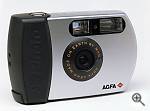 The ePhoto CL18 has 2 MB of internal memory and an optical resolution of 640 x 480 pixels. The camera offers industry-standard video format and can hold up to 32 VGA (640 x 480 pixels) images. The ePhoto CL18 has 2 MB of internal memory and an optical resolution of 640 x 480 pixels. The camera offers industry-standard video format and can hold up to 32 VGA (640 x 480 pixels) images.
Agfa includes Corel Print Office 2000, which incorporates Print Office 5, Corel Photo House 5 and ArcSoft VideoImpression, and Microsoft Net Meeting, in all ePhoto CL18 packages. Corel Photo House 5 is an image-editing application that allows users to touch up, enhance or alter an image before adding it to a document. With Corel Print Office 2000 users can create a range of items like photo greeting cards, invitations, illustrated documents or Web pages. ArcSoft VideoImpression is a video and image editing software program enabling users to animate, edit and create desktop video presentations using existing video and image files.
Using Agfa's image-enhancing PhotoGenie technology, the bundled Corel Photo House 2000 software can, claims Agfa, "remove image artifacts such as those from JPEG compression, pixelation, jagged edges and posterization, which can be common in some digitally captured images."
Source: Yahoo! Finance / Business Wire

Altamira Genuine Fractals bundled with Oly E-100RS!
By Michael Tomkins, The Imaging Resource
(Friday, September 1, 2000 - 16:20 EDT)
 Imaging software company Altamira has joined with Olympus America Inc. on the introduction of its Camedia E-100 RS (Rapid Shot) digital camera. Each E-100 RS, billed as the fastest digital camera on the market, will ship with Altamira's Genuine Fractals 2.0 software. Imaging software company Altamira has joined with Olympus America Inc. on the introduction of its Camedia E-100 RS (Rapid Shot) digital camera. Each E-100 RS, billed as the fastest digital camera on the market, will ship with Altamira's Genuine Fractals 2.0 software.
Altamira Genuine Fractals 2.0 is a plug-in for Adobe Photoshop that is targeted to graphics and photography professionals. With the Olympus E-100 RS, customers will receive a full version of Genuine Fractals for image scaling and manipulation. With Genuine Fractals, Altamira claims, photographers can "scale digital images to unprecedented sizes with effectively no loss in image quality or resolution. Images may also be reduced to compact files for more efficient file transportation and storage."
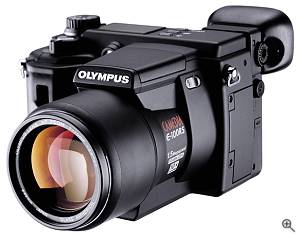
The Olympus E-100 RS is targeted at professional photojournalists and serious amateurs. It features multiple file compression formats, USB connectivity, automatic and manual exposures and a variety of shooting speeds up to 15 frames-per second. Additionally, the camera has QuickTime digital movie and sound capture capabilities in full VGA mode (640 x 480) at up to 30 fps."We are pleased to announce our bundle partnership with Olympus," said Sonja Palosaari, senior director of marketing for Altamira. "The technical innovations behind the Olympus E-100 and Altamira Genuine Fractals raises the bar for speed and quality in digital photography."
Source: Yahoo! Finance / Business Wire


AOL Alert: Several readers connecting
via AOL have complained of poor image quality when using the AOL web browser.
This is caused by a setting called "compress images" in the browser
that causes it to completely mangle images in the interest of faster transmission.
You should turn this setting OFF before viewing any of the comparison images
on this site.
- FLASH: Thanks to reader Lynn Mannan, here's an explanation of how to
make the correct settings adjustments (at least in AOL 4.0 for PCs):

- I opened the "My AOL" preferences screen
in the toolbar across the top. Then I clicked on WWW icon and selected
the "web graphics" tab where I unchecked the "compressed
graphics" choice and clicked on the Apply button at the bottom. Now
the scanner test pictures are gorgeous. The pictures take a long time to
load. But they are worth waiting for. Thank
you, Lynn!
|
 |
|